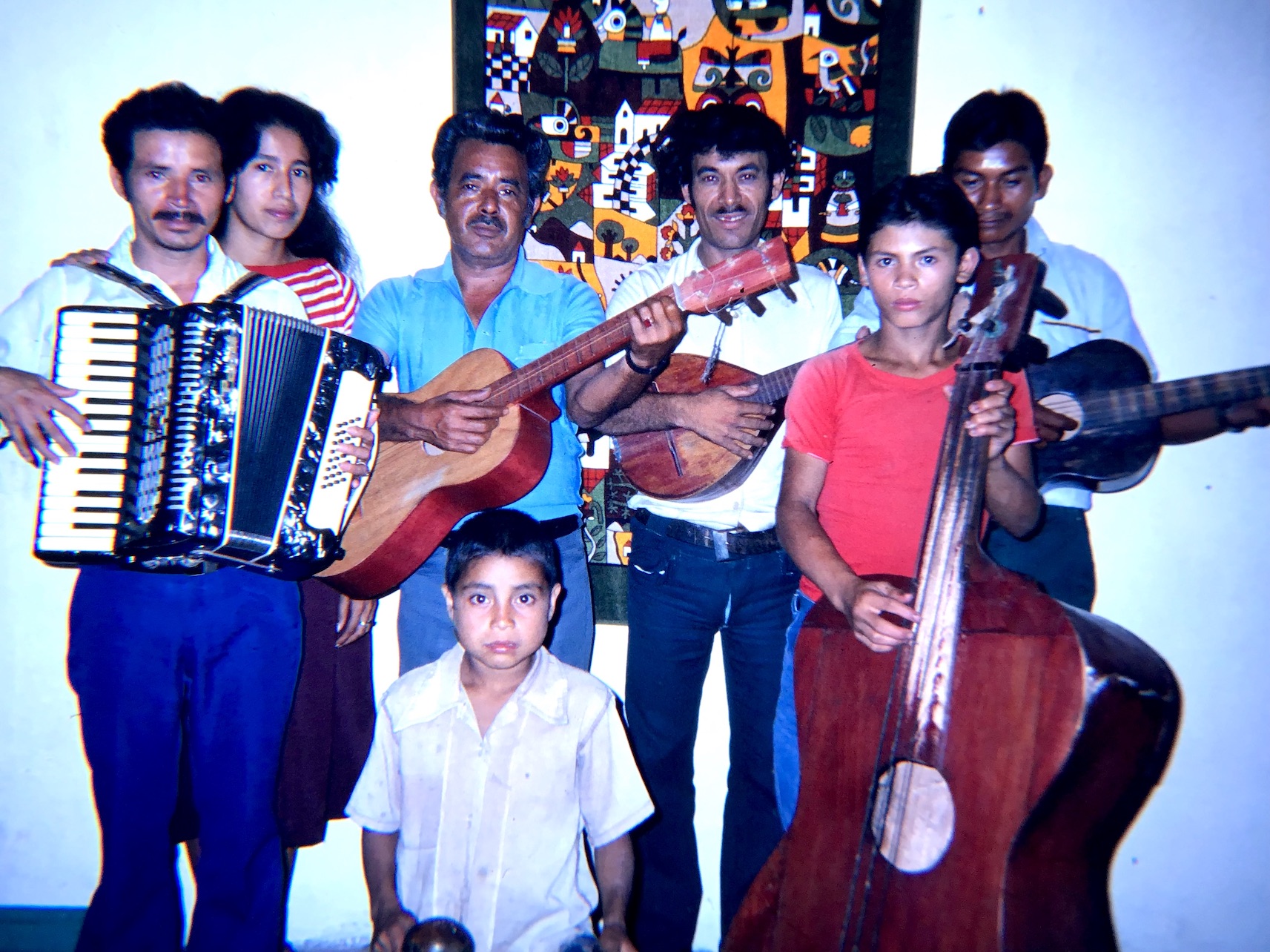
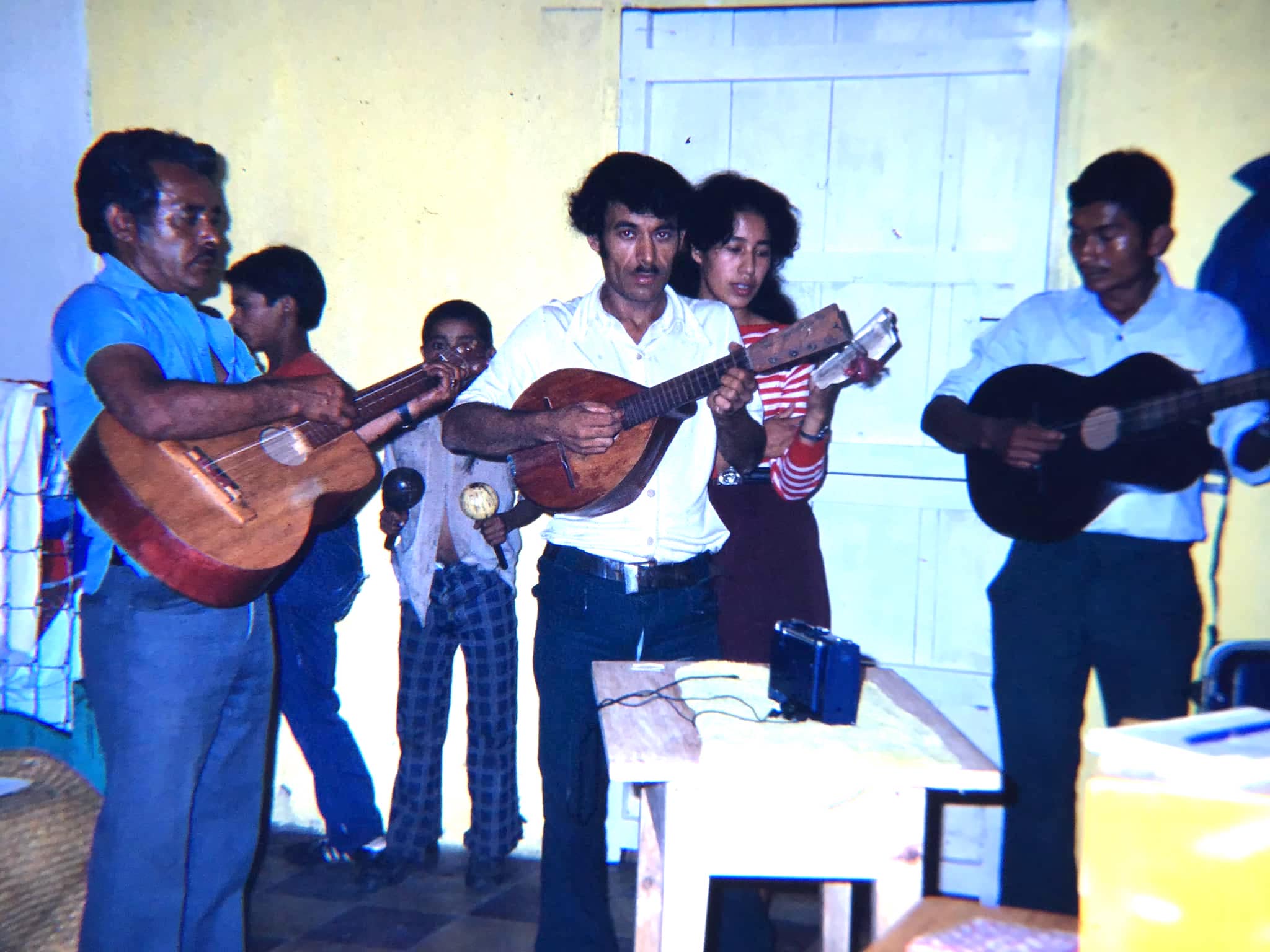
音楽
Music;
ミュージック;おんがく
Conjunto
musical religional, Dolores Copan, Honduras, ca. 1985; Caveza, Victot
Chavez
★ロラン・バルトによると音楽は2種類ある。(1)聴く音楽と、(2)自分で演奏する音楽(ムシカ・プラクティカ)である(バルト 1984:177)——もうひとつ、「聞く(entendre)は生理学的現象である。聴く(écouter)は心理学的行為である」(バルト 1984:155)
★ 最初、僕は「音楽(music)とは、形式、和声、旋律、リズム、またはその他の表現的な内容の何らかの組み合わせを作り出 すための音の配置である」と 書いた。しかし、クリストファー・スモール(Christopher Neville Charles Small, 1927-2011)さんの"Musicking : the meanings of performing and listening"という本に触れて、このような、人間性 ぬきの音楽の定義は間違っていると確信するにいたった。スモールさんは、音楽と人間が関わる以下のような画面をまず、列挙する。このことを 「音楽のあたらしい定義」と呼んでみてもいいだろう。
1) 大きなクラシックのコンサートホールがまさに始まろうとしている瞬間
2) スーパーマケットのなかで、無味乾燥な音が流れ、誰も関心をもたれないような状況
3) 爆音のような音が鳴り響く巨大なロックコンサート会場
4) イヤフォンやヘッドフォンをした若者があるいている——彼の耳からは外部からはわからないような音が流れているのだろう
5) ジャズの即興演奏がいまおわったサクソフォニストが汗をふいている。即興のパートはいま、ピアニストが引き継いでいる
6) 教会のオルガン奏者が賛美歌の一節をひきはじめると、会衆が歌い始めるが、そのユニゾンは不揃いである
7) 多数のパトリオットが起立している巨大なスタジアムで愛国歌がうたわれている
8) きらびやかな衣装を着たオペラ歌手が劇の途中で熱唱している。瀕死のヒロインを演じているが、公演がおわると、生き返ったかのように、聴衆のスタンディン グオベーションを受けている
9) 主婦が古いポピュラーソングをハミンングしながら朝のベッドメイクしている。彼女は、その歌詞をあいまいに歌っているが、まんざら嫌いではなさそうだ
★
以上のような情景描写(=引用者は、そこから想像して多少脚色をしている)をしたあと、音楽とはこういうものだと示す(=定義する);「これらのあまりに多種多様な状況と行為、それにサウンドを有意味に組織させるようなさまざまな
やり方のすべてが、音楽と名づけられている」(スモール
2023:18-19)。スモールさんは、音楽はモノではなく行為だと端的に指摘する;「音楽の本質とその根本的な意味とは、対象、すなわち音楽作品のなかにあるのではなく、人びとの
行為のなかにある」(スモール 2023:29)と。
☆ よって(再度引用する)陳腐化した過去の定義はこちらである→ 音楽(music)とは、形式、和声、旋律、リズム、またはその他の表現的な内容の何らかの組み合わせを作り出 すための音の配置である。音楽の定義は 文化によって異なるが、音楽はすべての人間社会の側面であり、文化的普遍である。 音楽の創作は一般的に作曲、即興、演奏に分けられるが、このテーマ自体は学問、批評、哲学、心理学、治療の文脈にまで及ぶ。音楽は、人間の声を含 む膨大な種類の楽器を用いて演奏されたり即興されたりすることがあり、そのためその極めて多様な創造性の機会がしばしば評価される。音楽を研究する方法や アプローチを「音楽理論」ないしは音楽理論研究とよぶ。世界の音楽の多様性を研究する 学問を「音楽人類学あるいは民族音楽学」という。
★ クリストファー・ネヴィル・チャールズ・スモール(Christopher Neville Charles Small、1927年3月17日 - 2011年9月7日)の紹介
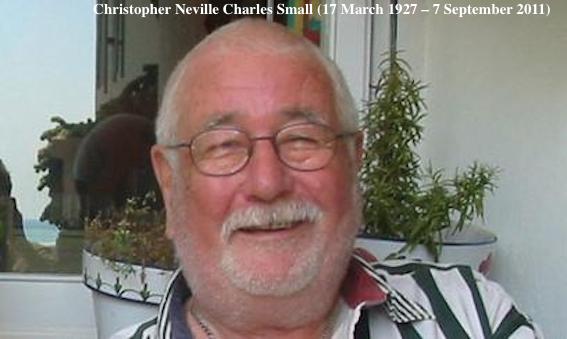 「ク
リストファー・ネヴィル・チャールズ・スモール(Christopher Neville Charles Small、1927年3月17日 -
2011年9月7日)は、ニュージーランド生まれの音楽家、教育者、講師であり、音楽学、社会音楽学、民族音楽学の分野で多くの影響力のある著書や論文の
著者である。彼は音楽を目的語(名詞)ではなく、過程(動詞)として強調するためにミュジッキングという言葉を作った。
スモールはニュージーランドのパーマストン・ノースで歯科医と元教師の間に生まれ、3人兄弟の末っ子だった。
初期の学校教育はテラス・エンド小学校とラッセル・ストリート小学校(1932-39年)、パーマストン・ノース・ボーイズ・ハイスクール(1940-
41年)、ワンガヌイ・カレッジ・スクール(1942-44年)で行われた。1945年から1952年までオタゴ大学、その後ビクトリア・ユニバーシ
ティー・カレッジに通う。1953年から1958年までホロウェヌア・カレッジで(同時にモロー・プロダクションズ社で教育用アニメーション映画の制作に
携わる)、1959年から1960年までワイヒ・カレッジで教鞭をとる。
1960年にはニュージーランド政府から奨学金を授与され、1961年にはイギリスを旅行し、その後ロンドンでプリオール・レーニエに作曲を師事、バー
ナード・ランズ、ルイジ・ノーノ、ヴィトルド・ルトスワフスキらとも交流した。留学後はイギリスに留まり、バーミンガムのアンスティ教育大学などで教鞭を
とった。1971年から86年までロンドンのイーリング高等教育カレッジで音楽の上級講師を務め、1979年にはダーティントン・カレッジ・オブ・アーツ
でも教鞭をとった。1977年から1986年にかけては、シラキュース大学ロンドンセンターで音楽史の非常勤教授を務め、1981年から1984年にかけ
ては、サセックス大学のBEdコースのサマースクールで音楽のチューターを務めた。
スモールは1986年に教職を退き、スペインのシッチェスに移り住み、2006年に結婚したパートナーのネヴィル・ブレイスウェイト(ジャマイカ生まれの
ダンサー、歌手、ユースワーカー)と暮らした。スペイン滞在中、スモールはカタルーニャの合唱団を指揮し、彼の作品を賞賛するヨーロッパとアメリカの人々
が定期的に訪れていた。アメリカでは、チャールズ・ケイル、ロバート・ウォルザー、スーザン・マクラリー、『ヴィレッジ・ヴォイス』誌のロック評論家ロ
バート・クリストガウといった著名な音楽学者たちが彼の考えを支持している[2]。
ネヴィル・ブレイスウェイトは2006年に、スモールは2011年に死去。妹のローズマリーがいる。
生前は多くの本を出版し、『Music in Education』、『Tempo』、『The Musical Times』、『Music and
Letters』、『Musical
America』などの雑誌に記事を掲載。イギリス、ノルウェー、アメリカの多くの教育機関で講義を行い、英国作曲家協会(1984年)、即興演奏家協会
(1985年)、音楽教育者全国会議(コネチカット州ハートフォード、1985年、ワシントンDC、1989年)、民族音楽学会(マサチューセッツ州ケン
ブリッジ、1988年)などの組織に論文を寄稿した」→「世界音楽化」より)
「ク
リストファー・ネヴィル・チャールズ・スモール(Christopher Neville Charles Small、1927年3月17日 -
2011年9月7日)は、ニュージーランド生まれの音楽家、教育者、講師であり、音楽学、社会音楽学、民族音楽学の分野で多くの影響力のある著書や論文の
著者である。彼は音楽を目的語(名詞)ではなく、過程(動詞)として強調するためにミュジッキングという言葉を作った。
スモールはニュージーランドのパーマストン・ノースで歯科医と元教師の間に生まれ、3人兄弟の末っ子だった。
初期の学校教育はテラス・エンド小学校とラッセル・ストリート小学校(1932-39年)、パーマストン・ノース・ボーイズ・ハイスクール(1940-
41年)、ワンガヌイ・カレッジ・スクール(1942-44年)で行われた。1945年から1952年までオタゴ大学、その後ビクトリア・ユニバーシ
ティー・カレッジに通う。1953年から1958年までホロウェヌア・カレッジで(同時にモロー・プロダクションズ社で教育用アニメーション映画の制作に
携わる)、1959年から1960年までワイヒ・カレッジで教鞭をとる。
1960年にはニュージーランド政府から奨学金を授与され、1961年にはイギリスを旅行し、その後ロンドンでプリオール・レーニエに作曲を師事、バー
ナード・ランズ、ルイジ・ノーノ、ヴィトルド・ルトスワフスキらとも交流した。留学後はイギリスに留まり、バーミンガムのアンスティ教育大学などで教鞭を
とった。1971年から86年までロンドンのイーリング高等教育カレッジで音楽の上級講師を務め、1979年にはダーティントン・カレッジ・オブ・アーツ
でも教鞭をとった。1977年から1986年にかけては、シラキュース大学ロンドンセンターで音楽史の非常勤教授を務め、1981年から1984年にかけ
ては、サセックス大学のBEdコースのサマースクールで音楽のチューターを務めた。
スモールは1986年に教職を退き、スペインのシッチェスに移り住み、2006年に結婚したパートナーのネヴィル・ブレイスウェイト(ジャマイカ生まれの
ダンサー、歌手、ユースワーカー)と暮らした。スペイン滞在中、スモールはカタルーニャの合唱団を指揮し、彼の作品を賞賛するヨーロッパとアメリカの人々
が定期的に訪れていた。アメリカでは、チャールズ・ケイル、ロバート・ウォルザー、スーザン・マクラリー、『ヴィレッジ・ヴォイス』誌のロック評論家ロ
バート・クリストガウといった著名な音楽学者たちが彼の考えを支持している[2]。
ネヴィル・ブレイスウェイトは2006年に、スモールは2011年に死去。妹のローズマリーがいる。
生前は多くの本を出版し、『Music in Education』、『Tempo』、『The Musical Times』、『Music and
Letters』、『Musical
America』などの雑誌に記事を掲載。イギリス、ノルウェー、アメリカの多くの教育機関で講義を行い、英国作曲家協会(1984年)、即興演奏家協会
(1985年)、音楽教育者全国会議(コネチカット州ハートフォード、1985年、ワシントンDC、1989年)、民族音楽学会(マサチューセッツ州ケン
ブリッジ、1988年)などの組織に論文を寄稿した」→「世界音楽化」より)
| ★音楽人類学・民族音楽学▶︎音楽と感情▶音楽・身 体・芸術︎︎▶いわゆる「食いつき力」について︎▶︎︎音楽と時間性▶音楽の文化研究︎▶︎︎ポリフォニー▶︎聴覚のチーズケーキとしての音楽▶プエルトリコの音楽▶︎マヤ・マリンバ音楽用語集▶サルサ音楽の歴史︎︎▶︎世 界音楽化▶ピタゴラスと音楽︎︎▶︎音楽とナショナリズム▶コール&レスポンス︎︎▶︎進化音楽学▶ラップ音楽 ︎︎▶︎宗教と音楽性▶︎︎北米のフォーク・ミュージック・アンソロジー▶︎音楽美学批判▶日本におけるキリスト教布教と西洋音楽の導入︎︎▶︎プエルトリコの抵抗の音▶︎︎▶︎ラップ音楽・黒人アイデンティティ・身体経験▶︎︎クレズマー音楽▶︎ラッ プ音楽におけるミソジニー▶︎︎メレンゲ音楽▶︎ガリフナの人と音楽経験▶︎︎歌うネアンデルタールとスティヴン・ミズン▶︎ニーチェと音楽▶ポストヴァナキュラーな音楽としてのクレズマー︎︎▶︎君もラッパーになれる!!▶︎︎ギャングス タ・ラップからナルコ・コリードまで▶︎▶︎記 憶=記録の悪魔▶キリスト教のカントール︎︎▶︎ラテン・ヒップ・ポップ▶レゲトンとデムボウ︎︎▶︎ミュージコフィリア▶▶︎キングヘロイン▶音響的な世界︎︎▶︎︎︎▶︎ワールドミュージックとグローバリゼーション▶︎︎▶︎▶︎▶︎︎▶︎▶︎︎▶︎▶︎︎▶︎▶︎︎▶︎▶︎ | ︎☆マーレー・シェイファーとサウンドスケープ▶︎ルベン・ブラデス▶︎︎ラ
ファエル・トルヒージョと『チボの祝宴』︎︎▶▶︎︎カート・コバーンとその生涯▶︎ドミートリイ・ショスタコーヴィチ▶セリア・クルス︎▶︎エクトル・ラ
ボ▶カノ・エストレメーラ︎▶︎︎皆川達夫の研究▶グレン・グールド▶︎︎ロバート・ラッハマン︎▶︎︎オリヴァー・サックス▶︎ピタゴラスと音楽▶︎︎▶︎▶︎︎▶︎▶︎︎▶︎▶︎︎▶︎▶︎︎▶︎▶︎︎▶︎▶︎ |
| ︎︎☆カンティガス・デ・サンタ・マリア▶︎セギディージャ▶︎︎カンティーガ▶︎中世音楽▶イベリア世界の宗教音楽︎︎▶先史時代からアルアンダルスからレコンキスタまで︎▶スペインの音楽▶︎︎ヴィリャンシーコ資料集▶ヴィリャンシーコ︎▶︎︎▶︎▶︎︎▶︎▶︎ |
Grooved
side of the Voyager Golden Record launched along the Voyager probes to
space, which feature music from around the world.
ボイジャー探査機とともに宇宙へ打ち上げられたゴールデンレコードの溝付き側面には、世界中の音楽が収録されている。
| In
the most general of terms, music
is the arrangement of sound to create some combination of form,
harmony, melody, rhythm, or otherwise expressive content.[1][2][3]
Definitions of music vary depending on culture,[4] though it is an
aspect of all human societies and a cultural universal.[5] While
scholars agree that music is defined by a few specific elements, there
is no consensus on their precise definitions.[6] The creation of music
is commonly divided into musical composition, musical improvisation,
and musical performance,[7] though the topic itself extends into
academic disciplines, criticism, philosophy, psychology, and
therapeutic contexts. Music may be performed or improvised using a vast
range of instruments, including the human voice, and thus is often
credited for its extreme versatility and opportunity for creativity.[8] In some musical contexts, a performance or composition may be to some extent improvised. For instance, in Hindustani classical music, the performer plays spontaneously while following a partially defined structure and using characteristic motifs. In modal jazz, the performers may take turns leading and responding while sharing a changing set of notes. In a free jazz context, there may be no structure whatsoever, with each performer acting at their discretion. Music may be deliberately composed to be unperformable or agglomerated electronically from many performances. Music is played in public and private areas, highlighted at events such as festivals, rock concerts, and orchestra performances, and heard incidentally as part of a score or soundtrack to a film, TV show, opera, or video game. Musical playback is the primary function of an MP3 player or CD player, and a universal feature of radios and smartphones. Music often plays a key role in social activities, religious rituals, rite of passage ceremonies, celebrations, and cultural activities. The music industry includes songwriters, performers, sound engineers, producers, tour organizers, distributors of instruments, accessories, and sheet music. Compositions, performances, and recordings are assessed and evaluated by music critics, music journalists, and music scholars, as well as amateurs. |
最も一般的な用語では、音楽(music)
とは、形式、和声、旋律、リズム、またはその他の表現的な内容の何らかの組み合わせを作り出すための音の配置である[1][2][3][→音楽理論]。音楽の定義は文化
によって異なるが[4]、音楽はすべての人間社会の側面であり、文化的普遍である[5]。
[音楽の創作は一般的に作曲、即興、演奏に分けられるが[7]、このテーマ自体は学問、批評、哲学、心理学、治療の文脈にまで及ぶ。音楽は、人間の声を含
む膨大な種類の楽器を用いて演奏されたり即興されたりすることがあり、そのためその極めて多様な創造性の機会がしばしば評価される[8]。 音楽の文脈によっては、演奏や作曲がある程度即興で行われることもある。例えば、ヒンドゥスターニー古典音楽では、演奏者は部分的に定義された構造に従 い、特徴的なモチーフを用いながら自発的に演奏する。モーダル・ジャズでは、演奏者が交代でリードしたり反応したりしながら、変化する音符のセットを共有 することがある。フリー・ジャズでは、構成は一切なく、各演奏者が自由に演奏する。音楽は、演奏不可能なように意図的に作曲されることもあれば、多くの演 奏から電子的に集積されることもある。音楽は公共の場やプライベートな場所で演奏され、フェスティバル、ロックコンサート、オーケストラの演奏などのイベ ントで脚光を浴び、映画、テレビ番組、オペラ、ビデオゲームのスコアやサウンドトラックの一部として付随的に聴かれる。音楽再生はMP3プレーヤーやCD プレーヤーの主な機能であり、ラジオやスマートフォンの普遍的な機能でもある。 音楽は社会活動、宗教儀式、通過儀礼、祝典、文化活動において重要な役割を果たすことが多い。音楽産業には、作詞作曲家、演奏家、サウンドエンジニア、プ ロデューサー、ツアー主催者、楽器、アクセサリー、楽譜の流通業者などが含まれる。作曲、演奏、録音は、アマチュアだけでなく、音楽評論家、音楽ジャーナ リスト、音楽学者によっても評価・査定される。 |
Etymology and terminology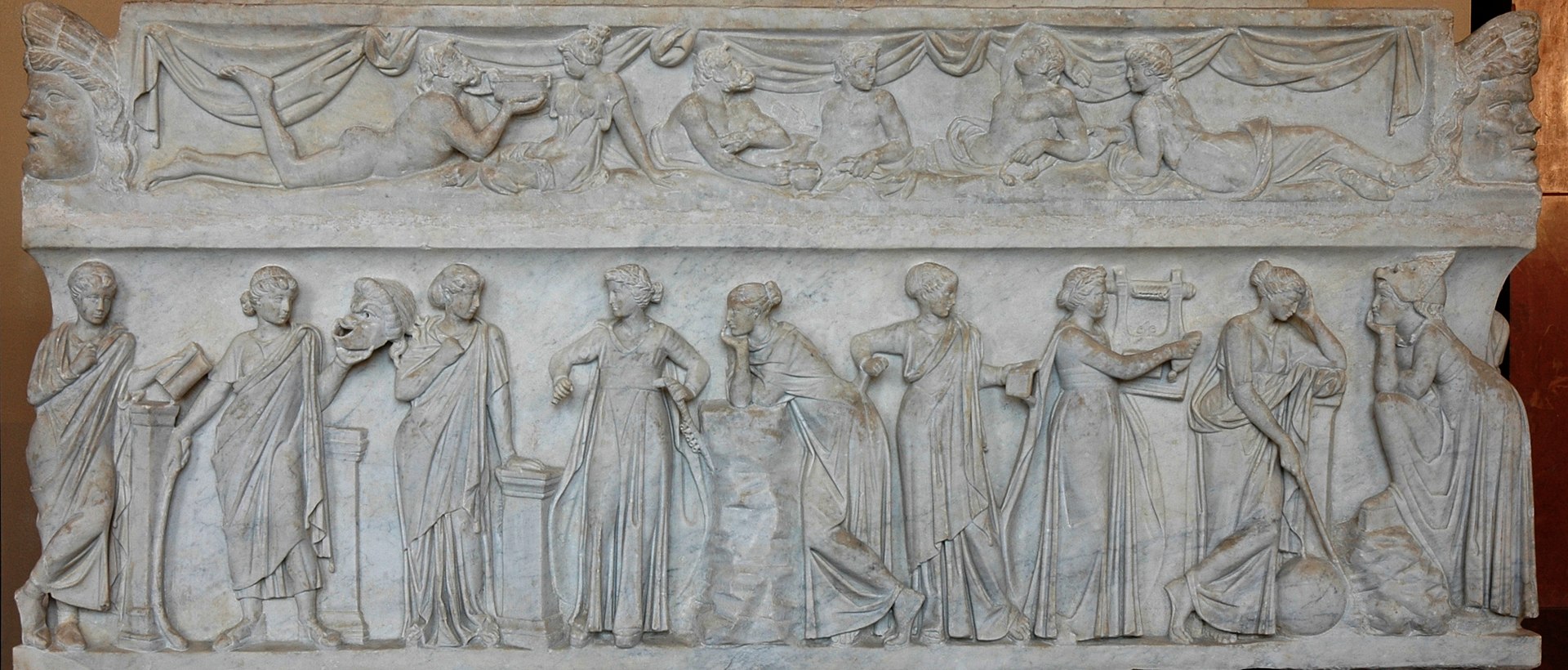 In Greek mythology, the nine Muses were the inspiration for many creative endeavors, including the arts, and eventually became closely aligned with music specifically. The modern English word 'music' came into use in the 1630s.[9] It is derived from a long line of successive precursors: the Old English 'musike' of the mid-13th century; the Old French musique of the 12th century; and the Latin mūsica.[10][8][n 1] The Latin word itself derives from the Ancient Greek mousiké (technē)—μουσική (τέχνη)—literally meaning "(art) of the Muses".[10][n 2] The Muses were nine deities in Ancient Greek mythology who presided over the arts and sciences.[13][14] They were included in tales by the earliest Western authors, Homer and Hesiod,[15] and eventually came to be associated with music specifically.[14] Over time, Polyhymnia would reside over music more prominently than the other muses.[11] The Latin word musica was also the originator for both the Spanish música and French musique via spelling and linguistic adjustment, though other European terms were probably loanwords, including the Italian musica, German Musik, Dutch muziek, Norwegian musikk, Polish muzyka and Russian muzïka.[14] The modern Western world usually defines music as an all-encompassing term used to describe diverse genres, styles, and traditions.[16] This is not the case worldwide, and languages such as modern Indonesian (musik) and Shona (musakazo) have recently adopted words to reflect this universal conception, as they did not have words that fit exactly the Western scope.[14] Before Western contact in East Asia, neither Japan nor China had a single word that encompasses music in a broad sense, but culturally, they often regarded music in such a fashion.[17] The closest word to mean music in Chinese, yue, shares a character with le, meaning joy, and originally referred to all the arts before narrowing in meaning.[17] Africa is too diverse to make firm generalizations, but the musicologist J. H. Kwabena Nketia has emphasized African music's often inseparable connection to dance and speech in general.[18] Some African cultures, such as the Songye people of the Democratic Republic of the Congo and the Tiv people of Nigeria, have a strong and broad conception of 'music' but no corresponding word in their native languages.[18] Other words commonly translated as 'music' often have more specific meanings in their respective cultures: the Hindi word for music, sangita, properly refers to art music,[19] while the many Indigenous languages of the Americas have words for music that refer specifically to song but describe instrumental music regardless.[20] Though the Arabic musiqi can refer to all music, it is usually used for instrumental and metric music, while khandan identifies vocal and improvised music.[21] |
語源と用語 ギリシャ神話では、9人のミューズが芸術を含む多くの創造的な活動のインスピレーションを与え、最終的には特に音楽と密接に結びついた。 現代英語の「music」は1630年代に使用されるようになった[9]。この語は、13世紀半ばの古英語の「musike」、12世紀の古フランス語の 「musique」、ラテン語の「mūsica」という長い前身に由来する。 [10][8][n1]ラテン語自体は古代ギリシア語のmousiké(technē)-μουσική(τέχνη)に由来し、文字通り「ミューズの (芸術)」を意味する[10][n2]。 ミューズは古代ギリシア神話に登場する9人の神で、芸術と科学を司った。 [13][14]彼らは西洋最古の作家であるホメロスやヘシオドスの物語に登場し[15]、やがて特に音楽と結び付けられるようになった。 [11]ラテン語のmusicaは、綴りや言語的な調整を経て、スペイン語のmúsicaとフランス語のmusiqueの語源にもなったが、他のヨーロッ パの言葉はおそらく借用語であり、イタリア語のmusica、ドイツ語のmusik、オランダ語のmuziek、ノルウェー語のmusikk、ポーランド 語のmuzyka、ロシア語のmuzïkaなどがある[14]。 現代の西洋世界は通常、音楽を多様なジャンル、スタイル、伝統を表現するために使われる包括的な用語として定義している[16]。 これは世界的にそうではなく、現代のインドネシア語(musik)やショナ語(musakazo)のような言語は、西洋の範囲にぴったり合う単語を持って いなかったため、この普遍的な概念を反映する単語を最近採用した。 [14]。東アジアで西洋と接触する以前は、日本も中国も広義に音楽を包括する単一の単語を持っていなかったが、文化的には音楽をそのように捉えることが 多かった[17]。中国語で音楽を意味する最も近い単語であるyueは、喜びを意味するleと字を共有しており、元々はすべての芸術を指していたが、意味 が狭まった[17]。コンゴ民主共和国のソンイェ族やナイジェリアのティヴ族など、アフリカの文化の中には「音楽」という強く広い概念を持っていながら、 彼らの母国語にはそれに対応する言葉がないものもある[18]。 [18]その他、一般的に「音楽」と訳される単語は、それぞれの文化においてより具体的な意味を持つことが多い。ヒンディー語で音楽を意味するサンギータ は、正しくは芸術音楽を指す[19]。一方、アメリカ大陸の多くの先住民の言語には、特に歌を指す音楽の単語があるが、それとは関係なく器楽音楽を表す [20]。アラビア語のmusiqiはすべての音楽を指すことができるが、通常は器楽音楽と計量音楽に使用され、khandanは声楽と即興音楽を指す [21]。 |
| History Main article: History of music Origins and prehistory Further information: Origins of music and Prehistoric music 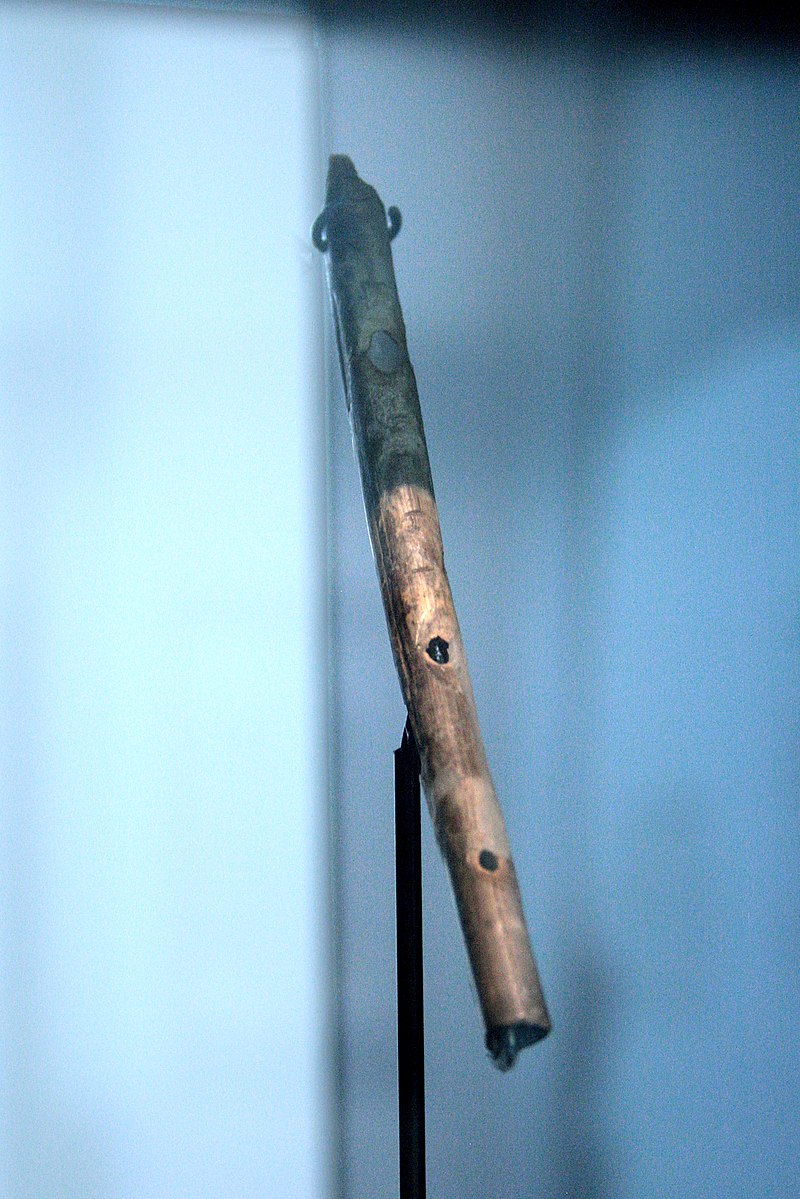 Bone flute from Geissenklösterle, Germany, dated around c. 43,150–39,370 BP.[22] B_1431 Sha-Amun-en-su, Egyptian singer.[23] It is often debated to what extent the origins of music will ever be understood,[24] and there are competing theories that aim to explain it.[25] Many scholars highlight a relationship between the origin of music and the origin of language, and there is disagreement surrounding whether music developed before, after, or simultaneously with language.[26] A similar source of contention surrounds whether music was the intentional result of natural selection or was a byproduct spandrel of evolution.[26] The earliest influential theory was proposed by Charles Darwin in 1871, who stated that music arose as a form of sexual selection, perhaps via mating calls.[27] Darwin's original perspective has been heavily criticized for its inconsistencies with other sexual selection methods,[28] though many scholars in the 21st century have developed and promoted the theory.[29] Other theories include that music arose to assist in organizing labor, improving long-distance communication, benefiting communication with the divine, assisting in community cohesion or as a defense to scare off predators.[30] Prehistoric music can only be theorized based on findings from paleolithic archaeology sites. The Divje Babe flute, carved from a cave bear femur, is thought to be at least 40,000 years old, though there is considerable debate surrounding whether it is truly a musical instrument or an object formed by animals.[31] The earliest objects whose designations as musical instruments are widely accepted are bone flutes from the Swabian Jura, Germany, namely from the Geissenklösterle, Hohle Fels and Vogelherd caves.[32] Dated to the Aurignacian (of the Upper Paleolithic) and used by Early European modern humans, from all three caves there are eight examples, four made from the wing bones of birds and four from mammoth ivory; three of these are near complete.[32] Three flutes from the Geissenklösterle are dated as the oldest, c. 43,150–39,370 BP.[22][n 3] Antiquity Main article: Ancient music The earliest material and representational evidence of Egyptian musical instruments dates to the Predynastic period, but the evidence is more securely attested in the Old Kingdom when harps, flutes and double clarinets were played.[33] Percussion instruments, lyres, and lutes were added to orchestras by the Middle Kingdom. Cymbals[34] frequently accompanied music and dance, much as they still do in Egypt today. Egyptian folk music, including the traditional Sufi dhikr rituals, are the closest contemporary music genre to ancient Egyptian music, having preserved many of its features, rhythms and instruments.[35][36] The "Hurrian Hymn to Nikkal", found on clay tablets in the ancient Syrian city of Ugarit, is the oldest surviving notated work of music, dating back to approximately 1400 BCE.[37][38] Music was an important part of social and cultural life in ancient Greece, in fact it was one of the main subjects taught to children. Musical education was considered to be important for the development of an individual's soul. Musicians and singers played a prominent role in Greek theater,[39] and those who received a musical education were seen as nobles and in perfect harmony (as can be read in the Republic, Plato). Mixed gender choruses performed for entertainment, celebration, and spiritual ceremonies.[40] Instruments included the double-reed aulos and a plucked string instrument, the lyre, principally a special kind called a kithara. Music was an important part of education, and boys were taught music starting at age six. Greek musical literacy created significant musical development. Greek music theory included the Greek musical modes, that eventually became the basis for Western religious and classical music. Later, influences from the Roman Empire, Eastern Europe, and the Byzantine Empire changed Greek music. The Seikilos epitaph is the oldest surviving example of a complete musical composition, including musical notation, from anywhere in the world.[41] The oldest surviving work written on the subject of music theory is Harmonika Stoicheia by Aristoxenus.[42] Asian cultures Main article: Music of Asia Asian music covers a swath of music cultures surveyed in the articles on Arabia, Central Asia, East Asia, South Asia, and Southeast Asia. Several have traditions reaching into antiquity. 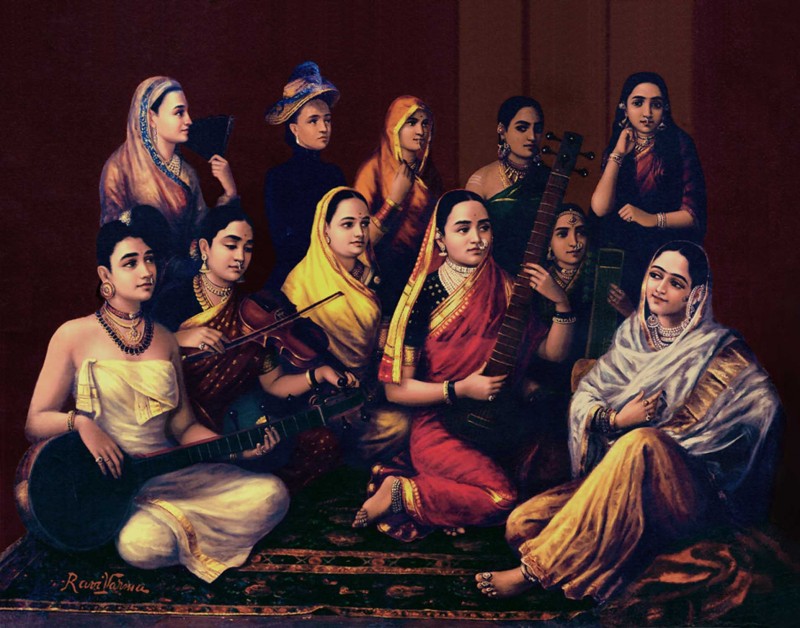 Indian women dressed in regional attire playing a variety of musical instruments popular in different parts of India Indian classical music is one of the oldest musical traditions in the world.[43] Sculptures from the Indus Valley civilization show dance[44] and old musical instruments, like the seven-holed flute. Stringed instruments and drums have been recovered from Harappa and Mohenjo Daro by excavations carried out by Mortimer Wheeler.[45] The Rigveda, an ancient Hindu text, has elements of present Indian music, with musical notation to denote the meter and mode of chanting.[46] Indian classical music (marga) is monophonic, and based on a single melody line or raga rhythmically organized through talas. The poem Cilappatikaram provides information about how new scales can be formed by modal shifting of the tonic from an existing scale.[47] Present day Hindi music was influenced by Persian traditional music and Afghan Mughals. Carnatic music, popular in the southern states, is largely devotional; the majority of the songs are addressed to the Hindu deities. There are songs emphasizing love and other social issues. 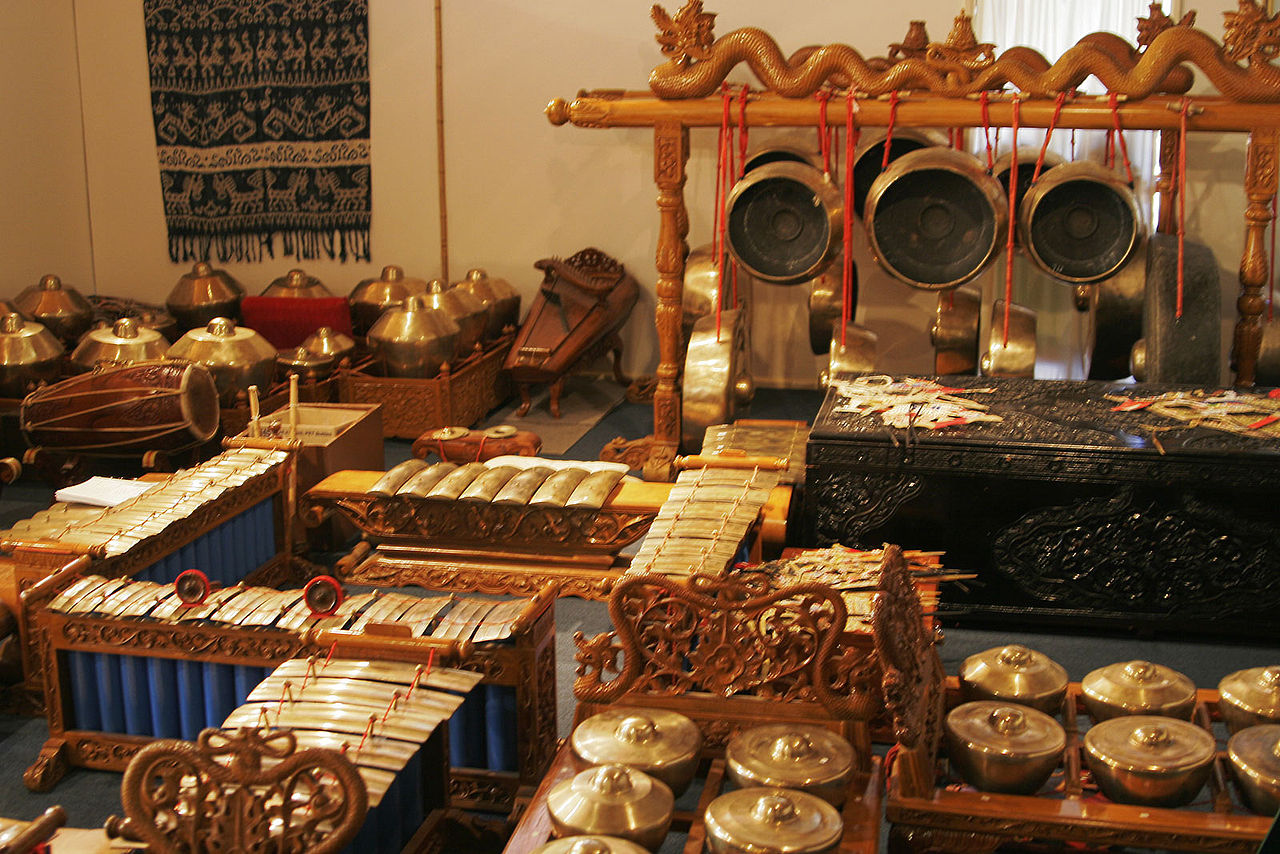 Indonesia is the home of gong chime, there are variants across Indonesia, especially in Java and Bali. Indonesian music has been formed since the Bronze Age culture migrated to the Indonesian archipelago in the 2nd-3rd centuries BCE. Indonesian traditional music uses percussion instruments, especially kendang and gongs. Some of them developed elaborate and distinctive instruments, such as the sasando stringed instrument on the island of Rote, the Sundanese angklung, and the complex and sophisticated Javanese and Balinese gamelan orchestras. Indonesia is the home of gong chime, a general term for a set of small, high pitched pot gongs. Gongs are usually placed in order of note, with the boss up on a string held in a low wooden frame. The most popular form of Indonesian music is gamelan, an ensemble of tuned percussion instruments that include metallophones, drums, gongs and spike fiddles along with bamboo suling (like a flute).[48][49] Chinese classical music, the traditional art or court music of China, has a history stretching over about 3,000 years. It has its own unique systems of musical notation, as well as musical tuning and pitch, musical instruments and styles or genres. Chinese music is pentatonic-diatonic, having a scale of twelve notes to an octave (5 + 7 = 12) as does European-influenced music.[50] Western classical Main article: Classical music Early music Breves dies hominis Duration: 3 minutes and 32 seconds.3:32 by Léonin or Pérotin Problems playing this file? See media help. 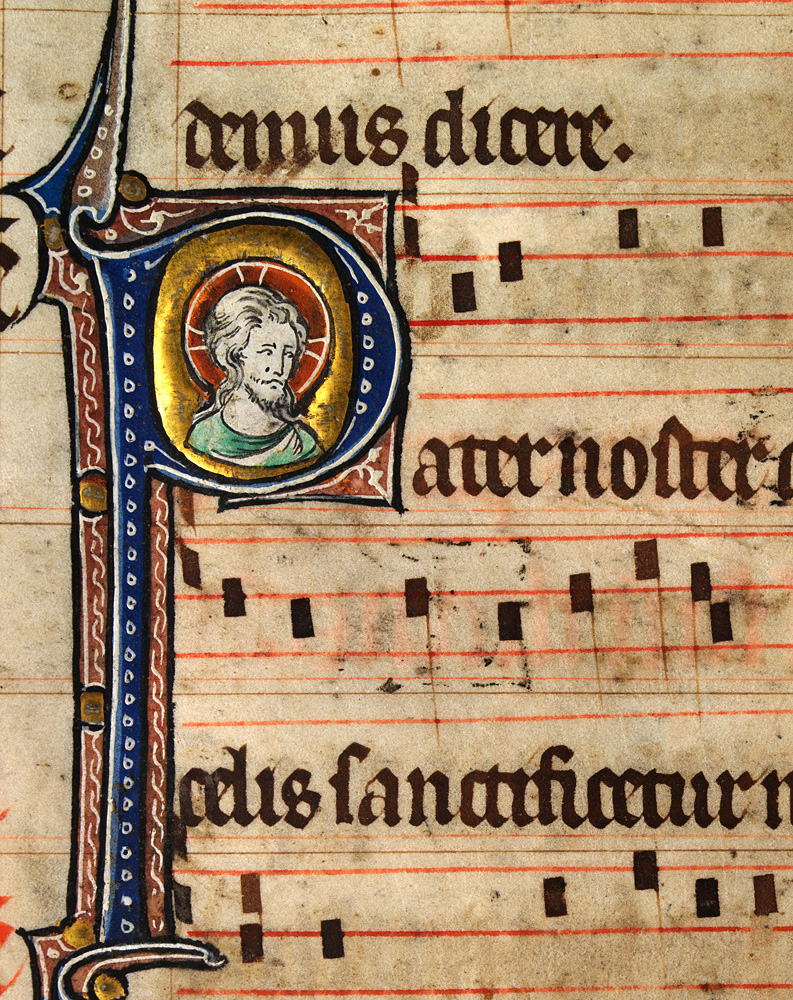 Musical notation from a Catholic Missal, c. 1310–1320 The medieval music era (500 to 1400), which took place during the Middle Ages, started with the introduction of monophonic (single melodic line) chanting into Catholic Church services. Musical notation was used since ancient times in Greek culture, but in the Middle Ages, notation was first introduced by the Catholic Church, so chant melodies could be written down, to facilitate the use of the same melodies for religious music across the Catholic empire. The only European Medieval repertory that has been found, in written form, from before 800 is the monophonic liturgical plainsong chant of the Catholic Church, the central tradition of which was called Gregorian chant. Alongside these traditions of sacred and church music there existed a vibrant tradition of secular song (non-religious songs). Examples of composers from this period are Léonin, Pérotin, Guillaume de Machaut, and Walther von der Vogelweide.[51][52][53][54] Renaissance music (c. 1400 to 1600) was more focused on secular themes, such as courtly love. Around 1450, the printing press was invented, which made printed sheet music much less expensive and easier to mass-produce (prior to the invention of the press, all notated music was hand-copied). The increased availability of sheet music spread musical styles quicker and across a larger area. Musicians and singers often worked for the church, courts and towns. Church choirs grew in size, and the church remained an important patron of music. By the middle of the 15th century, composers wrote richly polyphonic sacred music, in which different melody lines were interwoven simultaneously. Prominent composers from this era include Guillaume Du Fay, Giovanni Pierluigi da Palestrina, Thomas Morley, Orlando di Lasso and Josquin des Prez. As musical activity shifted from the church to aristocratic courts, kings, queens and princes competed for the finest composers. Many leading composers came from the Netherlands, Belgium, and France; they are called the Franco-Flemish composers.[55] They held important positions throughout Europe, especially in Italy. Other countries with vibrant musical activity included Germany, England, and Spain. Common practice period Baroque Main article: Baroque music Toccata and Fugue in D minor, BWV 5 Duration: 8 minutes and 34 seconds.8:34 Toccata and Fugue by J.S. Bach 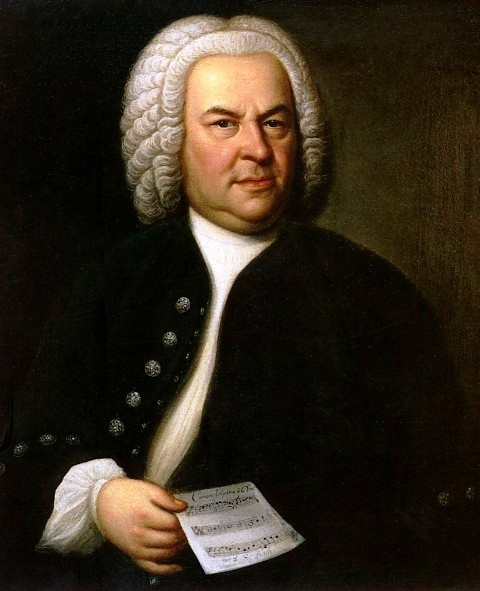 The Baroque era of music took place from 1600 to 1750, as the Baroque artistic style flourished across Europe; and during this time, music expanded in its range and complexity. Baroque music began when the first operas (dramatic solo vocal music accompanied by orchestra) were written. During the Baroque era, polyphonic contrapuntal music, in which multiple, simultaneous independent melody lines were used, remained important (counterpoint was important in the vocal music of the Medieval era). German Baroque composers wrote for small ensembles including strings, brass, and woodwinds, as well as for choirs and keyboard instruments such as pipe organ, harpsichord, and clavichord. During this period several major music forms were defined that lasted into later periods when they were expanded and evolved further, including the fugue, the invention, the sonata, and the concerto.[56] The late Baroque style was polyphonically complex and richly ornamented. Important composers from the Baroque era include Johann Sebastian Bach (Cello suites), George Frideric Handel (Messiah), Georg Philipp Telemann and Antonio Vivaldi (The Four Seasons). Classicism Main article: Classical period (music) Symphony No. 40 G minor Duration: 8 minutes and 14 seconds.8:14 Symphony 40 G minor by W.A. Mozart Problems playing this file? See media help. 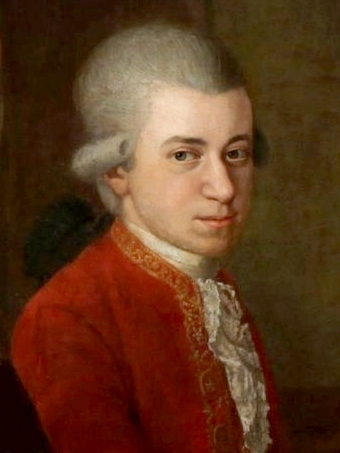 Wolfgang Amadeus Mozart was a prolific and influential composer of the Classical period. The music of the Classical period (1730 to 1820) aimed to imitate what were seen as the key elements of the art and philosophy of Ancient Greece and Rome: the ideals of balance, proportion and disciplined expression. (Note: the music from the Classical period should not be confused with Classical music in general, a term which refers to Western art music from the 5th century to the 2000s, which includes the Classical period as one of a number of periods). Music from the Classical period has a lighter, clearer and considerably simpler texture than the Baroque music which preceded it. The main style was homophony,[57] where a prominent melody and a subordinate chordal accompaniment part are clearly distinct. Classical instrumental melodies tended to be almost voicelike and singable. New genres were developed, and the fortepiano, the forerunner to the modern piano, replaced the Baroque era harpsichord and pipe organ as the main keyboard instrument (though pipe organ continued to be used in sacred music, such as Masses). Importance was given to instrumental music. It was dominated by further development of musical forms initially defined in the Baroque period: the sonata, the concerto, and the symphony. Other main kinds were the trio, string quartet, serenade and divertimento. The sonata was the most important and developed form. Although Baroque composers also wrote sonatas, the Classical style of sonata is completely distinct. All of the main instrumental forms of the Classical era, from string quartets to symphonies and concertos, were based on the structure of the sonata. The instruments used chamber music and orchestra became more standardized. In place of the basso continuo group of the Baroque era, which consisted of harpsichord, organ or lute along with a number of bass instruments selected at the discretion of the group leader (e.g., viol, cello, theorbo, serpent), Classical chamber groups used specified, standardized instruments (e.g., a string quartet would be performed by two violins, a viola and a cello). The practice of improvised chord-playing by the continuo keyboardist or lute player, a hallmark of Baroque music, underwent a gradual decline between 1750-1800.[58] One of the most important changes made in the Classical period was the development of public concerts. The aristocracy still played a significant role in the sponsorship of concerts and compositions, but it was now possible for composers to survive without being permanent employees of queens or princes. The increasing popularity of classical music led to a growth in the number and types of orchestras. The expansion of orchestral concerts necessitated the building of large public performance spaces. Symphonic music including symphonies, musical accompaniment to ballet and mixed vocal/instrumental genres, such as opera and oratorio, became more popular.[59][60][61] The best known composers of Classicism are Carl Philipp Emanuel Bach, Christoph Willibald Gluck, Johann Christian Bach, Joseph Haydn, Wolfgang Amadeus Mozart, Ludwig van Beethoven and Franz Schubert. Beethoven and Schubert are also considered to be composers in the later part of the Classical era, as it began to move towards Romanticism. Romanticism Main article: Romantic music Die Walküre Duration: 27 minutes and 57 seconds.27:57 Die Walküre by Richard Wagner Problems playing this file? See media help. 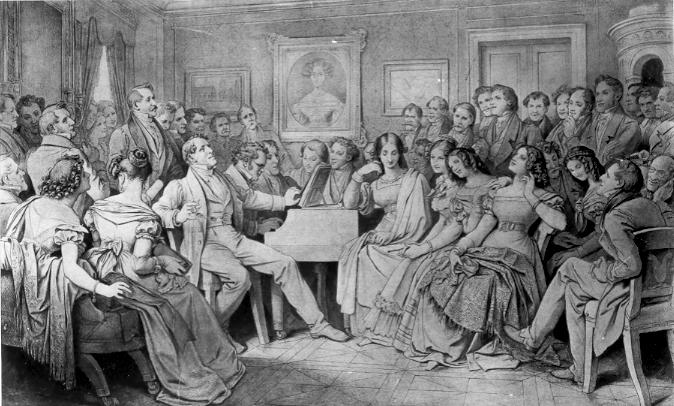 The piano was the centrepiece of social activity for middle-class urbanites in the 19th century (Moritz von Schwind, 1868). The man at the piano is composer Franz Schubert. Romantic music (c. 1820 to 1900) from the 19th century had many elements in common with the Romantic styles in literature and painting of the era. Romanticism was an artistic, literary, and intellectual movement was characterized by its emphasis on emotion and individualism as well as glorification of all the past and nature. Romantic music expanded beyond the rigid styles and forms of the Classical era into more passionate, dramatic expressive pieces and songs. Romantic composers such as Wagner and Brahms attempted to increase emotional expression and power in their music to describe deeper truths or human feelings. With symphonic tone poems, composers tried to tell stories and evoke images or landscapes using instrumental music. Some composers promoted nationalistic pride with patriotic orchestral music inspired by folk music. The emotional and expressive qualities of music came to take precedence over tradition.[62] Romantic composers grew in idiosyncrasy, and went further in the syncretism of exploring different art-forms in a musical context, (such as literature), history (historical figures and legends), or nature itself. Romantic love or longing was a prevalent theme in many works composed during this period. In some cases, the formal structures from the classical period continued to be used (e.g., the sonata form used in string quartets and symphonies), but these forms were expanded and altered. In many cases, new approaches were explored for existing genres, forms, and functions. Also, new forms were created that were deemed better suited to the new subject matter. Composers continued to develop opera and ballet music, exploring new styles and themes.[39] In the years after 1800, the music developed by Ludwig van Beethoven and Franz Schubert introduced a more dramatic, expressive style. In Beethoven's case, short motifs, developed organically, came to replace melody as the most significant compositional unit (an example is the distinctive four note figure used in his Fifth Symphony). Later Romantic composers such as Pyotr Ilyich Tchaikovsky, Antonín Dvořák, and Gustav Mahler used more unusual chords and more dissonance to create dramatic tension. They generated complex and often much longer musical works. During the late Romantic period, composers explored dramatic chromatic alterations of tonality, such as extended chords and altered chords, which created new sound "colors." The late 19th century saw a dramatic expansion in the size of the orchestra, and the industrial revolution helped to create better instruments, creating a more powerful sound. Public concerts became an important part of well-to-do urban society. It also saw a new diversity in theatre music, including operetta, and musical comedy and other forms of musical theatre.[39] 20th and 21st century Main article: 20th-century music 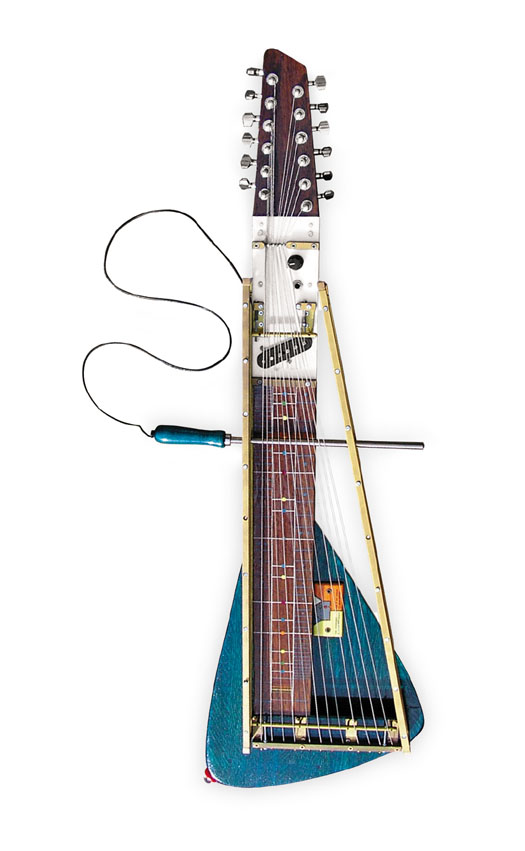 Landman's 2006 Moodswinger, a 3rd-bridged overtone zither and an example of experimental musical instruments In the 19th century, a key way new compositions became known to the public, was by the sales of sheet music, which middle class amateur music lovers would perform at home, on their piano or other common instruments, such as the violin. With 20th-century music, the invention of new electric technologies such as radio broadcasting and mass market availability of gramophone records meant sound recordings heard by listeners (on the radio or record player), became the main way to learn about new songs and pieces.[63] There was a vast increase in music listening as the radio gained popularity and phonographs were used to replay and distribute music, anyone with a radio or record player could hear operas, symphonies and big bands in their own living room. During the 19th century, the focus on sheet music had restricted access to new music to middle and upper-class people who could read music and who owned pianos and other instruments. Radios and record players allowed lower-income people, who could not afford an opera or symphony concert ticket to hear this music. It meant people could hear music from different parts of the country, or even different parts of the world, even if they could not afford to travel to these locations. This helped to spread musical styles.[64] The focus of art music in the 20th century was characterized by exploration of new rhythms, styles, and sounds. The horrors of World War I influenced many of the arts, including music, and composers began exploring darker, harsher sounds. Traditional music styles such as jazz and folk music were used by composers as a source of ideas for classical music. Igor Stravinsky, Arnold Schoenberg, and John Cage were influential composers in 20th-century art music. The invention of sound recording and the ability to edit music gave rise to new subgenres of classical music, including the acousmatic[65] and Musique concrète schools of electronic composition. Sound recording was a major influence on the development of popular music genres, because it enabled recordings of songs and bands to be widely distributed. The introduction of the multitrack recording system had a major influence on rock music, because it could do more than record a band's performance. Using a multitrack system, a band and their music producer could overdub many layers of instrument tracks and vocals, creating new sounds that would not be possible in a live performance.[66][67] Jazz evolved and became an important genre of music over the course of the 20th century, and during the second half, rock music did the same. Jazz is an American musical artform that originated in the beginning of the 20th century, in African American communities in the Southern United States from a confluence of African and European music traditions. The style's West African pedigree is evident in its use of blue notes, improvisation, polyrhythms, syncopation, and the swung note.[68] 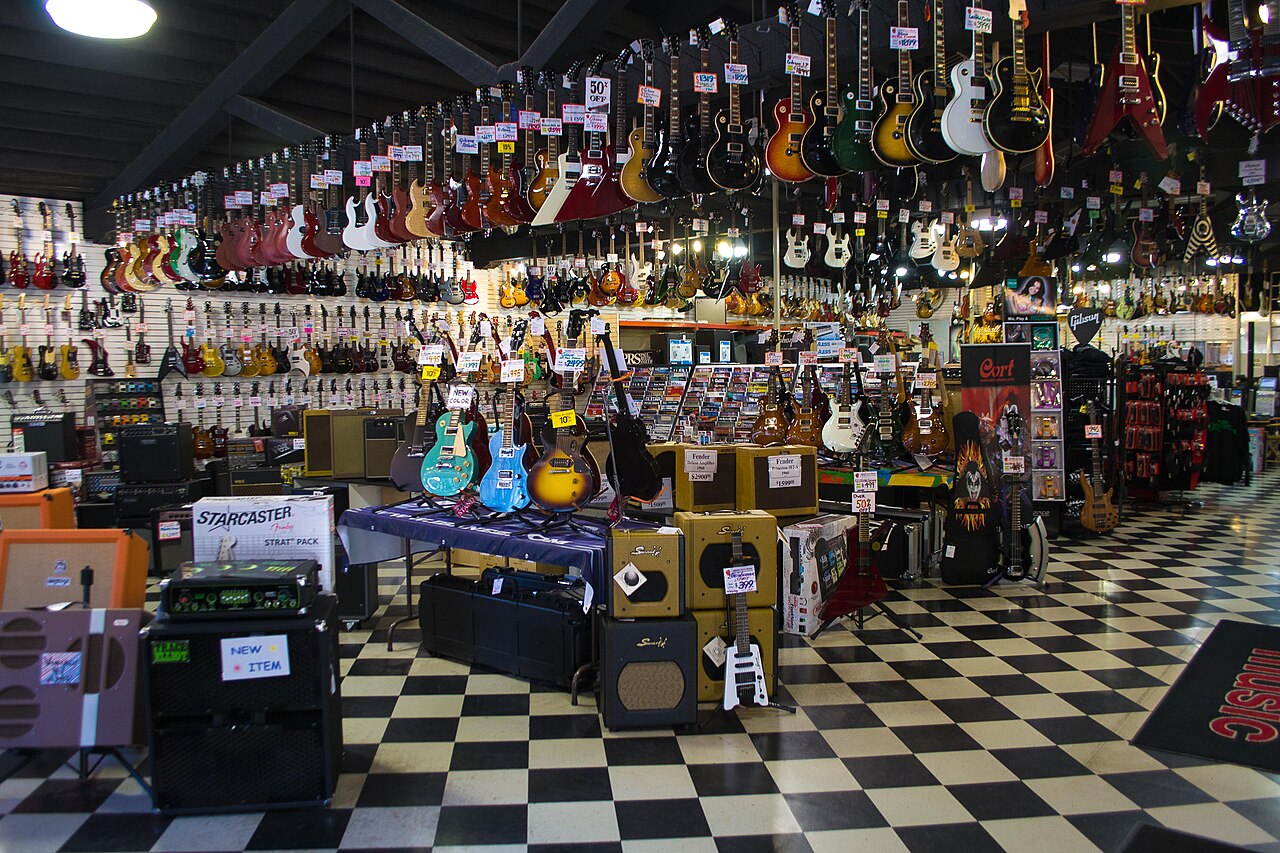 A selection of guitars and amps at Apple Music Row Rock music is a genre of popular music that developed in the 1950s from rock and roll, rockabilly, blues, and country music.[69] The sound of rock often revolves around the electric or acoustic guitar, and it uses a strong back beat laid down by a rhythm section. Along with the guitar or keyboards, saxophone and blues-style harmonica are used as soloing instruments. In its "purest form", it "has three chords, a strong, insistent back beat, and a catchy melody."[70] The traditional rhythm section for popular music is rhythm guitar, electric bass guitar, drums. Some bands have keyboard instruments such as organ, piano, or, since the 1970s, analog synthesizers. In the 1980s, pop musicians began using digital synthesizers, such as the DX-7 synthesizer, electronic drum machines such as the TR-808 and synth bass devices (such as the TB-303) or synth bass keyboards. In the 1990s, an increasingly large range of computerized hardware musical devices and instruments and software (e.g. digital audio workstations) were used. In the 2020s, soft synths and computer music apps make it possible for bedroom producers to create and record types of music, such as electronic dance music, in their home, adding sampled and digital instruments and editing the recording digitally. In the 1990s, bands in genres such as nu metal began including DJs in their bands. DJs create music by manipulating recorded music, using a DJ mixer.[71][72] Innovation in music technology continued into the 21st century, including the development of isomorphic keyboards and Dynamic Tonality. |
歴史 主な記事 音楽の歴史 起源と前史 さらに詳しい情報 音楽の起源と先史時代の音楽  43,150-39,370BP頃とされるドイツ、ガイセンクレステル出土の骨製フルート[22]。 B_1431 Sha-Amun-en-su、エジプトの歌手[23]。 多くの学者が音楽の起源と言語の起源との関係を強調しており、音楽が言語の前に発達したのか、言語の後に発達したのか、それとも言語と同時に発達したのか を巡って意見が分かれている[26]。 [26]最も初期の有力な説は、1871年にチャールズ・ダーウィンによって提唱されたもので、ダーウィンは、音楽はおそらく交尾の呼びかけを介して、性 淘汰の一形態として生じたと述べている[27]。 [29]その他の説としては、音楽は労働の組織化を助けるために生まれた、長距離コミュニケーションを改善するために生まれた、神とのコミュニケーション を助けるために生まれた、共同体の結束を助けるために生まれた、あるいは捕食者を追い払うための防衛手段として生まれた、などがある[30]。 先史時代の音楽は、旧石器時代の考古学的遺跡からの発見に基づいてのみ理論化することができる。ホラアナグマの大腿骨から彫られたディヴィエ・バベのフ ルートは、少なくとも4万年前のものと考えられているが、それが本当に楽器なのか、それとも動物によって形成された物体なのかについてはかなりの議論があ る[31]。楽器として広く受け入れられている最古の物体は、ドイツのシュヴァーベン・ジュラ地方、すなわちガイセンクレステル、ホーレ・フェルス、 フォーゲルヘルトの洞窟から出土した骨のフルートである[32]。 [32]オーリニア紀(後期旧石器時代)のものとされ、ヨーロッパ初期の現生人類が使用していた。3つの洞窟すべてから8つの例があり、4つは鳥の翼の骨 から、4つはマンモスの象牙から作られている。 古代 主な記事 古代音楽 エジプトの楽器に関する最古の資料や表象的な証拠は前王朝時代のものであるが、ハープ、フルート、ダブルクラリネットが演奏されていた古王国時代には、そ の証拠がより確実に証明されている[33]。シンバル[34]は、今日のエジプトでもそうであるように、音楽や舞踊の伴奏によく使われた。伝統的なスー フィーのディクルの儀式を含むエジプトの民族音楽は、その特徴、リズム、楽器の多くを保存しており、古代エジプト音楽に最も近い現代音楽のジャンルである [35][36]。 古代シリアの都市ウガリトの粘土板で発見された「ニッカルへのヒュリア賛歌」は、紀元前約1400年に遡る、現存する最古の楽譜化された音楽作品である [37][38]。 古代ギリシャにおいて、音楽は社会的・文化的生活の重要な一部であり、実際、音楽は子供たちに教えられる主要科目の一つであった。音楽教育は個人の魂の成 長にとって重要であると考えられていた。ギリシア演劇では音楽家や歌手が重要な役割を果たし[39]、音楽教育を受けた者は高貴で完璧な調和を保った者と みなされた(『共和国』プラトンにその記述がある)。楽器はダブルリードのアウロスと撥弦楽器のライアー、主にキタラと呼ばれる特殊なものであった [40]。音楽は教育の重要な一部であり、男子は6歳から音楽を教えられた。ギリシアの音楽リテラシーは、音楽の大きな発展をもたらした。ギリシアの音楽 理論には、ギリシアの音楽様式が含まれ、それはやがて西洋の宗教音楽やクラシック音楽の基礎となった。その後、ローマ帝国、東ヨーロッパ、ビザンチン帝国 からの影響がギリシャ音楽を変えた。セイキロスの墓碑銘は、楽譜を含む完全な楽曲の現存する世界最古の例である[41]。音楽理論を主題として書かれた現 存する最古の著作は、アリストクセヌスのHarmonika Stoicheiaである[42]。 アジアの文化 主な記事 アジアの音楽 アジアの音楽は、アラビア、中央アジア、東アジア、南アジア、東南アジアの各記事で調査した音楽文化を網羅している。いくつかの伝統は古代にまで及んでい る。  インド各地で親しまれているさまざまな楽器を演奏する、民族衣装をまとったインドの女性たち。 インド古典音楽は、世界で最も古い音楽の伝統のひとつである[43]。インダス渓谷文明の彫刻には、舞踊[44]や7つの穴のある笛のような古い楽器が描 かれている。古代ヒンドゥー教のテキストである『リグヴェーダ』には、現在のインド音楽の要素があり、詠唱のメーターとモードを示す楽譜が記されている [46]。現在のヒンディー音楽は、ペルシアの伝統音楽とアフガニスタンのムガール人の影響を受けている。南部の諸州で人気のあるカルナティック音楽は、 主に献身的な音楽であり、曲の大半はヒンドゥー教の神々に捧げられたものである。恋愛やその他の社会問題を強調する曲もある。  インドネシアはゴング・チャイムの故郷であり、インドネシア全土、特にジャワ島とバリ島に変種がある。 インドネシア音楽は、紀元前2~3世紀に青銅器時代の文化がインドネシア諸島に移住して以来、形成されてきた。インドネシアの伝統音楽は打楽器、特にケン ダンと銅鑼を使う。中には、ローテ島の弦楽器ササンド、スンダのアンクルン、複雑で洗練されたジャワやバリのガムラン・オーケストラなど、精巧で個性的な 楽器を開発したものもある。インドネシアはゴング・チャイムの本場であり、小型で高音のポット・ゴングのセットの総称である。ゴングは通常、低い木枠に繋 がれた弦の上にボスを立てて、音順に配置される。インドネシア音楽の最もポピュラーな形態はガムランであり、メタロフォン、ドラム、ゴング、スパイク・ フィドルに竹製のスリン(フルートのようなもの)を加えた調律打楽器のアンサンブルである[48][49]。 中国古典音楽は、中国の伝統的な芸術または宮廷音楽であり、約3,000年以上の歴史がある。楽譜、調律、音程、楽器、スタイルやジャンルなど、独自のシ ステムを持っている。中国の音楽はペンタトニック・ディアトニックであり、ヨーロッパの影響を受けた音楽と同様に1オクターブに対して12音(5+7= 12)の音階を持つ[50]。 西洋クラシック 主な記事 クラシック音楽 初期の音楽 ブレーヴス・ディエス・ホ ミニス 演奏時間 3分32秒 レオナンまたはペロタン作 このファイルの再生に問題がありますか?メディアヘルプをご覧ください。  カトリック・ミサ典礼書の楽譜、1310-1320年頃 中世に起こった音楽の時代(500年から1400年)は、カトリック教会の礼拝に単旋律(単一の旋律線)の聖歌が導入されたことから始まった。ギリシャ文 化圏では古くから楽譜が使われていたが、中世になるとカトリック教会によって初めて楽譜が導入され、聖歌の旋律を書き留めることができるようになり、カト リック帝国全体で同じ旋律を宗教音楽に使用しやすくなった。800年以前のヨーロッパ中世のレパートリーで楽譜が発見されているのは、カトリック教会の単 旋律の典礼聖歌だけで、その中心的な伝統はグレゴリオ聖歌と呼ばれていた。このような聖歌や教会音楽の伝統と並行して、世俗歌曲(非宗教歌曲)の活気ある 伝統も存在した。この時代の作曲家の例としては、レオニン、ペロタン、ギョーム・ド・マショー、ワルター・フォン・デア・フォーゲルヴァイデなどが挙げら れる[51][52][53][54]。 ルネサンス音楽(1400年頃~1600年頃)は、宮廷恋愛などの世俗的なテーマに重きを置いていた。1450年頃に印刷機が発明され、印刷された楽譜は より安価で大量生産が容易になった(印刷機が発明される以前は、楽譜はすべて手書きでコピーされていた)。楽譜の入手性が高まったことで、音楽のスタイル はより早く、より広い地域に広まった。音楽家や歌手は教会や宮廷、町のために働くことが多くなった。教会の聖歌隊は規模を拡大し、教会は音楽の重要な後援 者であり続けた。15世紀半ばには、作曲家たちは、異なる旋律線を同時に織り交ぜた、豊かな多声部の聖楽を作曲した。この時代の著名な作曲家には、ギョー ム・デュ・フェイ、ジョヴァンニ・ピエルルイジ・ダ・パレストリーナ、トマス・モーリー、オルランド・ディ・ラッソ、ジョスカン・デ・プレなどがいる。音 楽活動が教会から貴族の宮廷に移ると、王、王妃、王侯が最高の作曲家を競い合うようになった。代表的な作曲家の多くはオランダ、ベルギー、フランス出身 で、彼らはフランコ・フレミッシュと呼ばれる[55]。その他、ドイツ、イギリス、スペインなどでも活発な音楽活動が行われた。 共通練習期間 バロック 主な記事 バロック音楽 トッカータとフーガ ニ短調 BWV 5 演奏時間: 8分34秒8:34 トッカータとフーガ by J.S. Bach  バロック音楽の時代は1600年から1750年までで、ヨーロッパ全土でバロック芸術様式が花開いた。バロック音楽は、最初のオペラ(オーケストラを伴う 劇的な独唱曲)が書かれたときに始まった。バロック時代には、複数の独立した旋律線を同時に用いるポリフォニックな対位法音楽が引き続き重要視された(中 世の声楽音楽では対位法が重要だった)。ドイツ・バロックの作曲家たちは、弦楽器、金管楽器、木管楽器などの小編成のアンサンブルや、合唱団、パイプオル ガン、チェンバロ、クラヴィコードなどの鍵盤楽器のために作曲した。この時代には、フーガ、インヴェンション、ソナタ、協奏曲など、いくつかの主要な音楽 形式が定義され、それらは後の時代まで続き、さらに拡張され進化した。バロック時代の重要な作曲家としては、ヨハン・セバスティアン・バッハ(チェロ組 曲)、ジョージ・フリデリック・ヘンデル(メサイア)、ゲオルク・フィリップ・テレマン、アントニオ・ヴィヴァルディ(四季)などが挙げられる。 古典主義 主な記事 古典派時代(音楽) 交響曲第40番 ト短調 演奏時間:8分14秒8:14 交響曲第40番 ト短調 by W.A. Mozart このファイルの再生に問題がありますか? メディアヘルプをご覧ください。  ヴォルフガング・アマデウス・モーツァルトは、古典派時代に多作で影響力のある作曲家である。 古典派時代(1730年~1820年)の音楽は、古代ギリシャ・ローマの芸術と哲学の重要な要素であると考えられていた、バランス、比率、規律ある表現の 理想を模倣することを目的としていました。(注:古典派音楽とは、5世紀から2000年代までの西洋の芸術音楽を指す言葉で、古典派音楽もその中に含まれ る)。古典派の音楽は、それ以前のバロック音楽よりも軽く、明瞭で、かなり単純なテクスチュアを持つ。主な様式はホモフォニーであり[57]、著名な旋律 と従属的な和音伴奏部分が明確に区別されている。古典楽器の旋律は、ほとんど声楽的で歌いやすい傾向があった。新しいジャンルが開発され、現代のピアノの 前身であるフォルテピアノが、バロック時代のチェンバロやパイプオルガンに代わって主要な鍵盤楽器となった(ただし、ミサ曲などの神聖な音楽ではパイプオ ルガンが使われ続けた)。 器楽が重視された。ソナタ、協奏曲、交響曲など、バロック時代に定義された音楽形式がさらに発展した。その他、トリオ、弦楽四重奏曲、セレナード、ディ ヴェルティメントなどがあった。ソナタは最も重要で発展した形式である。バロックの作曲家もソナタを書いたが、古典派のソナタ様式はまったく異なる。弦楽 四重奏曲から交響曲、協奏曲に至るまで、古典派時代の主要な器楽曲の形式はすべてソナタの構成に基づいている。室内楽やオーケストラで使われる楽器は、よ り標準化された。チェンバロ、オルガン、リュートと、グループリーダーの裁量で選ばれた数種類の低音楽器(ヴィオール、チェロ、テオルボ、サーペントな ど)で構成されていたバロック時代の通奏低音グループに代わって、古典派の室内楽グループは、指定された標準化された楽器を使用するようになった(例え ば、弦楽四重奏は、2本のヴァイオリン、ヴィオラ、チェロで演奏される)。バロック音楽の特徴であった通奏低音奏者やリュート奏者による即興的な和音演奏 は、1750年から1800年にかけて徐々に衰退していった[58]。 古典派時代に起こった最も重要な変化のひとつは、公開コンサートの発展であった。貴族は依然としてコンサートや作曲のスポンサーとして重要な役割を果たし ていたが、作曲家が王妃や王侯の正社員になることなく生き残ることが可能になった。クラシック音楽の人気が高まるにつれ、オーケストラの数も種類も増えて いった。オーケストラ・コンサートの拡大により、大規模な公共演奏スペースの建設が必要となった。交響曲、バレエの伴奏音楽、オペラやオラトリオのような 声楽と器楽の混成ジャンルを含む交響曲が人気を博した[59][60][61]。 古典主義の最も有名な作曲家は、カール・フィリップ・エマニュエル・バッハ、クリストフ・ウィリバルト・グルック、ヨハン・クリスチャン・バッハ、ヨーゼ フ・ハイドン、ヴォルフガング・アマデウス・モーツァルト、ルートヴィヒ・ヴァン・ベートーヴェン、フランツ・シューベルトである。ベートーヴェンと シューベルトは、古典派がロマン派に移行し始めた後期の作曲家とも言われている。 ロマン主義 主な記事 ロマン派音楽 ワルキューレ 演奏時間:27分57秒27:57 リヒャルト・ワーグナーの「ワルキューレ このファイルの再生に問題がありますか? メディアヘルプをご覧ください。  ピアノは19世紀、中流階級の都市生活者にとって社会活動の中心であった(Moritz von Schwind, 1868)。ピアノの前にいるのは作曲家フランツ・シューベルト。 19世紀のロマン派音楽(1820年頃~1900年頃)は、当時の文学や絵画におけるロマン派の様式と共通する要素を多く持っていた。ロマン主義とは、芸 術的、文学的、知的な運動であり、感情や個人主義を強調し、過去や自然を賛美することを特徴としていた。ロマン派の音楽は、古典派時代の堅苦しいスタイル や形式を超え、より情熱的でドラマチックな表現力豊かな曲や歌へと拡大した。ワーグナーやブラームスといったロマン派の作曲家たちは、より深い真理や人間 の感情を表現するために、音楽における感情表現やパワーを高めようとした。交響的トーンポエムでは、作曲家たちは器楽曲を使って物語を語り、イメージや風 景を喚起しようとした。民族音楽に触発された愛国的な管弦楽曲で民族的な誇りを高めた作曲家もいた。音楽の感情的で表現的な特質は、伝統よりも優先される ようになった[62]。 ロマン派の作曲家たちは特異性を増し、音楽の文脈の中で異なる芸術形式(文学など)、歴史(歴史上の人物や伝説)、あるいは自然そのものを探求するシンク レティズムをさらに推し進めた。ロマンティックな愛や憧れは、この時期に作曲された多くの作品に共通するテーマであった。場合によっては、古典派時代の形 式構造が引き続き使われることもあったが(弦楽四重奏曲や交響曲で使われるソナタ形式など)、これらの形式は拡張され、変更された。多くの場合、既存の ジャンル、形式、機能に対して新しいアプローチが模索された。また、新しい主題に適した新しい形式も生まれた。作曲家たちは新しいスタイルやテーマを探求 しながら、オペラやバレエ音楽を発展させ続けた[39]。 1800年以降の数年間、ルートヴィヒ・ヴァン・ベートーヴェンとフランツ・シューベルトによって開発された音楽は、より劇的で表現力豊かなスタイルを導 入した。ベートーヴェンの場合、有機的に展開される短いモチーフが、旋律に代わって最も重要な作曲単位となった(例として、彼の交響曲第5番で使用された 特徴的な4音図形が挙げられる)。ピョートル・イリイチ・チャイコフスキー、アントニン・ドヴォルザーク、グスタフ・マーラーといった後のロマン派の作曲 家たちは、劇的な緊張感を生み出すために、より珍しい和音や不協和音を多用した。彼らは複雑で、しばしばはるかに長い音楽作品を生み出した。後期ロマン派 の時代には、作曲家たちは、延長和音や変和音など、調性の劇的な半音階的変化を探求し、新しい音の "色 "を生み出した。19世紀後半には、オーケストラの規模が劇的に拡大し、産業革命によってより優れた楽器が作られ、よりパワフルなサウンドが生み出され た。公共コンサートは裕福な都市社会で重要な位置を占めるようになった。また、オペレッタ、ミュージカル・コメディ、その他の音楽劇など、劇場音楽にも新 たな多様性が生まれた[39]。 20世紀と21世紀 主な記事 20世紀の音楽  ランドマンが2006年に発表した、実験的楽器の一例である3rd-bridged overtone zither「Moodswinger 19世紀には、新曲が一般に知られるようになる重要な方法は楽譜の販売であり、中産階級のアマチュア音楽愛好家たちは、自宅のピアノやヴァイオリンなどの 一般的な楽器で演奏していた。20世紀の音楽では、ラジオ放送のような新しい電気技術の発明や、蓄音機によるレコードの大量販売によって、リスナーが(ラ ジオやレコードプレーヤーで)聴く音源が、新しい曲や楽曲を知るための主な手段となった[63]。ラジオが普及し、蓄音機が音楽の再生や配信に使われるよ うになると、音楽を聴く機会が大幅に増え、ラジオやレコードプレーヤーがあれば、誰でもオペラや交響曲、ビッグバンドを自宅の居間で聴くことができるよう になった。19世紀には、楽譜が中心だったため、新しい音楽を聴くことができたのは、楽譜が読め、ピアノやその他の楽器を所有している中流階級や上流階級 の人々に限られていた。ラジオやレコードプレーヤーは、オペラやシンフォニーのコンサートのチケットを買う余裕のない低所得者層にも、こうした音楽を聴か せることができた。つまり、たとえ旅行する余裕がなくても、国内のさまざまな地域、あるいは世界のさまざまな地域の音楽を聴くことができたのである。これ は音楽スタイルの普及に役立った[64]。 20世紀の芸術音楽の焦点は、新しいリズム、スタイル、サウンドの探求によって特徴づけられた。第一次世界大戦の恐怖は、音楽を含む多くの芸術に影響を与 え、作曲家たちはより暗く、より過酷なサウンドを探求し始めた。ジャズや民族音楽といった伝統的な音楽スタイルは、作曲家たちによってクラシック音楽のア イデアの源として利用された。イーゴリ・ストラヴィンスキー、アーノルド・シェーンバーグ、ジョン・ケージは、20世紀の芸術音楽に影響を与えた作曲家で ある。録音技術が発明され、音楽を編集できるようになったことで、電子音楽のアクースマティック[65]やムジーク・コンクレートなど、クラシック音楽の 新しいサブジャンルが生まれた。録音は、歌やバンドの録音を広く流通させることができたため、ポピュラー音楽のジャンルの発展に大きな影響を与えた。マル チトラック・レコーディング・システムの導入はロック音楽に大きな影響を与えた。マルチトラックシステムを使うことで、バンドとその音楽プロデューサー は、楽器のトラックやヴォーカルを何層にも重ねてオーバーダビングすることができ、ライブパフォーマンスでは不可能な新しいサウンドを作り出すことができ た[66][67]。 ジャズは20世紀の間に進化し、音楽の重要なジャンルとなり、後半にはロックも同じようになった。ジャズは20世紀初頭にアメリカ南部のアフリカ系アメリ カ人のコミュニティでアフリカとヨーロッパの音楽の伝統の合流から生まれたアメリカの音楽芸術である。このスタイルの西アフリカの血統は、ブルーノート、 即興演奏、ポリリズム、シンコペーション、スイングノートの使用において明らかである[68]。  Apple Music Rowのギターとアンプのセレクション ロック・ミュージックは、1950年代にロックンロール、ロカビリー、ブルース、カントリー・ミュージックから発展したポピュラー音楽のジャンルである [69]。ロックのサウンドはエレキギターやアコースティック・ギターを中心に展開されることが多く、リズム・セクションによる強力なバック・ビートが使 われる。ギターやキーボードとともに、サックスやブルース・スタイルのハーモニカがソロ楽器として使われる。ポピュラー音楽の伝統的なリズム・セクション は、リズム・ギター、エレキ・ベース、ドラムスである。オルガンやピアノ、1970年代以降はアナログ・シンセサイザーなどの鍵盤楽器を持つバンドもあ る。1980年代に入ると、ポップ・ミュージシャンはDX-7シンセサイザーなどのデジタル・シンセサイザー、TR-808などの電子ドラム・マシン、シ ンセ・ベース・デバイス(TB-303など)やシンセ・ベース・キーボードを使い始めた。1990年代には、コンピュータ化されたハードウェア音楽機器や 楽器、ソフトウェア(デジタル・オーディオ・ワークステーションなど)がますます幅広く使われるようになった。2020年代には、ソフトシンセやコン ピューター音楽アプリによって、ベッドルーム・プロデューサーが自宅でエレクトロニック・ダンス・ミュージックなどのタイプの音楽を制作・録音し、サンプ リングやデジタル楽器を加え、録音をデジタル編集することが可能になった。1990年代には、ニューメタルなどのジャンルのバンドがDJをバンドに加える ようになった。DJはDJミキサーを使い、録音された音楽を操作することで音楽を創作する[71][72]。 音楽技術の革新は21世紀に入っても続き、同形キーボードやダイナミック・トーナリティの開発もそのひとつである。 |
| Creation Composition Main article: Musical composition 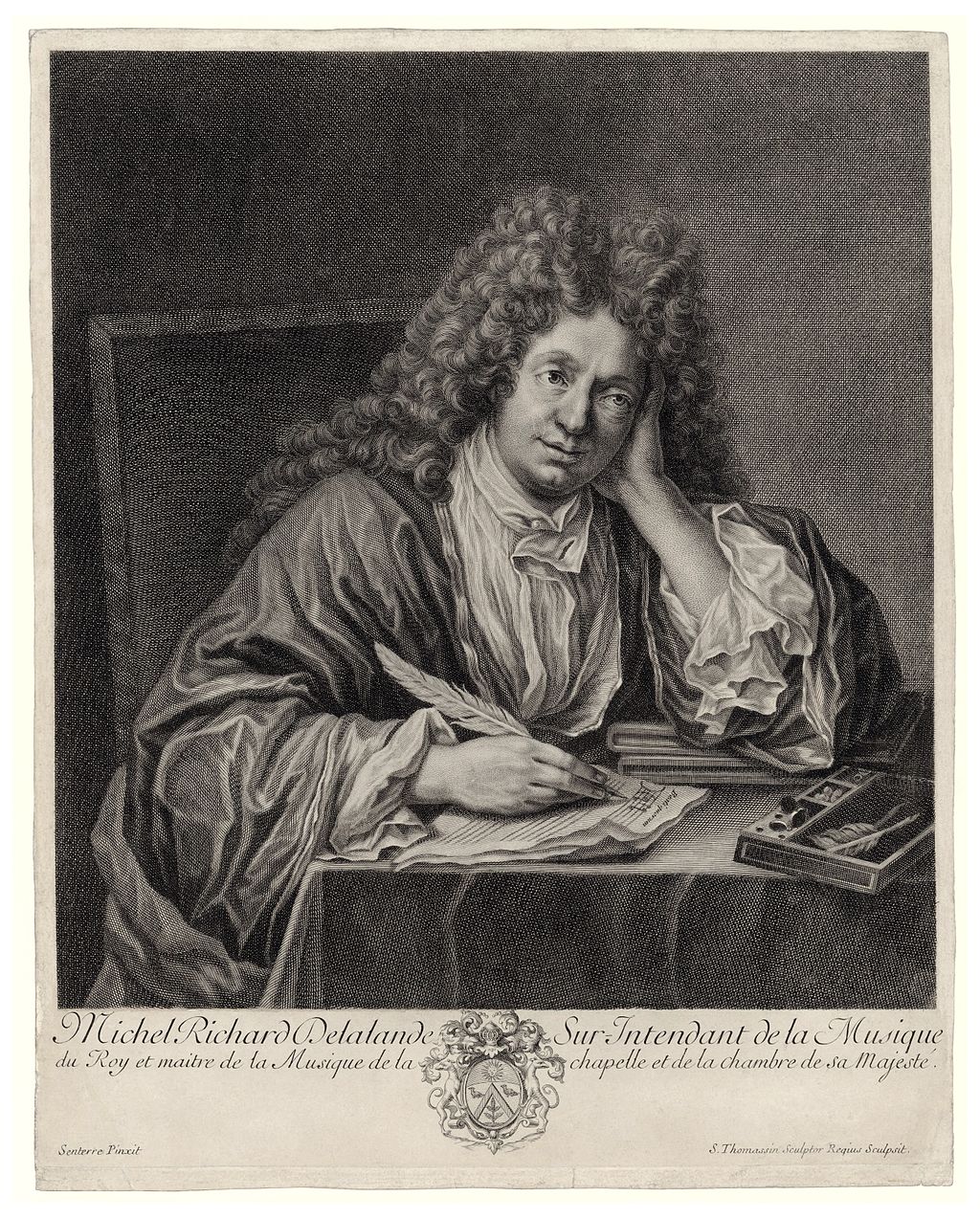 French Baroque music composer Michel Richard Delalande (1657–1726), pen in hand 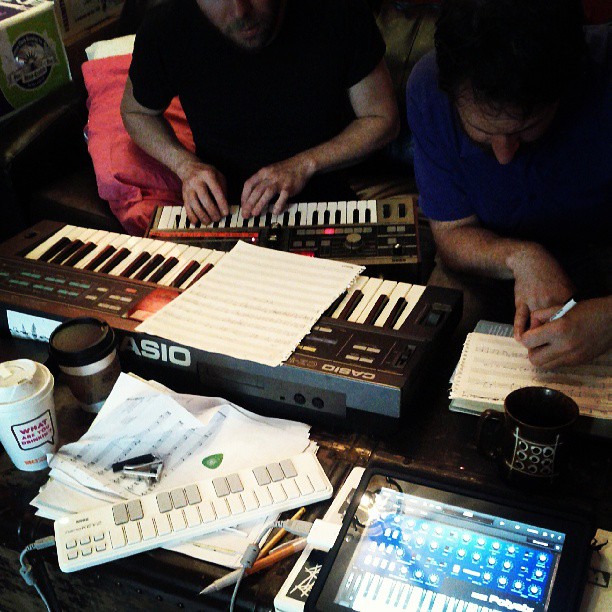 People composing music in 2013 using electronic keyboards and computers "Composition" is the act or practice of creating a song, an instrumental music piece, a work with both singing and instruments, or another type of music. In many cultures, including Western classical music, the act of composing also includes the creation of music notation, such as a sheet music "score", which is then performed by the composer or by other singers or musicians. In popular music and traditional music, the act of composing, which is typically called songwriting, may involve the creation of a basic outline of the song, called the lead sheet, which sets out the melody, lyrics and chord progression. In classical music, the composer typically orchestrates his or her own compositions, but in musical theatre and in pop music, songwriters may hire an arranger to do the orchestration. In some cases, a songwriter may not use notation at all, and instead, compose the song in her mind and then play or record it from memory. In jazz and popular music, notable recordings by influential performers are given the weight that written scores play in classical music.[73][74] Even when music is notated relatively precisely, as in classical music, there are many decisions that a performer has to make, because notation does not specify all of the elements of music precisely. The process of deciding how to perform music that has been previously composed and notated is termed "interpretation". Different performers' interpretations of the same work of music can vary widely, in terms of the tempos that are chosen and the playing or singing style or phrasing of the melodies. Composers and songwriters who present their own music are interpreting their songs, just as much as those who perform the music of others. The standard body of choices and techniques present at a given time and a given place is referred to as performance practice, whereas interpretation is generally used to mean the individual choices of a performer.[75] Although a musical composition often uses musical notation and has a single author, this is not always the case. A work of music can have multiple composers, which often occurs in popular music when a band collaborates to write a song, or in musical theatre, when one person writes the melodies, a second person writes the lyrics, and a third person orchestrates the songs. In some styles of music, such as the blues, a composer/songwriter may create, perform and record new songs or pieces without ever writing them down in music notation. A piece of music can also be composed with words, images, or computer programs that explain or notate how the singer or musician should create musical sounds. Examples range from avant-garde music that uses graphic notation, to text compositions such as Aus den sieben Tagen, to computer programs that select sounds for musical pieces. Music that makes heavy use of randomness and chance is called aleatoric music,[76] and is associated with contemporary composers active in the 20th century, such as John Cage, Morton Feldman, and Witold Lutosławski. A commonly known example of chance-based music is the sound of wind chimes jingling in a breeze. The study of composition has traditionally been dominated by examination of methods and practice of Western classical music, but the definition of composition is broad enough to include the creation of popular music and traditional music songs and instrumental pieces as well as spontaneously improvised works like those of free jazz performers and African percussionists such as Ewe drummers. Performance Main article: Performance 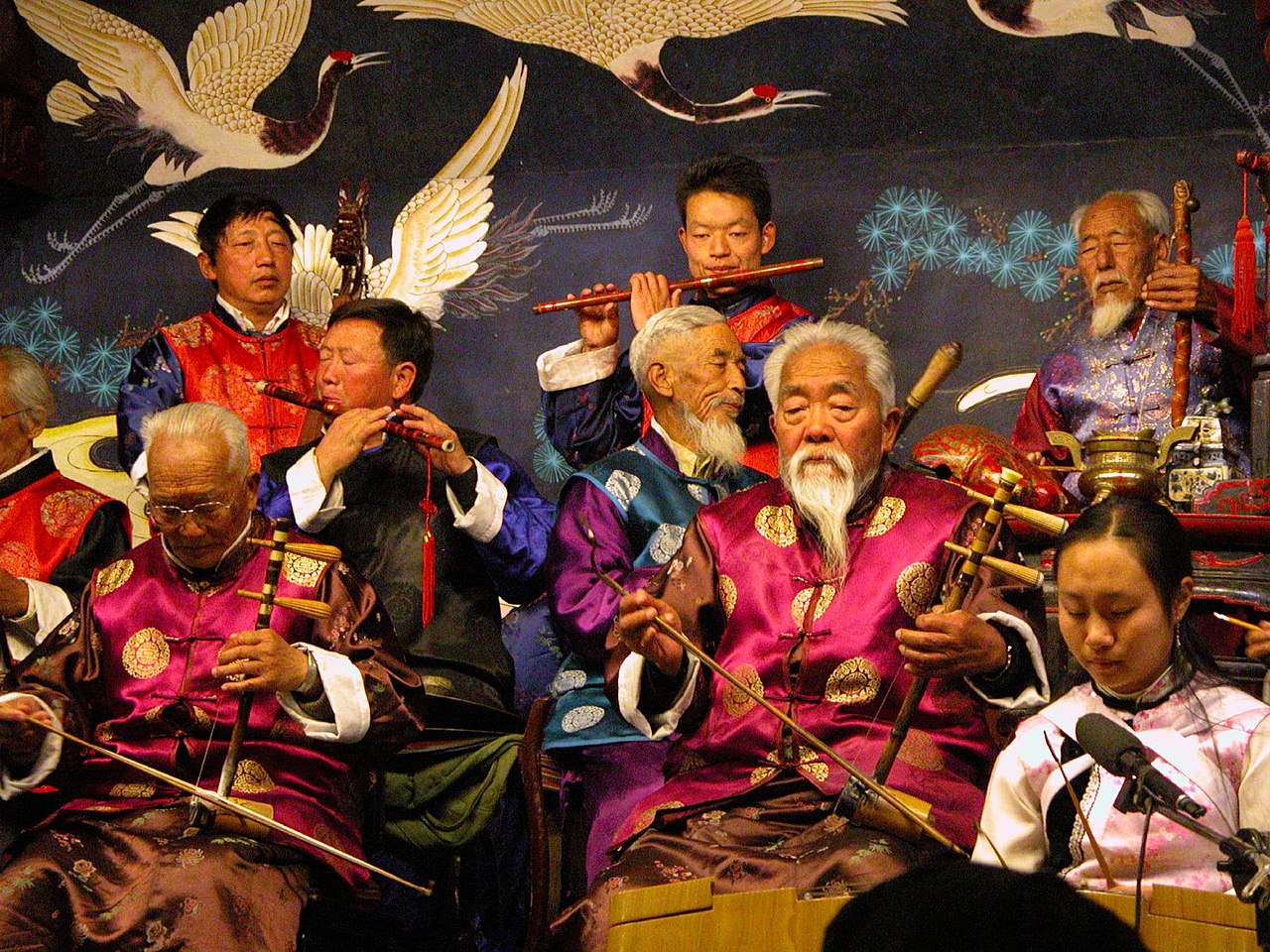 Chinese Naxi musicians 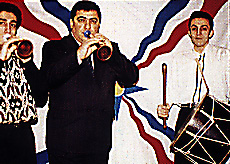 Assyrians playing zurna and Davul, instruments that go back thousands of years Performance is the physical expression of music, which occurs when a song is sung or piano piece, guitar melody, symphony, drum beat or other musical part is played. In classical music, a work is written in music notation by a composer and then performed once the composer is satisfied with its structure and instrumentation. However, as it gets performed, the interpretation of a song or piece can evolve and change. In classical music, instrumental performers, singers or conductors may gradually make changes to the phrasing or tempo of a piece. In popular and traditional music, the performers have more freedom to make changes to the form of a song or piece. As such, in popular and traditional music styles, even when a band plays a cover song, they can make changes such as adding a guitar solo or inserting an introduction.[77] A performance can either be planned out and rehearsed (practiced)—which is the norm in classical music, jazz big bands, and many popular music styles–or improvised over a chord progression (a sequence of chords), which is the norm in small jazz and blues groups. Rehearsals of orchestras, concert bands and choirs are led by a conductor. Rock, blues and jazz bands are usually led by the bandleader. A rehearsal is a structured repetition of a song or piece by the performers until it can be sung or played correctly and, if it is a song or piece for more than one musician, until the parts are together from a rhythmic and tuning perspective. Many cultures have strong traditions of solo performance (in which one singer or instrumentalist performs), such as in Indian classical music, and in the Western art-music tradition. Other cultures, such as in Bali, include strong traditions of group performance. All cultures include a mixture of both, and performance may range from improvised solo playing to highly planned and organized performances such as the modern classical concert, religious processions, classical music festivals or music competitions. Chamber music, which is music for a small ensemble with only one or a few of each type of instrument, is often seen as more intimate than large symphonic works.[78] Improvisation Main article: Musical improvisation Musical improvisation is the creation of spontaneous music, often within (or based on) a pre-existing harmonic framework, chord progression, or riffs. Improvisers use the notes of the chord, various scales that are associated with each chord, and chromatic ornaments and passing tones which may be neither chord tones nor from the typical scales associated with a chord. Musical improvisation can be done with or without preparation. Improvisation is a major part of some types of music, such as blues, jazz, and jazz fusion, in which instrumental performers improvise solos, melody lines, and accompaniment parts..[79] In the Western art music tradition, improvisation was an important skill during the Baroque era and during the Classical era. In the Baroque era, performers improvised ornaments, and basso continuo keyboard players improvised chord voicings based on figured bass notation. As well, the top soloists were expected to be able to improvise pieces such as preludes. In the Classical era, solo performers and singers improvised virtuoso cadenzas during concerts. However, in the 20th and early 21st century, as "common practice" Western art music performance became institutionalized in symphony orchestras, opera houses, and ballets, improvisation has played a smaller role, as more and more music was notated in scores and parts for musicians to play. At the same time, some 20th and 21st century art music composers have increasingly included improvisation in their creative work. In Indian classical music, improvisation is a core component and an essential criterion of performances. |
クリエーション 構成 主な記事 作曲  フランスのバロック音楽作曲家、ミシェル・リシャール・デランド(1657-1726)。  2013年、電子キーボードやコンピューターを使って作曲する人々 「作曲」とは、歌曲、器楽曲、歌と楽器の両方を使った作品、あるいはその他の種類の音楽を創作する行為や実践のことである。西洋のクラシック音楽を含む多 くの文化では、作曲行為には楽譜の作成も含まれる。ポピュラー音楽や伝統音楽では、作曲行為は一般的にソングライティングと呼ばれ、メロディー、歌詞、 コード進行を記したリードシートと呼ばれる曲の基本的なアウトラインを作成することがある。クラシック音楽では、作曲家が自分でオーケストレーションをす るのが一般的だが、ミュージカルシアターやポップミュージックでは、ソングライターがアレンジャーを雇ってオーケストレーションをすることもある。作曲家 が楽譜をまったく使わず、頭の中で作曲し、それを記憶して演奏したり録音したりする場合もある。ジャズやポピュラー音楽では、影響力のある演奏家による著 名な録音は、クラシック音楽で楽譜が果たす重みを与えられている[73][74]。 クラシック音楽のように、音楽が比較的正確に記譜されている場合でも、楽譜は音楽のすべての要素を正確に規定しているわけではないので、演奏者が決断しな ければならないことはたくさんある。先に作曲され楽譜化された音楽をどのように演奏するかを決めるプロセスは「解釈」と呼ばれる。同じ音楽作品でも、演奏 者によって解釈は大きく異なり、テンポの選び方やメロディーの弾き方、歌い方、フレージングなどが異なります。自分の曲を演奏する作曲家や作詞家は、他人 の曲を演奏する人と同じように、自分の曲を解釈しているのだ。ある時、ある場所に存在する標準的な選択とテクニックの集合体は演奏実践と呼ばれ、解釈は一 般的に演奏者の個々の選択を意味するのに使われる[75]。 作曲はしばしば楽譜を使用し、単一の作者を持つが、これは必ずしもそうではない。ポピュラー音楽ではバンドが共同で曲を書いたり、音楽劇では一人がメロ ディーを書き、二人目が歌詞を書き、三人目がオーケストレーションをしたりする。ブルースのような音楽スタイルでは、作曲家/ソングライターが、楽譜に書 くことなく新しい曲や作品を創作し、演奏し、録音することもある。また、歌い手や音楽家がどのように楽音を作るべきかを説明したり記譜したりする言葉や画 像、コンピュータープログラムを使って作曲することもある。例えば、図形楽譜を使った前衛音楽から、『Aus den sieben Tagen』のようなテキスト作曲、楽曲の音を選択するコンピュータープログラムまで、さまざまな例がある。ランダム性や偶然性を多用する音楽はアレア トール音楽と呼ばれ[76]、ジョン・ケージ、モートン・フェルドマン、ヴィトルド・ルトスワフスキといった20世紀に活躍した現代作曲家に関連してい る。偶然性に基づく音楽の例として一般的に知られているのは、そよ風に吹かれてジャラジャラと鳴る風鈴の音である。 作曲の研究は、伝統的に西洋のクラシック音楽の手法や実践を検証することが主流であったが、作曲の定義は、ポピュラー音楽や伝統音楽の歌曲や器楽曲の創 作、フリージャズ演奏家やエウェ族の太鼓奏者のようなアフリカの打楽器奏者のような自発的な即興作品も含むほど広い。 パフォーマンス 主な記事 パフォーマンス  中国のナシ族の音楽家  数千年前の楽器、ズルナとダヴルを演奏するアッシリア人 演奏とは、音楽を身体的に表現することで、歌を歌ったり、ピアノ曲、ギターの旋律、交響曲、ドラムのビート、その他の音楽パートを演奏したりするときに行 われる。クラシック音楽では、作品は作曲家によって楽譜に書かれ、作曲家がその構成や楽器編成に満足した時点で演奏される。しかし、演奏されるにつれて、 曲や作品の解釈は進化し、変化することがある。クラシック音楽では、楽器演奏者、歌手、指揮者が曲のフレージングやテンポを少しずつ変えていくことがあ る。ポピュラー音楽や伝統音楽では、演奏者は曲や曲の形にもっと自由に変更を加えることができる。そのため、ポピュラー音楽や伝統音楽のスタイルでは、バ ンドがカバー曲を演奏する場合でも、ギターソロを追加したり、イントロを挿入したりといった変更を加えることができる[77]。 演奏は、クラシック音楽、ジャズのビッグバンド、および多くのポピュラー音楽スタイルで一般的な、計画されリハーサル(練習)されたものと、小規模なジャ ズやブルースのグループで一般的な、コード進行(コードの並び)の上に即興で演奏されたものがある。オーケストラ、コンサート・バンド、合唱団のリハーサ ルは指揮者によって指揮される。ロック、ブルース、ジャズバンドのリハーサルは、通常バンドリーダーが指揮します。リハーサルとは、歌や曲を正しく歌った り演奏したりできるようになるまで、また、複数のミュージシャンのための歌や曲であれば、リズムやチューニングの観点からパートが揃うまで、演奏者が構造 的に繰り返すことである。 多くの文化には、インド古典音楽や西洋芸術音楽の伝統のように、ソロ演奏(一人の歌手や楽器奏者が演奏する)の強い伝統がある。また、バリのようにグルー プ演奏の伝統が強い文化もある。すべての文化にはその両方が混在しており、即興的なソロ演奏から、現代のクラシックコンサート、宗教的な行列、クラシック 音楽祭、音楽コンクールのような高度に計画・組織化された演奏まで、さまざまな演奏が行われている。室内楽は、各楽器が1台または数台のみの小規模なアン サンブルのための音楽であり、大規模な交響楽作品よりも親密なものと見なされることが多い[78]。 即興演奏 主な記事 音楽即興 即興演奏とは、既存の和声的枠組みやコード進行、リフの中で(あるいはそれらに基づいて)、自発的に音楽を創作することである。即興演奏では、コードの 音、各コードに関連する様々な音階、半音階的な装飾音や通過音を使用するが、これらはコード・トーンでもなければ、コードに関連する典型的な音階のもので もない。音楽の即興演奏は、準備の有無にかかわらず行うことができる。即興演奏は、ブルース、ジャズ、ジャズ・フュージョンなど、楽器演奏者がソロ、メロ ディ・ライン、伴奏パートを即興で演奏する音楽の主要な一部である[79]。 西洋の芸術音楽の伝統では、即興演奏はバロック時代と古典派時代に重要なスキルであった。バロック時代には、演奏家は即興で装飾をつけ、通奏低音鍵盤奏者 は、フィギュアド・バスの記譜法に基づいて即興でコード・ヴォイシングをつけた。また、トップ・ソリストには前奏曲などの即興演奏が求められた。古典派の 時代には、独奏者や歌手は演奏会中にヴィルトゥオーゾ・カデンツァを即興で演奏していた。 しかし、20世紀から21世紀初頭にかけて、交響楽団、オペラハウス、バレエ団など、西洋の芸術音楽演奏の「常識」が制度化されるにつれて、即興演奏が果 たす役割は小さくなり、楽譜やパート譜に記譜されて演奏されることが多くなった。同時に、20世紀や21世紀の芸術音楽の作曲家の中には、即興演奏を創作 に取り入れるようになった者もいる。インド古典音楽では、即興演奏は演奏の中核をなす要素であり、不可欠な基準である。 |
Art and entertainment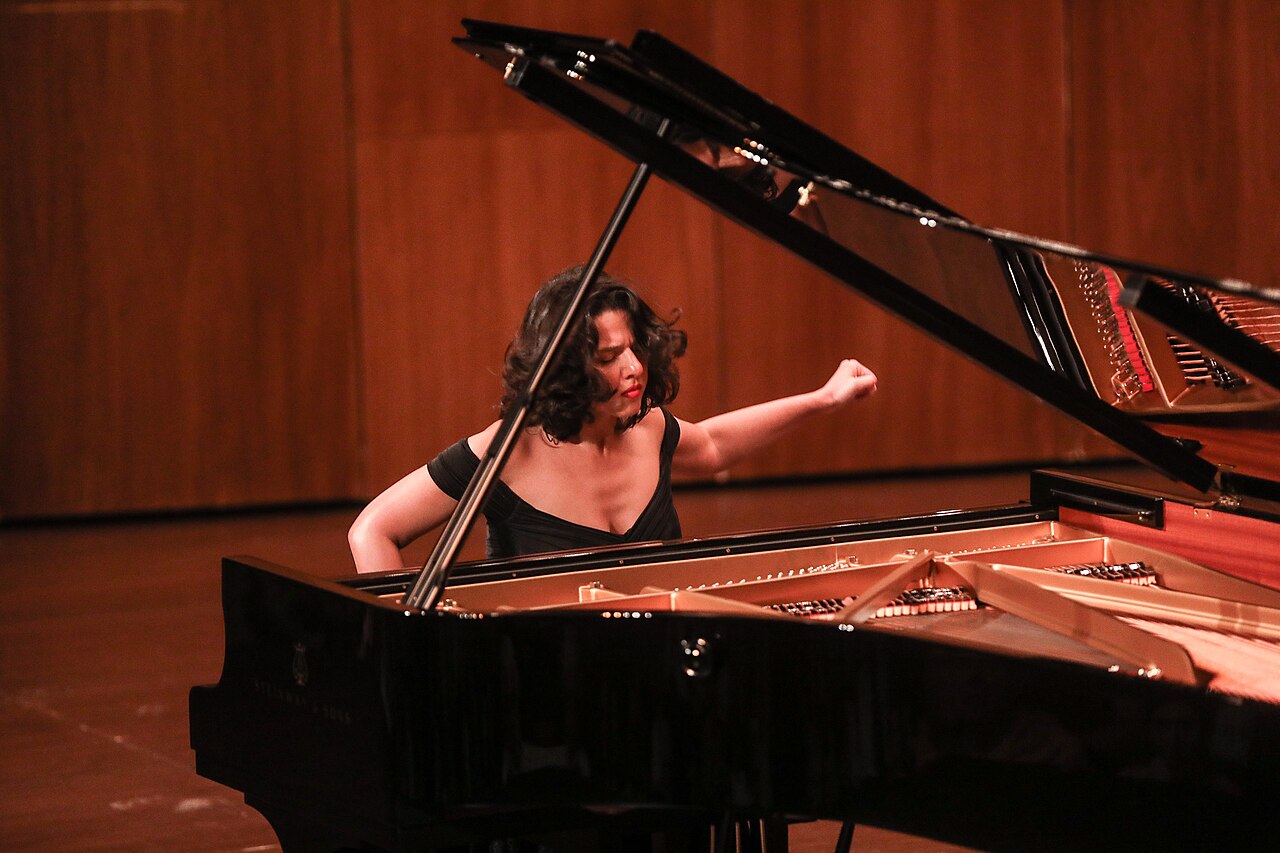 Khatia Buniatishvili playing a grand piano Music is composed and performed for many purposes, ranging from aesthetic pleasure, religious or ceremonial purposes, or as an entertainment product for the marketplace. When music was only available through sheet music scores, such as during the Classical and Romantic eras, music lovers would buy the sheet music of their favourite pieces and songs so that they could perform them at home on the piano. With the advent of the phonograph, records of popular songs, rather than sheet music became the dominant way that music lovers would enjoy their favourite songs. With the advent of home tape recorders in the 1980s and digital music in the 1990s, music lovers could make tapes or playlists of favourite songs and take them with them on a portable cassette player or MP3 player. Some music lovers create mix tapes of favourite songs, which serve as a "self-portrait, a gesture of friendship, prescription for an ideal party... [and] an environment consisting solely of what is most ardently loved".[80] Amateur musicians can compose or perform music for their own pleasure and derive income elsewhere. Professional musicians are employed by institutions and organisations, including armed forces (in marching bands, concert bands and popular music groups), religious institutions, symphony orchestras, broadcasting or film production companies, and music schools. Professional musicians sometimes work as freelancers or session musicians, seeking contracts and engagements in a variety of settings. There are often many links between amateur and professional musicians. Beginning amateur musicians take lessons with professional musicians. In community settings, advanced amateur musicians perform with professional musicians in a variety of ensembles such as community concert bands and community orchestras. A distinction is often made between music performed for a live audience and music that is performed in a studio so that it can be recorded and distributed through the music retail system or the broadcasting system. However, there are also many cases where a live performance in front of an audience is also recorded and distributed. Live concert recordings are popular in both classical music and in popular music forms such as rock, where illegally taped live concerts are prized by music lovers. In the jam band scene, live, improvised jam sessions are preferred to studio recordings.[81] Notation Main article: Musical notation  Sheet music is a written representation of music. Homorhythmic (i.e., hymn-style) arrangement of the traditional "Adeste Fideles" in standard two-staff format for mixed voices. playⓘ Music notation typically means the written expression of music notes and rhythms on paper using symbols. When music is written down, the pitches and rhythm of the music, such as the notes of a melody, are notated. Music notation often provides instructions on how to perform the music. For example, the sheet music for a song may state the song is a "slow blues" or a "fast swing", which indicates the tempo and the genre. To read notation, a person must have an understanding of music theory, harmony and the performance practice associated with a particular song or piece's genre. Written notation varies with the style and period of music. Nowadays, notated music is produced as sheet music or, for individuals with computer scorewriter programs, as an image on a computer screen. In ancient times, music notation was put onto stone or clay tablets.[38] To perform music from notation, a singer or instrumentalist requires an understanding of the rhythmic and pitch elements embodied in the symbols and the performance practice that is associated with a piece of music or genre. In genres requiring musical improvisation, the performer often plays from music where only the chord changes and form of the song are written, requiring the performer to have a great understanding of the music's structure, harmony and the styles of a particular genre e.g., jazz or country music. In Western art music, the most common types of written notation are scores, which include all the music parts of an ensemble piece, and parts, which are the music notation for the individual performers or singers. In popular music, jazz, and blues, the standard musical notation is the lead sheet, which notates the melody, chords, lyrics (if it is a vocal piece), and structure of the music. Fake books are also used in jazz; they may consist of lead sheets or simply chord charts, which permit rhythm section members to improvise an accompaniment part to jazz songs. Scores and parts are also used in popular music and jazz, particularly in large ensembles such as jazz "big bands." In popular music, guitarists and electric bass players often read music notated in tablature (often abbreviated as "tab"), which indicates the location of the notes to be played on the instrument using a diagram of the guitar or bass fingerboard. Tablature was used in the Baroque era to notate music for the lute, a stringed, fretted instrument.[82] Oral and aural tradition Many types of music, such as traditional blues and folk music were not written down in sheet music; instead, they were originally preserved in the memory of performers, and the songs were handed down orally, from one musician or singer to another, or aurally, in which a performer learns a song "by ear". When the composer of a song or piece is no longer known, this music is often classified as "traditional" or as a "folk song". Different musical traditions have different attitudes towards how and where to make changes to the original source material, from quite strict, to those that demand improvisation or modification to the music. A culture's history and stories may also be passed on by ear through song.[83] |
アートとエンターテインメント グランドピアノを演奏するハティア・ブニアティシヴィリ 音楽は、美的な楽しみ、宗教的・儀式的な目的、あるいは市場向けの娯楽商品など、さまざまな目的のために作曲され、演奏される。古典派やロマン派の時代の ように、音楽が楽譜でしか手に入らなかった時代には、音楽愛好家たちはお気に入りの曲や歌の楽譜を買い求め、自宅のピアノで演奏できるようにしていた。蓄 音機の出現により、楽譜ではなくポピュラーソングのレコードが、音楽愛好家がお気に入りの曲を楽しむための主流となった。1980年代には家庭用テープレ コーダーが、1990年代にはデジタルミュージックが登場し、音楽愛好家たちはお気に入りの曲のテープやプレイリストを作り、ポータブルカセットプレー ヤーやMP3プレーヤーに入れて持ち運ぶことができるようになった。音楽愛好家の中には、お気に入りの曲のミックス・テープを作成し、「自画像、友情の ジェスチャー、理想的なパーティーの処方箋...」として活用する人もいる。[そして]最も熱烈に愛されているものだけで構成された環境」[80]とな る。 アマチュア音楽家は自分の楽しみのために作曲や演奏をし、別の場所で収入を得ることができる。プロの音楽家は、軍隊(マーチングバンド、コンサートバン ド、ポピュラー音楽グループ)、宗教団体、交響楽団、放送・映画制作会社、音楽学校などの機関や組織に雇用されている。プロの音楽家は、フリーランスや セッションミュージシャンとして、さまざまな場面で契約や仕事を求めて活動することもある。アマチュア音楽家とプロ音楽家の間には、多くのつながりがある ことが多い。初心者のアマチュア音楽家は、プロの音楽家のレッスンを受けます。コミュニティーの場では、上級アマチュア音楽家は、コミュニティー・コン サート・バンドやコミュニティー・オーケストラなどの様々なアンサンブルで、プロの音楽家と共演します。 ライブで聴衆のために演奏される音楽と、スタジオで録音され、音楽小売システムや放送システムを通じて配信されるために演奏される音楽は、しばしば区別さ れる。しかし、聴衆の前で演奏された生演奏を録音して配信する場合も多い。クラシック音楽でも、ロックなどのポピュラー音楽でも、違法に録音されたライ ブ・コンサートが音楽愛好家の間で珍重されている。ジャムバンドシーンでは、スタジオ録音よりもライブの即興ジャムセッションが好まれる[81]。 楽譜 主な記事 楽譜  楽譜とは、音楽を文字で表したもの。伝統的な「アデステ・フィデレス」のホモリズム(すなわち賛美歌スタイル)編曲で、混声のための標準的な2五線譜形 式。 楽譜とは一般的に、音符やリズムを記号で紙に書き表したものを指します。楽譜に記譜する際には、メロディーの音符など、音楽の音程やリズムが表記されま す。楽譜には、その音楽をどのように演奏するかの指示が書かれていることが多い。例えば、ある曲の楽譜には「スローブルース」や「高速スウィング」と書か れていることがあり、これはテンポとジャンルを示している。楽譜を読むには、音楽理論、和声、特定の曲や曲のジャンルに関連した演奏方法を理解していなけ ればなりません。 楽譜は音楽のスタイルや時代によって異なります。現在では、楽譜は楽譜として、あるいはコンピュータの楽譜作成プログラムを使っている人のために、コン ピュータ画面上の画像として作成されます。古くは、楽譜は石や粘土の板に書かれていた[38]。楽譜から音楽を演奏するためには、歌手や楽器奏者は、記号 に込められたリズムや音程の要素、そして楽曲やジャンルに関連した演奏方法を理解する必要がある。即興演奏を必要とするジャンルでは、演奏者はコードチェ ンジと曲の形だけが書かれた楽譜から演奏することが多く、演奏者は音楽の構造、ハーモニー、特定のジャンル(例えばジャズやカントリーミュージック)のス タイルについて十分理解している必要がある。 西洋の芸術音楽では、最も一般的な楽譜の種類は、アンサンブル曲のすべてのパート譜を含むスコアと、個々の演奏者や歌手のためのパート譜であるパート譜で ある。ポピュラー音楽、ジャズ、ブルースでは、メロディー、コード、歌詞(ヴォーカル曲の場合)、曲の構成を記したリード・シートが標準的な楽譜です。 ジャズではフェイクブックも使われます。フェイクブックはリード譜で構成されている場合もあれば、単にコード譜で構成されている場合もあり、リズムセク ションのメンバーがジャズの曲の伴奏パートを即興で演奏できるようになっています。楽譜やパート譜は、ポピュラー音楽やジャズ、特にジャズの「ビッグバン ド」のような大編成のアンサンブルでも使われます。ポピュラー音楽では、ギタリストやエレキ・ベース奏者がタブ譜(しばしば "TAB "と略される)で書かれた楽譜を読むことが多い。タブ譜はバロック時代には弦楽器であるリュートの楽譜を記譜するために使用されていた[82]。 口頭伝承と聴覚伝承 伝統的なブルースやフォーク・ミュージックのような多くの種類の音楽は、楽譜に書き記されることはなかった。その代わりに、曲はもともと演奏者の記憶の中 に保存され、音楽家や歌手から別の音楽家へと口頭で、あるいは演奏者が「耳で」曲を覚えるという聴覚で伝承されてきた。歌や曲の作曲者が分からなくなった 場合、その音楽はしばしば「伝統的な」あるいは「民謡」として分類される。音楽の伝統が異なれば、原典にどこでどのように変更を加えるかに対する考え方も 異なり、かなり厳格なものから、即興演奏や楽曲の改変を要求するものまで様々である。また、ある文化の歴史や物語は、歌を通して耳から伝えられることもあ る[83]。 |
| Elements Main article: Elements of music Music has many different fundamentals or elements. Depending on the definition of "element" being used, these can include pitch, beat or pulse, tempo, rhythm, melody, harmony, texture, style, allocation of voices, timbre or color, dynamics, expression, articulation, form, and structure. The elements of music feature prominently in the music curriculums of Australia, the UK, and the US. All three curriculums identify pitch, dynamics, timbre, and texture as elements, but the other identified elements of music are far from universally agreed upon. Below is a list of the three official versions of the "elements of music": Australia: pitch, timbre, texture, dynamics and expression, rhythm, form and structure.[84] UK: pitch, timbre, texture, dynamics, duration, tempo, structure.[85] USA: pitch, timbre, texture, dynamics, rhythm, form, harmony, style/articulation.[86] In relation to the UK curriculum, in 2013 the term: "appropriate musical notations" was added to their list of elements and the title of the list was changed from the "elements of music" to the "inter-related dimensions of music". The inter-related dimensions of music are listed as: pitch, duration, dynamics, tempo, timbre, texture, structure, and appropriate musical notations.[87] The phrase "the elements of music" is used in a number of different contexts. The two most common contexts can be differentiated by describing them as the "rudimentary elements of music" and the "perceptual elements of music".[n 4] Pitch Main article: Pitch (music) Pitch is an aspect of a sound that we can hear, reflecting whether one musical sound, note, or tone is "higher" or "lower" than another musical sound, note, or tone. We can talk about the highness or lowness of pitch in the more general sense, such as the way a listener hears a piercingly high piccolo note or whistling tone as higher in pitch than a deep thump of a bass drum. We also talk about pitch in the precise sense associated with musical melodies, basslines and chords. Precise pitch can only be determined in sounds that have a frequency that is clear and stable enough to distinguish from noise. For example, it is much easier for listeners to discern the pitch of a single note played on a piano than to try to discern the pitch of a crash cymbal that is struck.[92] Melody Main article: Melody  The melody to the traditional song "Pop Goes the Weasel" playⓘ A melody, also called a "tune", is a series of pitches (notes) sounding in succession (one after the other), often in a rising and falling pattern. The notes of a melody are typically created using pitch systems such as scales or modes. Melodies also often contain notes from the chords used in the song. The melodies in simple folk songs and traditional songs may use only the notes of a single scale, the scale associated with the tonic note or key of a given song. For example, a folk song in the key of C (also referred to as C major) may have a melody that uses only the notes of the C major scale (the individual notes C, D, E, F, G, A, B, and C; these are the "white notes" on a piano keyboard. On the other hand, Bebop-era jazz from the 1940s and contemporary music from the 20th and 21st centuries may use melodies with many chromatic notes (i.e., notes in addition to the notes of the major scale; on a piano, a chromatic scale would include all the notes on the keyboard, including the "white notes" and "black notes" and unusual scales, such as the whole tone scale (a whole tone scale in the key of C would contain the notes C, D, E, F♯, G♯ and A♯). A low musical line played by bass instruments, such as double bass, electric bass, or tuba, is called a bassline.[93] Harmony Main article: Harmony 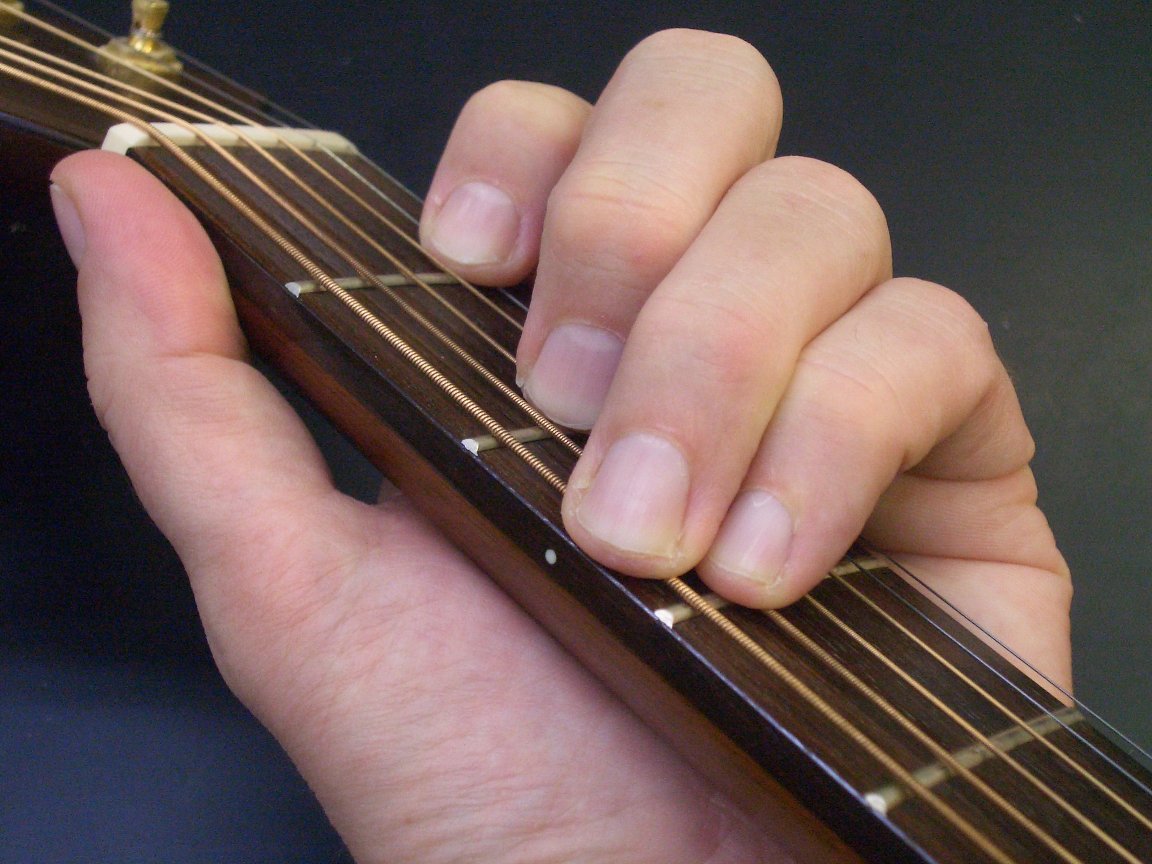 A player performing a chord (combination of many different notes) on a guitar Harmony refers to the "vertical" sounds of pitches in music, which means pitches that are played or sung together at the same time to create a chord. Usually, this means the notes are played at the same time, although harmony may also be implied by a melody that outlines a harmonic structure (i.e., by using melody notes that are played one after the other, outlining the notes of a chord). In music written using the system of major-minor tonality ("keys"), which includes most classical music written from 1600 to 1900 and most Western pop, rock, and traditional music, the key of a piece determines the "home note" or tonic to which the piece generally resolves, and the character (e.g. major or minor) of the scale in use. Simple classical pieces and many pop and traditional music songs are written so that all the music is in a single key. More complex Classical, pop, and traditional music songs and pieces may have two keys (and in some cases three or more keys). Classical music from the Romantic era (written from about 1820–1900) often contains multiple keys,[94] as does jazz, especially Bebop jazz from the 1940s, in which the key or "home note" of a song may change every four bars or even every two bars.[95] Rhythm Main article: Rhythm Rhythm is the arrangement of sounds and silences in time. Meter animates time in regular pulse groupings, called measures or bars, which in Western classical, popular, and traditional music often group notes in sets of two (e.g., 2/4 time), three (e.g., 3/4 time, also known as Waltz time, or 3/8 time), or four (e.g., 4/4 time). Meters are made easier to hear because songs and pieces often (but not always) place an emphasis on the first beat of each grouping. Notable exceptions exist, such as the backbeat used in much Western pop and rock, in which a song that uses a measure that consists of four beats (called 4/4 time or common time) will have accents on beats two and four, which are typically performed by the drummer on the snare drum, a loud and distinctive-sounding percussion instrument. In pop and rock, the rhythm parts of a song are played by the rhythm section, which includes chord-playing instruments (e.g., electric guitar, acoustic guitar, piano, or other keyboard instruments), a bass instrument (typically electric bass or for some styles such as jazz and bluegrass, double bass) and a drum kit player.[96] Texture Main article: Texture (music) Musical texture is the overall sound of a piece of music or song. The texture of a piece or song is determined by how the melodic, rhythmic, and harmonic materials are combined in a composition, thus determining the overall nature of the sound in a piece. Texture is often described in regard to the density, or thickness, and range, or width, between lowest and highest pitches, in relative terms as well as more specifically distinguished according to the number of voices, or parts, and the relationship between these voices (see common types below). For example, a thick texture contains many 'layers' of instruments. One layer can be a string section or another brass. The thickness is affected by the amount and the richness of the instruments.[97] Texture is commonly described according to the number of and relationship between parts or lines of music: monophony: a single melody (or "tune") with neither instrumental accompaniment nor a harmony part. A mother singing a lullaby to her baby would be an example. heterophony: two or more instruments or singers playing/singing the same melody, but with each performer slightly varying the rhythm or speed of the melody or adding different ornaments to the melody. Two bluegrass fiddlers playing the same traditional fiddle tune together will typically each vary the melody by some degree and each add different ornaments. polyphony: multiple independent melody lines that interweave together, which are sung or played at the same time. Choral music written in the Renaissance music era was typically written in this style. A round, which is a song such as "Row, Row, Row Your Boat", which different groups of singers all start to sing at a different time, is an example of polyphony. homophony: a clear melody supported by chordal accompaniment. Most Western popular music songs from the 19th century onward are written in this texture. Music that contains a large number of independent parts (e.g., a double concerto accompanied by 100 orchestral instruments with many interweaving melodic lines) is generally said to have a "thicker" or "denser" texture than a work with few parts (e.g., a solo flute melody accompanied by a single cello). Timbre Main article: Timbre  Spectrogram of the first second of an E9 suspended chord played on a Fender Stratocaster guitar. Below is the E9 suspended chord audio: Duration: 13 seconds.0:13 Timbre, sometimes called "color" or "tone color" is the quality or sound of a voice or instrument.[98] Timbre is what makes a particular musical sound different from another, even when they have the same pitch and loudness. For example, a 440 Hz A note sounds different when it is played on oboe, piano, violin, or electric guitar. Even if different players of the same instrument play the same note, their notes might sound different due to differences in instrumental technique (e.g., different embouchures), different types of accessories (e.g., mouthpieces for brass players, reeds for oboe and bassoon players) or strings made out of different materials for string players (e.g., gut strings versus steel strings). Even two instrumentalists playing the same note on the same instrument (one after the other) may sound different due to different ways of playing the instrument (e.g., two string players might hold the bow differently). The physical characteristics of sound that determine the perception of timbre include the spectrum, envelope, and overtones of a note or musical sound. For electric instruments developed in the 20th century, such as electric guitar, electric bass and electric piano, the performer can also change the tone by adjusting equalizer controls, tone controls on the instrument, and by using electronic effects units such as distortion pedals. The tone of the electric Hammond organ is controlled by adjusting drawbars. Expression Expressive qualities are those elements in music that create change in music without changing the main pitches or substantially changing the rhythms of the melody and its accompaniment. Performers, including singers and instrumentalists, can add musical expression to a song or piece by adding phrasing, by adding effects such as vibrato (with voice and some instruments, such as guitar, violin, brass instruments, and woodwinds), dynamics (the loudness or softness of piece or a section of it), tempo fluctuations (e.g., ritardando or accelerando, which are, respectively slowing down and speeding up the tempo), by adding pauses or fermatas on a cadence, and by changing the articulation of the notes (e.g., making notes more pronounced or accented, by making notes more legato, which means smoothly connected, or by making notes shorter). Expression is achieved through the manipulation of pitch (such as inflection, vibrato, slides etc.), volume (dynamics, accent, tremolo etc.), duration (tempo fluctuations, rhythmic changes, changing note duration such as with legato and staccato, etc.), timbre (e.g. changing vocal timbre from a light to a resonant voice) and sometimes even texture (e.g. doubling the bass note for a richer effect in a piano piece). Expression therefore can be seen as a manipulation of all elements to convey "an indication of mood, spirit, character etc."[99] and as such cannot be included as a unique perceptual element of music,[100] although it can be considered an important rudimentary element of music. Form See also: Binary form, Ternary form, and Development (music)  Sheet music notation for the chorus (refrain) of the Christmas song "Jingle Bells" Jingle Bells refrain vector.midⓘ In music, form describes the overall structure or plan of a song or piece of music,[101] and it describes the layout of a composition as divided into sections.[102] In the early 20th century, Tin Pan Alley songs and Broadway musical songs were often in AABA thirty-two-bar form, in which the A sections repeated the same eight bar melody (with variation) and the B section provided a contrasting melody or harmony for eight bars. From the 1960s onward, Western pop and rock songs are often in verse-chorus form, which comprises a sequence of verse and chorus ("refrain") sections, with new lyrics for most verses and repeating lyrics for the choruses. Popular music often makes use of strophic form, sometimes in conjunction with the twelve bar blues.[103] In the tenth edition of The Oxford Companion to Music, Percy Scholes defines musical form as "a series of strategies designed to find a successful mean between the opposite extremes of unrelieved repetition and unrelieved alteration."[104] Examples of common forms of Western music include the fugue, the invention, sonata-allegro, canon, strophic, theme and variations, and rondo. Scholes states that European classical music had only six stand-alone forms: simple binary, simple ternary, compound binary, rondo, air with variations, and fugue (although musicologist Alfred Mann emphasized that the fugue is primarily a method of composition that has sometimes taken on certain structural conventions.[105]) Where a piece cannot readily be broken into sectional units (though it might borrow some form from a poem, story or programme), it is said to be through-composed. Such is often the case with a fantasia, prelude, rhapsody, etude (or study), symphonic poem, Bagatelle, impromptu or similar compostion.[106] Professor Charles Keil classified forms and formal detail as "sectional, developmental, or variational."[107] |
エレメント 主な記事 音楽の要素 音楽には様々な基礎や要素がある。要素」の定義にもよるが、ピッチ、拍子、テンポ、リズム、メロディー、ハーモニー、テクスチャー、スタイル、声部の配 分、音色や色彩、ダイナミクス、表現、アーティキュレーション、形式、構造などが含まれる。音楽の要素は、オーストラリア、イギリス、アメリカの音楽カリ キュラムで大きく取り上げられている。この3つのカリキュラムはすべて、音程、ダイナミクス、音色、テクスチャーを要素として挙げていますが、それ以外の 音楽の要素については、普遍的な合意には程遠いものです。以下は、3つの公式バージョンの「音楽の要素」のリストです: オーストラリア:音程、音色、テクスチュア、ダイナミクスと表現、リズム、形式と構造[84]。 イギリス:音程、音色、質感、ダイナミクス、持続時間、テンポ、構造[85]。 アメリカ:音程、音色、テクスチャー、ダイナミクス、リズム、形式、ハーモニー、スタイル/アーティキュレーション[86]。 イギリスのカリキュラムに関連して、2013年に用語が追加された: 「適切な楽譜 "という用語が要素のリストに追加され、リストのタイトルが "音楽の要素 "から "音楽の相互に関連する次元 "に変更された。音楽の相互に関連する次元とは、音程、持続時間、強弱、テンポ、音色、テクスチュア、構造、適切な楽譜のことである[87]。 音楽の要素」というフレーズは、さまざまな文脈で使われる。最も一般的な2つの文脈は、「音楽の初歩的要素」と「音楽の知覚的要素」と表現することで区別 することができる[n 4]。 音程 主な記事 音程 (音楽) 音程とは、ある楽音、音符、音色が他の楽音、音符、音色よりも「高い」か「低い」かを反映する、私たちが聴き取ることができる音の側面です。例えば、ピッ コロの突き抜けるような高い音や口笛のような音色が、バスドラムの深く響く音よりも高いピッチに聴こえるように、私たちはピッチの高低についてより一般的 な意味で話すことができます。また、音楽のメロディー、ベースライン、コードに関連する正確な意味でのピッチについても話します。正確なピッチは、ノイズ と区別できるほど明確で安定した周波数を持つ音でのみ決定できる。例えば、ピアノの単音のピッチを聞き分けるのは、クラッシュ・シンバルを叩いたときの ピッチを聞き分けるよりもはるかに簡単である[92]。 旋律 主な記事 メロディ  伝統的な曲「Pop Goes The Weasel」のメロディ。 メロディーは「チューン」とも呼ばれ、一連の音程(音符)のことで、多くの場合、上昇と下降のパターンで連続して(次々に)鳴る。メロディの音符は通常、 音階やモードなどの音程体系を使って作られる。また、メロディーには、その曲で使われている和音の音も含まれていることが多い。単純なフォークソングや伝 統的な歌謡曲のメロディーは、ある曲のトニック音や調に関連する音階という単一の音階の音だけを使うことがある。例えば、ハ調(ハ長調とも呼ばれる)の民 謡では、ハ長調の音階(C、D、E、F、G、A、B、Cの各音。一方、1940年代のビ・バップ時代のジャズや、20世紀や21世紀の現代音楽では、半音 階的な音符(つまり、半音階的な音符以外の音符)を多用したメロディーを使うことがある、 ピアノでは、半音階は「白い音」や「黒い音」、全音階(C調の全音階は、C、D、E、F♯、G♯、A♯の音を含む)など、鍵盤上のすべての音を含む。コン トラバス、エレクトリック・ベース、チューバなどの低音楽器によって演奏される低音楽線はベースラインと呼ばれる[93]。 ハーモニー 主な記事 ハーモニー  ギターでコード(様々な音の組み合わせ)を演奏する奏者 ハーモニーとは、音楽における音程の「縦」の音のことで、和音を作るために同時に演奏されたり歌われたりする音程を意味する。通常、これは音符が同時に演 奏されることを意味するが、和声は、和声構造の輪郭を描く旋律(すなわち、和音の音符の輪郭を描きながら次々と演奏される旋律音)によって暗示されること もある。1600年から1900年に書かれたほとんどのクラシック音楽と、西洋のポップス、ロック、伝統音楽のほとんどを含む、メジャー・マイナー調性 (「キー」)のシステムを使って書かれた音楽では、曲のキーは、曲が一般的に解決する「ホームノート」またはトニックと、使用されるスケールの特徴(例え ば、メジャーまたはマイナー)を決定します。簡単なクラシックの曲や、ポップスや伝統音楽の曲の多くは、すべての音楽が1つの調になるように書かれていま す。より複雑なクラシック、ポップス、伝統音楽の曲や作品には、2つのキー(場合によっては3つ以上のキー)があります。ジャズ、特に1940年代のビ バップ・ジャズでは、曲のキーまたは「ホーム・ノート」が4小節ごと、あるいは2小節ごとに変わることがある[95]。 リズム 主な記事 リズム リズムは時間における音と沈黙の配列である。西洋のクラシック音楽、ポピュラー音楽、伝統音楽では、小節または小節と呼ばれる規則的な脈拍のまとまりで時 間を表現し、2つ(例えば2/4拍子)、3つ(例えば3/4拍子、ワルツ拍子や3/8拍子とも呼ばれる)、または4つ(例えば4/4拍子)で音符をまとめ ることが多い。歌や曲では、各グループの最初の拍が強調されることが多いため(必ずしもそうとは限りません)、拍子が聞き取りやすくなっています。4拍子 (4/4拍子またはコモンタイムと呼ばれる)で構成される小節を使用する曲では、2拍目と4拍目にアクセントがあり、これは通常、ドラマーがスネアドラム (大きな音を出す特徴的な打楽器)で演奏します。ポップスやロックでは、曲のリズム・パートはリズム・セクションによって演奏される。リズム・セクション には、コードを演奏する楽器(エレキ・ギター、アコースティック・ギター、ピアノ、その他の鍵盤楽器など)、ベース楽器(通常はエレキ・ベース、ジャズや ブルーグラスなどのスタイルではコントラバス)、ドラム・キット奏者が含まれる[96]。 テクスチャー 主な記事 テクスチャー(音楽) 音楽の質感(テクスチャー)とは、楽曲の全体的な音のことである。楽曲のテクスチャーは、メロディック、リズム、ハーモニーの素材がどのように作曲の中で 組み合わされるかによって決定される。テクスチャーはしばしば、最低音と最高音の間の密度(厚み)、音域(幅)に関して、相対的な用語で説明されるだけで なく、声部(パート)の数とこれらの声部間の関係によって、より具体的に区別されます(以下の一般的なタイプを参照)。例えば、分厚いテクスチュアは、多 くの楽器の "層 "を含んでいる。ある層は弦楽器セクションであったり、別の金管楽器であったりします。厚みは楽器の量と豊かさに影響されます[97]。テクスチュアは一 般的に、パートや楽節の数と関係によって表現されます: モノフォニー:楽器の伴奏も和声パートもない単一の旋律(または「曲」)。母親が赤ちゃんに子守唄を歌うのがその例。 ヘテロフォニー:2つ以上の楽器や歌手が、同じメロディーを演奏したり歌ったりするが、それぞれの演奏者がメロディーのリズムやスピードを微妙に変えた り、メロディーに異なる装飾を加えたりすること。2人のブルーグラス・フィドラーが同じ伝統的なフィドル・チューンを一緒に演奏する場合、通常、それぞれ がメロディをある程度変化させ、異なる装飾を加える。 ポリフォニー(polyphony): 複数の独立した旋律線が織り成す、同時に歌われたり演奏されたりすること。ルネサンス音楽時代に書かれた合唱曲は、一般的にこのスタイルで書かれている。 Row, Row, Row Your Boat "のように、異なるグループの歌手が一斉に歌い始めるラウンドは、ポリフォニーの一例である。 ホモフォニー:和音伴奏に支えられた明確なメロディー。19世紀以降の西洋ポピュラー音楽の歌のほとんどは、このテクスチャーで書かれている。 多数の独立したパートを含む音楽(例えば、多くの旋律線が織り成す100の管弦楽器が伴奏する二重協奏曲)は、一般に、パートが少ない作品(例えば、1つ のチェロが伴奏するフルート独奏の旋律)よりも「厚い」または「濃い」テクスチュアを持つと言われる。 音色 主な記事 音色  フェンダー・ストラトキャスター・ギターで演奏されたE9サスペンデッド・コードの最初の1秒のスペクトログラム。以下はE9のサスペンデッド・コードの オーディオ: 演奏時間: 13秒0:13 ティンブル(Timbre)とは、「色」や「音色」と呼ばれることもある、声や楽器の音質や響きのことです[98] ティンブルは、同じピッチとラウドネスを持つ特定の楽音を、他の楽音と異なるものにするものです。例えば、440HzのA音は、オーボエ、ピアノ、ヴァイ オリン、エレキギターで演奏されると異なる音に聞こえる。同じ楽器の奏者が同じ音を吹いても、楽器の奏法の違い(アンブシュアの違いなど)、付属品の種類 の違い(金管楽器奏者のマウスピース、オーボエやファゴット奏者のリードなど)、弦楽器奏者の弦の材質の違い(ガット弦とスチール弦など)により、音が 違って聞こえることがあります。また、同じ楽器で同じ音を演奏する2人の奏者でも、楽器の弾き方が違う(例えば、弦楽器奏者同士では弓の持ち方が違う)た めに、音が違って聞こえることがあります。 音色の知覚を決定する音の物理的特性には、音符や楽音のスペクトル、エンベロープ、倍音が含まれます。エレクトリック・ギター、エレクトリック・ベース、 エレクトリック・ピアノなど、20世紀に開発されたエレクトリック楽器では、演奏者はイコライザーや楽器のトーン・コントロールを調整したり、ディストー ション・ペダルなどの電子エフェクターを使ったりして音色を変えることもできる。エレクトリック・ハモンド・オルガンの音色は、ドローバーの調整によって コントロールされる。 表現 表現力とは、主要な音程を変えたり、旋律やその伴奏のリズムを大きく変えたりすることなく、音楽に変化をもたらす音楽の要素のことです。歌手や器楽奏者を 含む演奏者は、フレージングを加えたり、ビブラート(声楽や、ギター、バイオリン、金管楽器、木管楽器など一部の楽器で)、ダイナミクス(曲や曲の一部分 の大きさや柔らかさ)、テンポの揺らぎ(リタルダンドやアッチェレランド、テンポの変化など)といった効果を加えることで、曲や楽曲に音楽的な表現を加え ることができます、 例えば、リタルダンドやアッチェレランド(それぞれ、テンポを遅くしたり速くしたりすること)、カデンツにポーズやフェルマータを加えること、音符のアー ティキュレーションを変えること(例えば、音符をより強調したりアクセントをつけたり、音符をよりレガート(滑らかにつながることを意味する)にしたり、 音符を短くしたりすること)。 表現は、音程(抑揚、ビブラート、スライドなど)、音量(ダイナミクス、アクセント、トレモロなど)、持続時間(テンポの変動、リズムの変化、レガートや スタッカートなど音符の長さの変化など)、音色(ボーカルの音色を軽やかな声から響きのある声に変えるなど)、時には質感(ピアノ曲で低音を倍増させて豊 かな効果を出すなど)の操作によって達成されます。したがって、表現とは、「気分、精神、性格などを示すもの」[99]を伝えるためのあらゆる要素の操作 とみなすことができ、音楽の重要な初歩的要素とみなすことはできるものの、音楽の独自の知覚的要素として含めることはできない[100]。 形式 以下も参照: 二進法、三部形式、展開法(音楽)  クリスマスソング「Jingle Bells」のコーラス(リフレイン)の楽譜 Jingle Bells refrain vector.midⓘ. 20世紀初頭、ティン・パン・アレイの歌やブロードウェイのミュージカル・ソングは、Aセクションが同じ8小節のメロディを繰り返し(バリエーションもあ る)、Bセクションが対照的なメロディやハーモニーを8小節提供するAABA32小節形式であることが多かった[102]。1960年代以降の欧米のポッ プスやロックは、詩とコーラス(「リフレイン」)のセクションが連続するヴァース・コーラス形式が多く、ほとんどのヴァースでは新しい歌詞が、コーラスで は繰り返しの歌詞が使われる。ポピュラー音楽はしばしば、12小節のブルースと組み合わせて、ストロフ形式を用いることがある[103]。 オックスフォード・コンパニオン・トゥ・ミュージック』の第10版において、パーシー・ショールズは音楽形式を「緩和されない反復と緩和されない変化とい う正反対の両極端の間に成功する平均を見出すために考案された一連の戦略」と定義している[104]。西洋音楽の一般的な形式の例としては、フーガ、イン ヴェンション、ソナタ=アレグロ、カノン、ストロフート、主題と変奏、ロンドなどが挙げられる。 ショールズは、ヨーロッパの古典音楽には、単純二進法、単純三進法、複合二進法、ロンド、変奏付き空気、フーガの6つの独立した形式しかなかったと述べて いる(ただし、音楽学者のアルフレッド・マンは、フーガは主に作曲の方法であり、ある種の構造的な慣習を取り入れることもあったと強調している [105])。 楽曲が容易にセクション単位に分割できない場合(詩、物語、プログラムから何らかの形式を借りている可能性はあるが)、それは貫通作曲と言われる。ファン タジア、前奏曲、狂詩曲、エチュード(または習作)、交響詩、バガテル、即興曲、または同様のコンポジションがそうであることが多い[106]。シャル ル・ケイル教授は、形式と形式的な詳細を「区分的、発展的、変奏的」に分類した[107]。 |
| Philosophy Main article: Philosophy of music 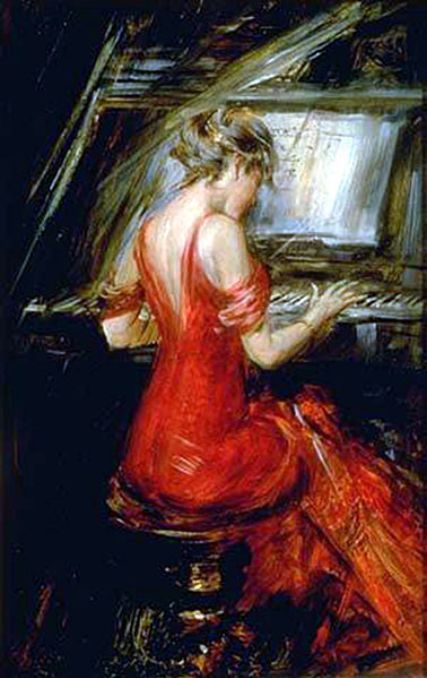 The Woman in Red by Giovanni Boldini The philosophy of music is the study of fundamental questions regarding music and has connections with questions in metaphysics and aesthetics. Questions include: What is the definition of music? (What are the necessary and sufficient conditions for classifying something as music?) What is the relationship between music and mind? What does music history reveal to us about the world? What is the connection between music and emotions? What is meaning in relation to music? In ancient times, such as with the Ancient Greeks, the aesthetics of music explored the mathematical and cosmological dimensions of rhythmic and harmonic organization. In the 18th century, focus shifted to the experience of hearing music, and thus to questions about its beauty and human enjoyment (plaisir and jouissance) of music. The origin of this philosophic shift is sometimes attributed to Alexander Gottlieb Baumgarten in the 18th century, followed by Immanuel Kant. Through their writing, the ancient term 'aesthetics', meaning sensory perception, received its present-day connotation. In the 2000s, philosophers have tended to emphasize issues besides beauty and enjoyment. For example, music's capacity to express emotion has been foregrounded. [108] In the 20th century, important contributions were made by Peter Kivy, Jerrold Levinson, Roger Scruton, and Stephen Davies. However, many musicians, music critics, and other non-philosophers have contributed to the aesthetics of music. In the 19th century, a significant debate arose between Eduard Hanslick, a music critic and musicologist, and composer Richard Wagner regarding whether music can express meaning. Harry Partch and some other musicologists, such as Kyle Gann, have studied and tried to popularize microtonal music and the usage of alternate musical scales. Modern composers like La Monte Young, Rhys Chatham and Glenn Branca paid much attention to a scale called just intonation.[109][110][111] It is often thought that music has the ability to affect our emotions, intellect, and psychology; it can assuage our loneliness or incite our passions. The philosopher Plato suggests in The Republic that music has a direct effect on the soul. Therefore, he proposes that in the ideal regime music would be closely regulated by the state (Book VII).[112] In Ancient China, the philosopher Confucius believed that music and rituals or rites are interconnected and harmonious with nature; he stated that music was the harmonization of heaven and earth, while the order was brought by the rites order, making them extremely crucial functions in society.[113] |
哲学 主な記事 音楽哲学  ジョヴァンニ・ボルディーニ作「赤い服の女」 音楽哲学とは、音楽に関する根本的な問題を研究する学問であり、形而上学や美学における問題とも関連している。疑問には以下のようなものがある: 音楽の定義とは何か?(何かを音楽として分類するための必要十分条件は何か?) 音楽と心の関係は? 音楽の歴史は世界について何を明らかにしているのか? 音楽と感情の関係とは? 音楽における意味とは何か? 古代ギリシャのような古代では、音楽の美学はリズムや和声の構成が持つ数学的・宇宙論的な次元を探求していた。18世紀には、音楽を聴くという体験に焦点 が移り、その結果、音楽の美しさや人間の音楽の楽しみ(プレジールやジュイサンス)に関する問題に焦点が当てられるようになった。この哲学的な転換の起源 は、18世紀のアレクサンダー・ゴットリープ・バウムガルテンと、それに続くイマヌエル・カントとされることがある。彼らの著作を通じて、感覚的知覚を意 味する古代の用語「美学」は、今日の意味合いを持つようになった。2000年代に入ると、哲学者は美や楽しみ以外の問題を強調する傾向にある。例えば、音 楽が感情を表現する能力が強調されるようになった。[108] 20世紀には、ピーター・キヴィ、ジェロルド・レビンソン、ロジャー・スクルトン、スティーヴン・デイヴィスによって重要な貢献がなされた。しかし、多く の音楽家、音楽評論家、その他の非哲学者も音楽の美学に貢献している。19世紀には、音楽評論家で音楽学者のエドゥアルド・ハンスリックと作曲家のリヒャ ルト・ワーグナーの間で、音楽が意味を表現できるかどうかに関して重要な議論が起こった。ハリー・パーチやカイル・ギャンなどの音楽学者たちは、微分音音 楽や代替音階の使用法を研究し、その普及に努めた。ラ・モンテ・ヤング、リース・チャサム、グレン・ブランカのような現代の作曲家たちは、ジャスト・イン トネーションと呼ばれる音階に多くの注意を払っている[109][110][111]。 音楽は私たちの感情、知性、心理に影響を与える能力があるとしばしば考えられている。哲学者プラトンは『共和国』の中で、音楽は魂に直接的な影響を与える と示唆している。そのため、彼は理想的な体制においては音楽は国家によって密接に規制されることを提案している(第七書)[112]。古代中国において、 哲学者の孔子は音楽と儀式や儀礼は相互に関連し、自然と調和していると考えていた。彼は、音楽は天と地の調和であり、秩序は儀式の秩序によってもたらさ れ、それらは社会における極めて重要な機能であると述べている[113]。 |
| Psychology Main article: Music psychology Modern music psychology aims to explain and understand musical behavior and experience.[114] Research in this field and its subfields are primarily empirical; their knowledge tends to advance on the basis of interpretations of data collected by systematic observation of and interaction with human participants. In addition to its focus on fundamental perceptions and cognitive processes, music psychology is a field of research with practical relevance for many areas, including music performance, composition, education, criticism, and therapy, as well as investigations of human aptitude, skill, intelligence, creativity, and social behavior. Neuroscience Main article: Neuroscience of music 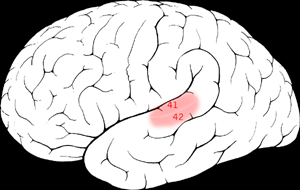 The primary auditory cortex is one of the main areas associated with superior pitch resolution. Cognitive neuroscience of music is the scientific study of brain-based mechanisms involved in the cognitive processes underlying music. These behaviours include music listening, performing, composing, reading, writing, and ancillary activities. It also is increasingly concerned with the brain basis for musical aesthetics and musical emotion. The field is distinguished by its reliance on direct observations of the brain, using such techniques as functional magnetic resonance imaging (fMRI), transcranial magnetic stimulation (TMS), magnetoencephalography (MEG), electroencephalography (EEG), and positron emission tomography (PET). Cognitive musicology Main article: Cognitive musicology Cognitive musicology is a branch of cognitive science concerned with computationally modeling musical knowledge with the goal of understanding both music and cognition.[115] The use of computer models provides an exacting, interactive medium in which to formulate and test theories and has roots in artificial intelligence and cognitive science.[116] This interdisciplinary field investigates topics such as the parallels between language and music in the brain. Biologically inspired models of computation are often included in research, such as neural networks and evolutionary programs.[117] This field seeks to model how musical knowledge is represented, stored, perceived, performed, and generated. By using a well-structured computer environment, the systematic structures of these cognitive phenomena can be investigated.[118] Psychoacoustics Main article: Psychoacoustics Psychoacoustics is the scientific study of sound perception. More specifically, it is the branch of science studying the psychological and physiological responses associated with sound (including speech and music). It can be further categorized as a branch of psychophysics. Evolutionary musicology Main article: Evolutionary musicology Evolutionary musicology concerns the "origins of music, the question of animal song, selection pressures underlying music evolution", and "music evolution and human evolution".[119] It seeks to understand music perception and activity in the context of evolutionary theory. Charles Darwin speculated that music may have held an adaptive advantage and functioned as a protolanguage,[120] a view which has spawned several competing theories of music evolution.[121][122][page needed][123] An alternate view sees music as a by-product of linguistic evolution; a type of "auditory cheesecake" that pleases the senses without providing any adaptive function.[124] This view has been directly countered by numerous music researchers.[125][126][127] Cultural effects Main article: Culture in music cognition An individual's culture or ethnicity plays a role in their music cognition, including their preferences, emotional reaction, and musical memory. Musical preferences are biased toward culturally familiar musical traditions beginning in infancy, and adults' classification of the emotion of a musical piece depends on both culturally specific and universal structural features.[128][129] Additionally, individuals' musical memory abilities are greater for culturally familiar music than for culturally unfamiliar music.[130][131] Perceptual Since the emergence of the study of psychoacoustics in the 1930s, most lists of elements of music have related more to how we hear music than how we learn to play it or study it. C.E. Seashore, in his book Psychology of Music,[132] identified four "psychological attributes of sound". These were: "pitch, loudness, time, and timbre" (p. 3). He did not call them the "elements of music" but referred to them as "elemental components" (p. 2). Nonetheless, these elemental components link precisely with four of the most common musical elements: "Pitch" and "timbre" match exactly, "loudness" links with dynamics, and "time" links with the time-based elements of rhythm, duration, and tempo. This usage of the phrase "the elements of music" links more closely with Webster's New 20th Century Dictionary definition of an element as: "a substance which cannot be divided into a simpler form by known methods"[133] and educational institutions' lists of elements generally align with this definition as well. Although writers of lists of "rudimentary elements of music" can vary their lists depending on their personal (or institutional) priorities, the perceptual elements of music should consist of an established (or proven) list of discrete elements which can be independently manipulated to achieve an intended musical effect. It seems at this stage that there is still research to be done in this area. A slightly different way of approaching the identification of the elements of music, is to identify the "elements of sound" as: pitch, duration, loudness, timbre, sonic texture and spatial location,[134] and then to define the "elements of music" as: sound, structure, and artistic intent.[134] |
心理学 主な記事 音楽心理学 現代の音楽心理学は、音楽的な行動や経験を説明し理解することを目的としている[114]。この分野とその下位分野の研究は主に経験的であり、その知識 は、人間の参加者の体系的な観察と相互作用によって収集されたデータの解釈に基づいて進歩する傾向がある。音楽心理学は、基本的な知覚や認知過程に焦点を 当てるだけでなく、人間の適性、技能、知能、創造性、社会的行動に関する調査だけでなく、音楽演奏、作曲、教育、批評、治療など、多くの分野で実用的な関 連性を持つ研究分野である。 神経科学 主な記事 音楽の神経科学  一次聴覚野は、優れた音程分解能に関連する主要な領域のひとつである。 音楽の認知神経科学とは、音楽の根底にある認知プロセスに関わる脳ベースのメカニズムを科学的に研究することである。これらの行動には、音楽を聴くこと、 演奏すること、作曲すること、読むこと、書くこと、および付随的な活動が含まれる。また、音楽的美学や音楽的感情の脳科学的基盤に関する研究も増えてい る。この分野は、機能的磁気共鳴画像法(fMRI)、経頭蓋磁気刺激法(TMS)、脳磁図法(MEG)、脳波法(EEG)、陽電子放射断層法(PET)な どの技術を用いて、脳を直接観察することに依存している点が特徴である。 認知音楽学 主な記事 認知音楽学 認知音楽学は認知科学の一分野であり、音楽と認知の両方を理解することを目的として、音楽的知識を計算によってモデル化することに関係している [115]。コンピュータモデルの使用は、理論を定式化し検証するための厳密でインタラクティブな媒体を提供し、人工知能と認知科学にルーツがある [116]。 この学際的な分野では、脳における言語と音楽の類似性などが研究されている。この分野では、音楽的知識がどのように表現され、保存され、知覚され、演奏さ れ、生成されるかをモデル化しようとしている。十分に構造化されたコンピュータ環境を使用することで、これらの認知現象の体系的な構造を調査することがで きる[118]。 音響心理学 主な記事 音響心理学 音響心理学とは、音の知覚に関する科学的研究である。より具体的には、音(音声や音楽を含む)に関連する心理的・生理的反応を研究する科学の一分野であ る。心理物理学の一分野に分類される。 進化音楽学 主な記事 進化音楽学 進化音楽学は「音楽の起源、動物の歌の問題、音楽進化の根底にある淘汰圧」、「音楽の進化と人類の進化」に関わる学問である[119]。音楽の知覚と活動 を進化論の文脈で理解しようとするものである。チャールズ・ダーウィンは、音楽が適応的な利点を持ち、原言語として機能したのではないかと推測しており [120]、この見解は音楽進化に関するいくつかの競合する理論を生み出している[121][122][要ページ][123]。別の見解では、音楽は言語 進化の副産物であり、適応的な機能を提供することなく感覚を楽しませる「聴覚的チーズケーキ」の一種であると見なしている[124]。この見解は多くの音 楽研究者によって真っ向から反論されている[125][126][127]。 文化的影響 主な記事 音楽認知における文化 個人の文化や民族性は、好み、感情的反応、音楽的記憶など、音楽認知に役割を果たしている。音楽的嗜好は乳幼児期から文化的に馴染みのある伝統的な音楽へ と偏り、成人における楽曲の感情の分類は文化的に特異な特徴と普遍的な構造的特徴の両方に依存する[128][129]。さらに、個人の音楽的記憶能力は 文化的に馴染みのある音楽の方が文化的に馴染みのない音楽よりも高い[130][131]。 知覚 1930年代に音響心理学の研究が登場して以来、音楽の要素のリストのほとんどは、私たちがそれを演奏したり研究したりする方法を学ぶ方法よりも、私たち が音楽をどのように聴くかに関係している。C.E.シーショアは著書『音楽の心理学』[132]の中で、4つの「音の心理的属性」を特定した。その4つと は 「ピッチ、ラウドネス、時間、音色」(p.3)である。彼はこれらを「音楽の要素」とは呼ばず、「要素的構成要素」(p. 2)と呼んだ。それにもかかわらず、これらの要素構成要素は、最も一般的な4つの音楽要素と正確にリンクしている: 「ピッチ "と "音色 "は正確に一致し、"ラウドネス "はダイナミクスとリンクし、"タイム "はリズム、デュレーション、テンポといった時間ベースの要素とリンクする。この「音楽の要素」という言葉の使い方は、ウェブスターの新20世紀辞典によ る要素の定義とより密接にリンクしている: 「既知の方法によって、より単純な形に分割することができない物質」[133]であり、教育機関の要素リストも一般的にこの定義に沿ったものである。 音楽の初歩的な要素 "のリストを書く人は、個人的な(または組織的な)優先順位によってリストを変えるこ とができますが、音楽の知覚的要素は、意図された音楽効果を達成するために独立して操作することができ る、確立された(または証明された)個別の要素のリストで構成されるべきです。現段階では、この分野ではまだ研究が必要だと思われる。 音楽の要素の特定にアプローチする少し異なる方法は、「音の要素」をピッチ、持続時間、ラウドネス、音色、音の質感、空間的位置と特定し[134]、次に 「音楽の要素」を音、構造、芸術的意図と定義することである[134]。 |
| Sociological aspects Main article: Sociomusicology  Song dynasty (960–1279) painting, Night Revels of Han Xizai, showing Chinese musicians entertaining guests at a party in a 10th-century household Ethnographic studies demonstrate that music is a participatory, community-based activity.[135][136] Music is experienced by individuals in a range of social settings from being alone, to attending a large concert, forming a music community, which cannot be understood as a function of individual will or accident; it includes both commercial and non-commercial participants with a shared set of common values. Musical performances take different forms in different cultures and socioeconomic milieus. In Europe and North America, there was a divide between what types of music were viewed as "high culture" and "low culture." "High culture" included Baroque, Classical, Romantic, and modern-era symphonies, concertos, and solo works, and are typically heard in formal concerts in concert halls and churches, with the audience sitting quietly. Other types of music—including jazz, blues, soul, and country—are often performed in bars, nightclubs, and theatres, where the audience may drink, dance and cheer. Until the 20th century, the division between "high" and "low" musical forms was accepted as a valid distinction that separated out "art music", from popular music heard in bars and dance halls. Musicologists, such as David Brackett, note a "redrawing of high-low cultural-aesthetic boundaries" in the 20th century.[137] And, "when industry and public discourses link categories of music with categories of people, they tend to conflate stereotypes with actual listening communities."[137] Stereotypes can be based on socioeconomic standing, or social class, of the performers or audience of the different types of music. When composers introduce styles of music that break with convention, there can be strong resistance from academics and others. Late-period Beethoven string quartets, Stravinsky ballet scores, serialism, bebop, hip hop, punk rock, and electronica were controversial and criticised, when they were first introduced. Such themes are examined in the sociology of music, sometimes called sociomusicology, which is pursued in departments of sociology, media studies, or music, and is closely related to ethnomusicology. Role of women Main article: Women in music 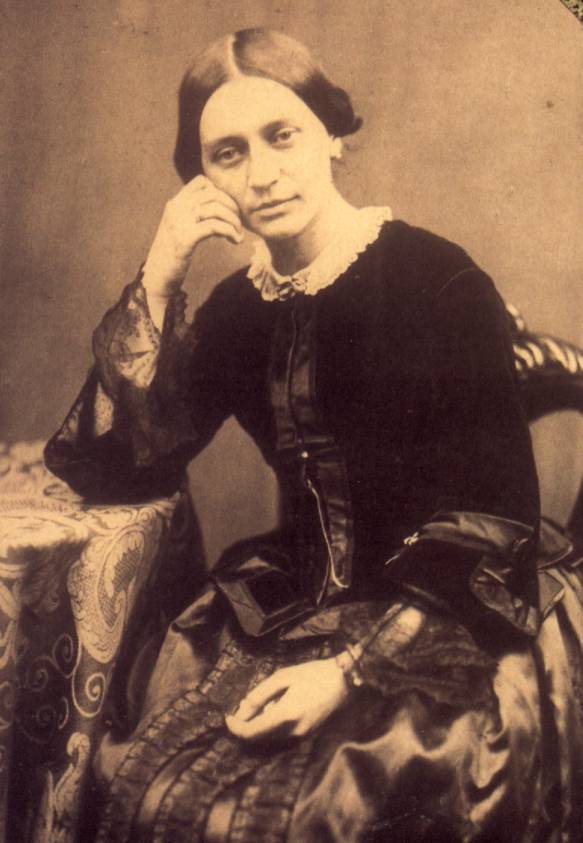 19th-century composer and pianist Clara Schumann Women have played a major role in music throughout history, as composers, songwriters, instrumental performers, singers, conductors, music scholars, music educators, music critics/music journalists and other musical professions. In the 2010s, while women comprise a significant proportion of popular music and classical music singers, and a significant proportion of songwriters (many of them being singer-songwriters), there are few women record producers, rock critics and rock instrumentalists. Although there have been a huge number of women composers in classical music, from the medieval period to the present day, women composers are significantly underrepresented in the commonly performed classical music repertoire, music history textbooks and music encyclopedias; for example, in the Concise Oxford History of Music, Clara Schumann is one of the few female composers who is mentioned. Women comprise a significant proportion of instrumental soloists in classical music and the percentage of women in orchestras is increasing. A 2015 article on concerto soloists in major Canadian orchestras, however, indicated that 84% of the soloists with the Orchestre Symphonique de Montreal were men. In 2012, women still made up just 6% of the top-ranked Vienna Philharmonic orchestra. Women are less common as instrumental players in popular music genres such as rock and heavy metal, although there have been a number of notable female instrumentalists and all-female bands. Women are particularly underrepresented in extreme metal genres.[138] In the 1960s pop-music scene, "[l]ike most aspects of the...music business, [in the 1960s,] songwriting was a male-dominated field. Though there were plenty of female singers on the radio, women ...were primarily seen as consumers:... Singing was sometimes an acceptable pastime for a girl, but playing an instrument, writing songs, or producing records simply wasn't done."[139] Young women "...were not socialized to see themselves as people who create [music]."[139] Women are also underrepresented in orchestral conducting, music criticism/music journalism, music producing, and sound engineering. While women were discouraged from composing in the 19th century, and there are few women musicologists, women became involved in music education "...to such a degree that women dominated [this field] during the later half of the 19th century and well into the 20th century."[140] According to Jessica Duchen, a music writer for London's The Independent, women musicians in classical music are "...too often judged for their appearances, rather than their talent" and they face pressure "...to look sexy onstage and in photos."[141] Duchen states that while "[t]here are women musicians who refuse to play on their looks,...the ones who do tend to be more materially successful."[141] According to the UK's Radio 3 editor, Edwina Wolstencroft, the music industry has long been open to having women in performance or entertainment roles, but women are much less likely to have positions of authority, such as being the conductor of an orchestra.[142] In popular music, while there are many women singers recording songs, there are very few women behind the audio console acting as music producers, the individuals who direct and manage the recording process.[143] One of the most recorded artists is Asha Bhosle, an Indian singer best known as a playback singer in Hindi cinema.[144] |
社会学的側面 主な記事 社会音楽学  宋代(960-1279年)の絵画『韓西斎夜宴』(10世紀の家庭のパーティーで客をもてなす中国の音楽家を描く 音楽は、一人でいるときから大規模なコンサートに参加するときまで、さまざまな社会的環境において個人によって経験され、音楽コミュニティを形成する。音 楽演奏は、文化や社会経済環境が異なれば、その形態も異なる。 ヨーロッパや北米では、どのような種類の音楽を "ハイカルチャー "と見なすか、"ローカルチャー "と見なすか、が分かれていた。"高文化 "には、バロック、古典、ロマン、近代の交響曲、協奏曲、独奏曲などが含まれ、一般的にはコンサートホールや教会での正式なコンサートで聴かれ、聴衆は静 かに座っている。ジャズ、ブルース、ソウル、カントリーなど他のタイプの音楽は、バー、ナイトクラブ、劇場などで演奏されることが多く、聴衆は酒を飲み、 踊り、歓声を上げることもある。20世紀までは、"高音 "と "低音 "という音楽形態の区分は、バーやダンスホールで聴かれる大衆音楽と "芸術音楽 "を分ける有効な区別として受け入れられていた。デイヴィッド・ブラケットのような音楽学者は、20世紀における「ハイ・ローの文化的・美的境界線の引き 直し」に注目している[137]。また、「業界や大衆の言説が音楽のカテゴリーを人々のカテゴリーと結びつけるとき、ステレオタイプと実際のリスニング・ コミュニティを混同する傾向がある」[137]。ステレオタイプは、異なるタイプの音楽の演奏者や聴衆の社会経済的地位や社会階級に基づいていることがあ る。 作曲家が慣習にとらわれない音楽のスタイルを導入する場合、学者やその他の人々から強い抵抗があることがある。後期ベートーヴェンの弦楽四重奏曲、ストラ ヴィンスキーのバレエ楽譜、シリアリズム、ビバップ、ヒップホップ、パンクロック、エレクトロニカなどは、導入当初は物議を醸し、批判された。このような テーマは、社会学、メディア研究、音楽学科などで研究されている音楽社会学(社会音楽学と呼ばれることもある)で研究され、民族音楽学と密接な関係があ る。 女性の役割 主な記事 音楽における女性  19世紀の作曲家でピアニストのクララ・シューマン 女性は、作曲家、作詞家、楽器演奏家、歌手、指揮者、音楽学者、音楽教育者、音楽評論家/音楽ジャーナリスト、その他の音楽専門職として、歴史を通じて音 楽界で大きな役割を果たしてきた。2010年代、ポピュラー音楽とクラシック音楽の歌手のかなりの割合を女性が占め、ソングライターのかなりの割合(多く はシンガーソングライター)を女性が占める一方で、女性のレコード・プロデューサー、ロック評論家、ロック楽器奏者はほとんどいない。クラシック音楽に は、中世から現代に至るまで非常に多くの女性作曲家がいるが、一般的に演奏されるクラシック音楽のレパートリーや音楽史の教科書、音楽事典では、女性作曲 家の占める割合が著しく低い。例えば、コンサイス・オックスフォード音楽史では、クララ・シューマンは言及されている数少ない女性作曲家の一人である。 クラシック音楽の器楽ソリストに占める女性の割合は大きく、オーケストラに占める女性の割合も増えている。しかし、カナダの主要オーケストラの協奏曲ソリ ストに関する2015年の記事によると、モントリオール交響楽団のソリストの84%は男性だった。2012年の記事でも、トップクラスのウィーン・フィル ハーモニー管弦楽団で女性が占める割合はわずか6%だった。ロックやヘビーメタルといったポピュラー音楽のジャンルでは、女性は楽器奏者としてはあまり一 般的ではないが、注目すべき女性楽器奏者や女性だけのバンドは数多く存在する。1960年代のポップ・ミュージック・シーンでは、「(1960年代には) 音楽ビジネスのほとんどの側面と同様に、ソングライティングは男性優位の分野だった。ラジオにはたくさんの女性歌手が出演していたが、女性は主に消費者と して見られていた。歌うことは少女にとって許容される娯楽であることもあったが、楽器を演奏したり、曲を書いたり、レコードをプロデュースしたりすること は、単に行われていなかった」[139]。 オーケストラの指揮、音楽批評/音楽ジャーナリズム、音楽プロデュース、サウンド・エンジニアリングの分野でも女性の割合は低い。19世紀には女性は作曲 をすることを敬遠され、女性の音楽学者はほとんどいないが、女性は音楽教育に携わるようになり、「...19世紀後半から20世紀にかけて、女性が(この 分野を)支配するほどになった」[140]。 ロンドンの『インディペンデント』紙の音楽ライター、ジェシカ・デュシェンによれば、クラシック音楽の女性音楽家は「......才能よりも外見で判断さ れることが多すぎる」し、「......ステージ上や写真でセクシーに見えるように」というプレッシャーにさらされている[141]。 「141]英国のラジオ3の編集者、エドウィナ・ウォルステンクロフトによれば、音楽業界は長い間、女性が演奏やエンターテイメントの役割を担うことに寛 容であったが、オーケストラの指揮者のような権威ある地位に女性が就くことはずっと少なかった。 [142]。ポピュラー音楽では、歌を録音している女性歌手は多いが、音楽プロデューサー、つまり録音プロセスを指揮・管理する人物として、オーディオコ ンソールの後ろで活動している女性はほとんどいない[143]。最も多く録音されているアーティストの一人は、ヒンディー語映画のプレイバックシンガーと してよく知られているインドの歌手、アーシャ・ボースルである[144]。 |
| Media and technology Further information: Computer music and Music technology 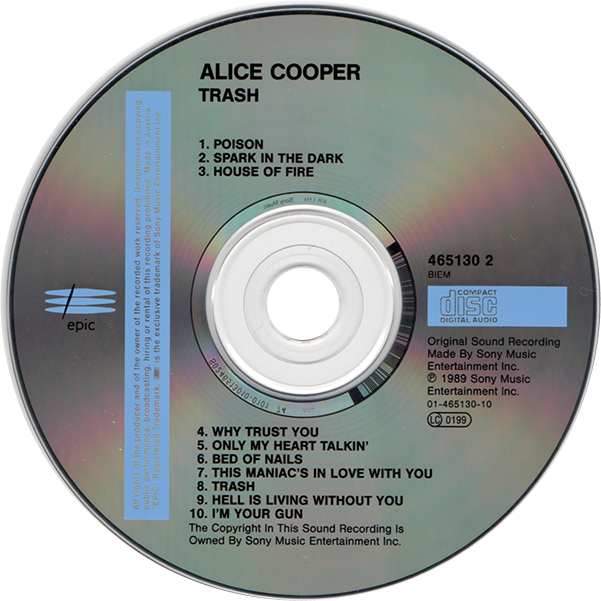 Compact Disc Digital Audio (CD-DA) revolutionized audio music formatting. It allowed for music to be played portably without the need to rewind a series of tape. The CD surpassed LP sales in 1988, and cassette tapes in 1991. By 1999, the CD accounted for 87.9% of the entire market share in regard to music sales.[145] Since the 20th century, live music can be broadcast over the radio, television or the Internet, or recorded and listened to on a CD player or MP3 player. In the early 20th century (in the late 1920s), as talking pictures emerged in the early 20th century, with their prerecorded musical tracks, an increasing number of moviehouse orchestra musicians found themselves out of work.[146] During the 1920s, live musical performances by orchestras, pianists, and theater organists were common at first-run theaters.[147] With the coming of the talking motion pictures, those featured performances were largely eliminated. The American Federation of Musicians (AFM) took out newspaper advertisements protesting the replacement of live musicians with mechanical playing devices. One 1929 ad that appeared in the Pittsburgh Press features an image of a can labeled "Canned Music / Big Noise Brand / Guaranteed to Produce No Intellectual or Emotional Reaction Whatever"[148] Sometimes, live performances incorporate prerecorded sounds. For example, a disc jockey uses disc records for scratching, and some 20th-century works have a solo for an instrument or voice that is performed along with music that is prerecorded onto a tape. Some pop bands use recorded backing tracks. Computers and many keyboards can be programmed to produce and play Musical Instrument Digital Interface (MIDI) music. Audiences can also become performers by participating in karaoke, an activity of Japanese origin centered on a device that plays voice-eliminated versions of well-known songs. Most karaoke machines also have video screens that show lyrics to songs being performed; performers can follow the lyrics as they sing over the instrumental tracks. 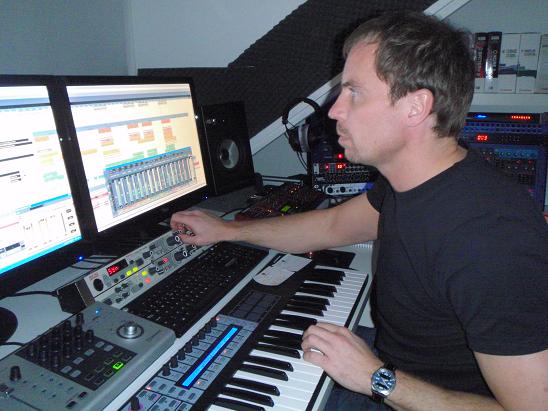 Music production in the 2000s using a digital audio workstation (DAW) with an electronic keyboard and a multi-monitor set-up The advent of the Internet and widespread high-speed broadband access has transformed the experience of music, partly through the increased ease of access to recordings of music via streaming video and vastly increased choice of music for consumers. Another effect of the Internet arose with online communities and social media websites like YouTube and Facebook, a social networking service. These sites make it easier for aspiring singers and amateur bands to distribute videos of their songs, connect with other musicians, and gain audience interest. Professional musicians also use YouTube as a free publisher of promotional material. YouTube users, for example, no longer only download and listen to MP3s, but also actively create their own. According to Don Tapscott and Anthony D. Williams, in their book Wikinomics, there has been a shift from a traditional consumer role to what they call a "prosumer" role, a consumer who both creates content and consumes. Manifestations of this in music include the production of mashes, remixes, and music videos by fans.[149] |
メディアとテクノロジー さらに詳しい情報 コンピュータ音楽と音楽技術  コンパクトディスク・デジタル・オーディオ(CD-DA)は、オーディオ音楽のフォーマットに革命をもたらした。テープを巻き戻すことなく、音楽をポータ ブルで再生できるようにしたのだ。CDは1988年にLP、1991年にはカセットテープの売上を上回った。1999年までに、CDは音楽販売に関して市 場全体の87.9%のシェアを占めるようになった[145]。 20世紀以降、生演奏はラジオ、テレビ、インターネットで放送されたり、録音されてCDプレーヤーやMP3プレーヤーで聴かれるようになった。 20世紀初頭(1920年代後半)、あらかじめ録音された音楽トラックを持つトーキング・ピクチャーズが登場すると、映画館のオーケストラ・ミュージシャ ンの数が増え、仕事がなくなることになった[146]。 1920年代、オーケストラ、ピアニスト、劇場オルガニストによる生演奏は、初回上映の映画館では一般的であった[147]。 トーキング・モーション・ピクチャーの登場により、それらの特色ある演奏はほとんどなくなった。アメリカ音楽家連盟(AFM)は、生の音楽家が機械的な演 奏装置に取って代わられることに抗議する新聞広告を出した。ピッツバーグ・プレス』紙に掲載された1929年の広告には、「缶詰の音楽/ビッグ・ノイズ・ ブランド/どんな知的反応も感情的反応も起こさないことを保証する」と書かれた缶の画像が掲載されている[148]。 ライブ・パフォーマンスには、あらかじめ録音された音が使われることもある。例えば、ディスク・ジョッキーはスクラッチ用にディスク・レコードを使うし、 20世紀の作品には、あらかじめテープに録音された音楽とともに演奏される楽器や声のソロがある。ポップ・バンドの中には、録音されたバッキング・トラッ クを使うものもある。コンピュータや多くのキーボードは、MIDI(Musical Instrument Digital Interface)音楽を制作・演奏するようにプログラムすることができる。有名な曲の声を消したバージョンを再生する装置を中心とした日本発祥のアク ティビティであるカラオケに参加することで、観客もパフォーマーになることができる。ほとんどのカラオケ機器には、演奏されている曲の歌詞を表示するビデ オ画面も付いており、演奏者はインストゥルメンタル・トラックの上で歌詞を追いながら歌うことができる。  電子キーボードとマルチモニターを備えたデジタル・オーディオ・ワークステーション(DAW)を使った2000年代の音楽制作 インターネットの登場と高速ブロードバンドアクセスの普及は、ストリーミングビデオによる音楽の録音へのアクセスが容易になり、消費者の音楽の選択肢が大 幅に増えたこともあって、音楽の体験を一変させた。インターネットのもう一つの効果は、YouTubeやソーシャル・ネットワーキング・サービスである Facebookなどのオンライン・コミュニティやソーシャルメディア・ウェブサイトによって生じた。これらのサイトでは、歌手志望者やアマチュアバンド が簡単に自分の曲のビデオを配信し、他のミュージシャンとつながり、聴衆の関心を集めることができる。また、プロのミュージシャンも、YouTubeを宣 伝材料の無料パブリッシャーとして利用している。例えば、ユーチューブのユーザーは、もはやMP3をダウンロードして聴くだけでなく、自分でも積極的に作 成する。ドン・タプスコットとアンソニー・D・ウィリアムズの著書『ウィキノミクス』によれば、伝統的な消費者の役割から、彼らが「プロシューマー」と呼 ぶ、コンテンツを作り、消費する消費者の役割へとシフトしてきている。音楽におけるその現れとして、ファンによるマッシュ、リミックス、ミュージックビデ オの制作が挙げられる[149]。 |
| Education Further information: Music education Non-institutional 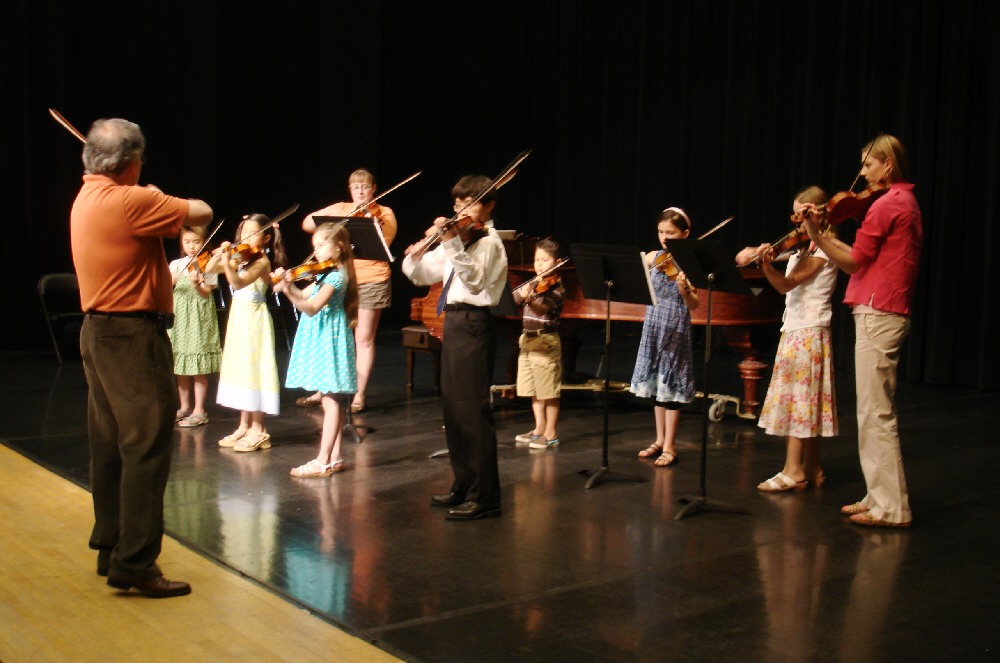 A Suzuki violin recital with students of varying ages The incorporation of music into general education from preschool to post secondary education, is common in North America and Europe. Involvement in playing and singing music is thought to teach basic skills such as concentration, counting, listening, and cooperation while also promoting understanding of language, improving the ability to recall information, and creating an environment more conducive to learning in other areas.[150] In elementary schools, children often learn to play instruments such as the recorder, sing in small choirs, and learn about the history of Western art music and traditional music. Some elementary school children also learn about popular music styles. In religious schools, children sing hymns and other religious music. In secondary schools (and less commonly in elementary schools), students may have the opportunity to perform in some types of musical ensembles, such as choirs (a group of singers), marching bands, concert bands, jazz bands, or orchestras. In some school systems, music lessons on how to play instruments may be provided. Some students also take private music lessons after school with a singing teacher or instrument teacher. Amateur musicians typically learn basic musical rudiments (e.g., learning about musical notation for musical scales and rhythms) and beginner- to intermediate-level singing or instrument-playing techniques. At the university level, students in most arts and humanities programs can receive credit for taking a few music courses, which typically take the form of an overview course on the history of music, or a music appreciation course that focuses on listening to music and learning about different musical styles. In addition, most North American and European universities have some types of musical ensembles that students in arts and humanities are able to participate in, such as choirs, marching bands, concert bands, or orchestras. The study of Western art music is increasingly common outside of North America and Europe, such as the Indonesian Institute of the Arts in Yogyakarta, Indonesia, or the classical music programs that are available in Asian countries such as South Korea, Japan, and China. At the same time, Western universities and colleges are widening their curriculum to include music of non-Western cultures, such as the music of Africa or Bali (e.g. Gamelan music). Institutional 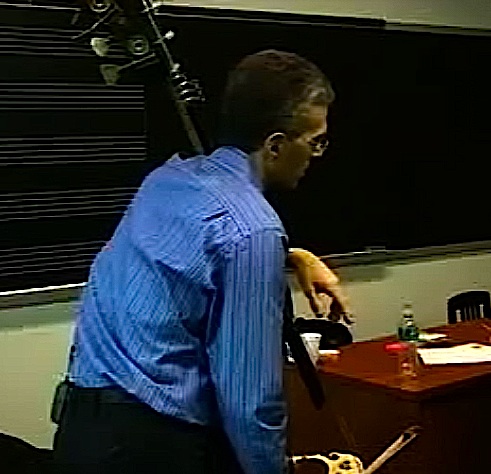 Manhattan School of Music professor and professional double bass player Timothy Cobb teaching a bass lesson in the late 2000s. His bass has a low C extension with a metal "machine" with buttons for playing the pitches on the extension. People aiming to become professional musicians, singers, composers, songwriters, music teachers and practitioners of other music-related professions such as music history professors, sound engineers, and so on study in specialized post-secondary programs offered by colleges, universities and music conservatories. Some institutions that train individuals for careers in music offer training in a wide range of professions, as is the case with many of the top U.S. universities, which offer degrees in music performance (including singing and playing instruments), music history, music theory, music composition, music education (for individuals aiming to become elementary or high school music teachers) and, in some cases, conducting. On the other hand, some small colleges may only offer training in a single profession (e.g., sound recording). While most university and conservatory music programs focus on training students in classical music, there are universities and colleges that train musicians for careers as jazz or popular music musicians and composers, with notable U.S. examples including the Manhattan School of Music and the Berklee College of Music. Two schools in Canada which offer professional jazz training are McGill University and Humber College. Individuals aiming at careers in some types of music, such as heavy metal music, country music or blues are unlikely to become professionals by completing degrees or diplomas. Instead, they typically learn about their style of music by singing or playing in bands (often beginning in amateur bands, cover bands and tribute bands), studying recordings on DVD and the Internet, and working with already-established professionals in their style of music, either through informal mentoring or regular music lessons. Since the 2000s, the increasing popularity and availability of Internet forums and YouTube "how-to" videos have enabled singers and musicians from metal, blues and similar genres to improve their skills. Many pop, rock and country singers train informally with vocal coaches and voice teachers.[151][152] |
教育 さらに詳しい情報 音楽教育 教育機関以外  様々な年齢の生徒が参加するスズキ・バイオリン・リサイタル 北米やヨーロッパでは、就学前教育から中等教育後教育まで、一般的な教育に音楽を取り入れることが一般的である。音楽を演奏したり歌ったりすることは、集 中力、数え方、聴き方、協調性などの基本的なスキルを教えるだけでなく、言語の理解を促し、情報を思い出す能力を向上させ、他の分野での学習をより助長す る環境を作ると考えられている[150]。小学校では、子どもたちはしばしばリコーダーなどの楽器の演奏、小さな合唱団での歌唱、西洋の芸術音楽や伝統音 楽の歴史について学ぶ。また、ポピュラー音楽のスタイルについて学ぶ小学生もいる。宗教学校では、賛美歌やその他の宗教音楽を歌う。中学校では(小学校で はあまり見られないが)、合唱団(歌手グループ)、マーチングバンド、コンサートバンド、ジャズバンド、オーケストラなど、いくつかの種類の音楽アンサン ブルで演奏する機会がある。学校システムによっては、楽器の演奏方法に関する音楽レッスンが提供されることもある。また、放課後に歌の先生や楽器の先生か ら音楽の個人レッスンを受ける生徒もいる。アマチュア・ミュージシャンは通常、基本的な音楽の初歩(音階やリズムの記譜法を学ぶなど)と、初級から中級レ ベルの歌唱法や楽器演奏法を学びます。 大学レベルでは、ほとんどの芸術・人文系プログラムの学生が、音楽の授業をいくつか履修することで単位を取得することができます。このような授業は、音楽 の歴史に関する概説コースや、音楽を聴き、さまざまな音楽スタイルについて学ぶことに重点を置いた音楽鑑賞コースといった形式が一般的です。さらに、北米 や欧州のほとんどの大学には、合唱団、マーチングバンド、コンサートバンド、オーケストラなど、文系の学生が参加できる音楽アンサンブルがあります。イン ドネシアのジョグジャカルタにあるインドネシア芸術大学や、韓国、日本、中国などのアジア諸国にあるクラシック音楽プログラムなど、北米やヨーロッパ以外 でも西洋の芸術音楽を学ぶ機会が増えている。同時に、欧米の大学やカレッジは、アフリカやバリの音楽(ガムラン音楽など)など、非欧米文化の音楽を取り入 れるカリキュラムを広げている。 教育機関  マンハッタン音楽院の教授であり、プロのコントラバス奏者でもあるティモシー・コブが2000年代後半に行ったベース・レッスン。彼のベースにはローCの エクステンションがあり、エクステンション上の音程を演奏するためのボタンが付いた金属製の「機械」が付いている。 プロの音楽家、歌手、作曲家、作詞家、音楽教師、音楽史の教授、音響技師など、その他の音楽関連の職業を目指す人々は、大学や音楽院が提供する中等教育後 の専門課程で学びます。米国の一流大学の多くがそうであるように、音楽演奏(歌唱や楽器演奏を含む)、音楽史、音楽理論、作曲、音楽教育(小学校や高校の 音楽教師を目指す人向け)、場合によっては指揮の学位を提供しているように、音楽の職業に就くための人材を育成する機関の中には、幅広い職業の訓練を提供 しているところもあります。一方、小規模な大学の中には、単一の職業(例えば、サウンドレコーディング)のトレーニングしか提供していない場合もありま す。 ほとんどの大学や音楽院の音楽プログラムは、クラシック音楽の学生を養成することに重点を置いていますが、ジャズやポピュラー音楽のミュージシャンや作曲 家として活躍する音楽家を養成する大学やカレッジもあり、米国ではマンハッタン音楽院やバークリー音楽院などが有名です。カナダでは、マギル大学とハン バーカレッジの2校が、プロのジャズトレーニングを提供しています。ヘビーメタルミュージック、カントリーミュージック、ブルースなど、音楽の種類によっ ては、学位やディプロマを取得してもプロになれる可能性は低い。その代わりに、バンドで歌ったり演奏したり(多くの場合、アマチュアバンド、カバーバン ド、トリビュートバンドから始まる)、DVDやインターネットで録音を研究したり、非公式な指導や定期的な音楽レッスンを通じて、その音楽スタイルですで に確立されたプロと仕事をすることによって、その音楽スタイルについて学ぶのが一般的である。2000年代以降、インターネット・フォーラムや YouTubeの "ハウツー "ビデオがますます普及し、利用できるようになったことで、メタルやブルース、同様のジャンルのシンガーやミュージシャンがスキルを向上させることができ るようになった。多くのポップス、ロック、カントリー歌手は、ヴォーカルコーチやヴォイス教師と非公式にトレーニングを行っている[151][152]。 |
| Academic study Musicology Main article: Musicology Musicology, the academic study of music, is studied in universities and music conservatories. The earliest definitions from the 19th century defined three sub-disciplines of musicology: systematic musicology, historical musicology, and comparative musicology or ethnomusicology. In 2010-era scholarship, one is more likely to encounter a division into music theory, music history, and ethnomusicology. Research in musicology has often been enriched by cross-disciplinary work, for example in the field of psychoacoustics. The study of music of non-Western cultures, and cultural study of music, is called ethnomusicology. Students can pursue study of musicology, ethnomusicology, music history, and music theory through different types of degrees, including bachelor's, master's and PhD.[153][154][155] Music theory Main article: Music theory Music theory is the study of music, generally in a highly technical manner outside of other disciplines. More broadly it refers to any study of music, usually related in some form with compositional concerns, and may include mathematics, physics, and anthropology. What is most commonly taught in beginning music theory classes are guidelines to write in the style of the common practice period, or tonal music. Theory, even of music of the common practice period, may take other forms.[156] Musical set theory is the application of mathematical set theory to music, first applied to atonal music. Speculative music theory, contrasted with analytic music theory, is devoted to the analysis and synthesis of music materials, for example tuning systems, generally as preparation for composition.[157] Zoomusicology Main article: Zoomusicology Zoomusicology is the study of the music of non-human animals, or the musical aspects of sounds produced by non-human animals. As George Herzog (1941) asked, "do animals have music?" François-Bernard Mâche's Musique, mythe, nature, ou les Dauphins d'Arion (1983), a study of "ornitho-musicology" using a technique of Nicolas Ruwet's Language, musique, poésie (1972) paradigmatic segmentation analysis, shows that bird songs are organised according to a repetition-transformation principle. Jean-Jacques Nattiez (1990), argues that "in the last analysis, it is a human being who decides what is and is not musical, even when the sound is not of human origin. If we acknowledge that sound is not organised and conceptualised (that is, made to form music) merely by its producer, but by the mind that perceives it, then music is uniquely human."[158] Ethnomusicology Main article: Ethnomusicology 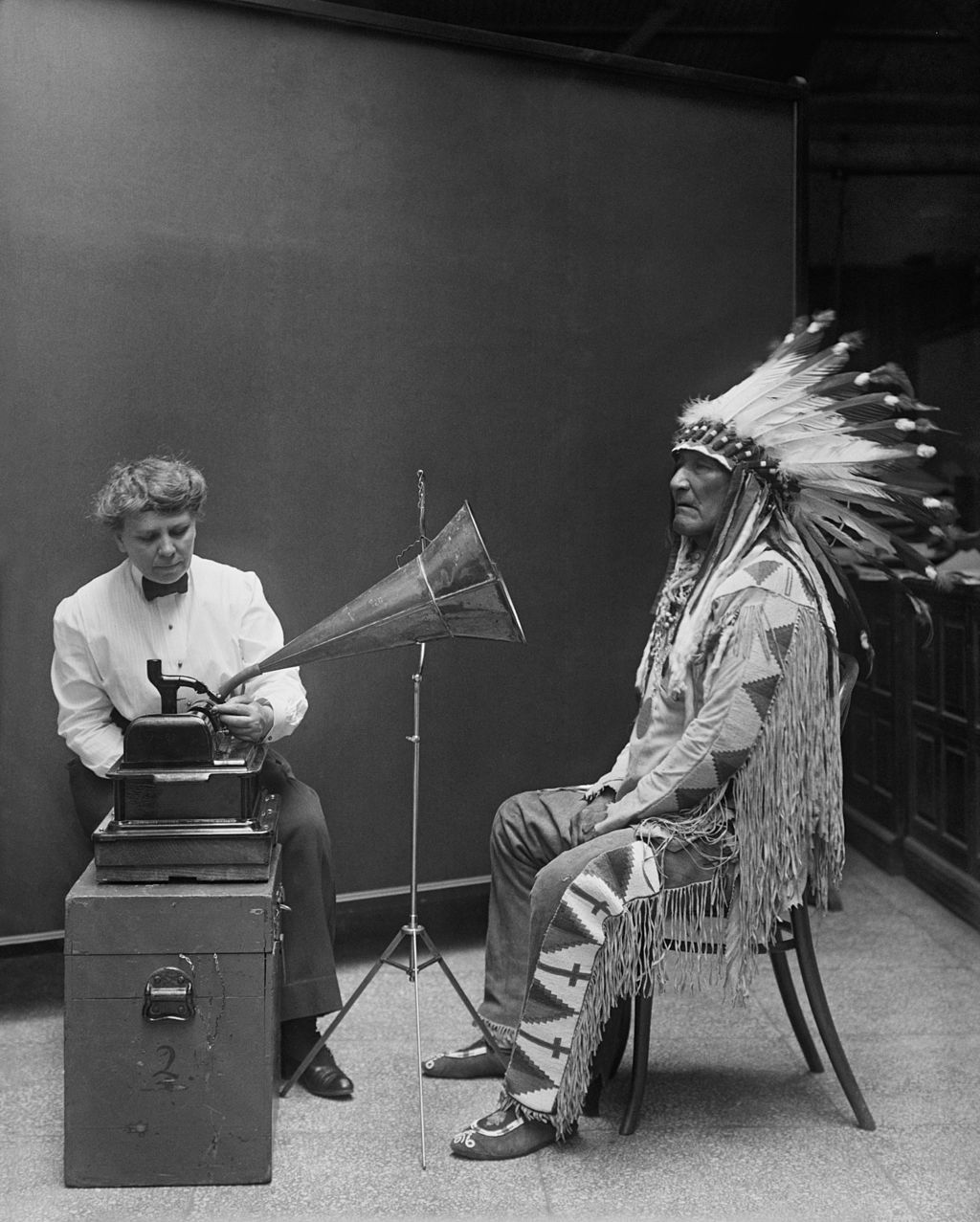 Ethnomusicologist Frances Densmore recording Blackfoot chief Mountain Chief for the Bureau of American Ethnology (1916) In the West, much of the history of music that is taught deals with the Western civilization's art music, known as classical music. The history of music in non-Western cultures ("world music" or the field of "ethnomusicology") is also taught in Western universities. This includes the documented classical traditions of Asian countries outside the influence of Western Europe, as well as the folk or indigenous music of various other cultures. Popular or folk styles of music in non-Western countries varied from culture to culture, and period to period. Different cultures emphasised different instruments, techniques, singing styles and uses for music. Music has been used for entertainment, ceremonies, rituals, religious purposes and for practical and artistic communication. Non-Western music has also been used for propaganda purposes, as was the case with Chinese opera during the Cultural Revolution. There is a host of music classifications for non-Western music, many of which are caught up in the argument over the definition of music. Among the largest of these is the division between classical music (or "art" music), and popular music (or commercial music – including non-Western styles of rock, country, and pop music-related styles). Some genres do not fit neatly into one of these "big two" classifications, (such as folk music, world music, or jazz-related music). As world cultures have come into greater global contact, their indigenous musical styles have often merged with other styles, which produces new styles. For example, the United States bluegrass style contains elements from Anglo-Irish, Scottish, Irish, German and African instrumental and vocal traditions, which were able to fuse in the United States' multi-ethnic "melting pot" society. Some types of world music contain a mixture of non-Western indigenous styles with Western pop music elements. Genres of music are determined as much by tradition and presentation as by the actual music. Some works, like George Gershwin's Rhapsody in Blue, are claimed by both jazz and classical music, while Gershwin's Porgy and Bess and Leonard Bernstein's West Side Story are claimed by both opera and the Broadway musical tradition. Many music festivals for non-Western music, include bands and singers from a particular musical genre, such as world music.[159][160] Indian music, for example, is one of the oldest and longest living types of music, and is still widely heard and performed in South Asia, as well as internationally (especially since the 1960s). Indian music has mainly three forms of classical music, Hindustani, Carnatic, and Dhrupad styles. It has also a large repertoire of styles, which involve only percussion music such as the talavadya performances famous in South India. |
学術研究 音楽学 主な記事 音楽学 音楽学は音楽の学問であり、大学や音楽院で研究されている。19世紀の初期の定義では、音楽学には系統音楽学、歴史音楽学、比較音楽学または民族音楽学と いう3つの下位学問分野が定義されていた。2010年代の研究では、音楽理論、音楽史、民族音楽学に分けられることが多い。音楽学の研究は、例えば音響心 理学の分野など、しばしば学際的な研究によって充実してきた。非西洋文化の音楽研究、および音楽の文化研究は、民族音楽学と呼ばれています。学生は学士 号、修士号、博士号などさまざまな種類の学位を通じて、音楽学、民族音楽学、音楽史、音楽理論の研究を追求することができる[153][154] [155]。 音楽理論 主な記事 音楽理論 音楽理論(おんがくりろん)とは、音楽に関する学問であり、一般的には他の学問分野とは異なる高度に専門的な学問である。より広義には、音楽に関するあら ゆる学問を指し、通常は作曲に関わる何らかの形で関連しており、数学、物理学、人類学も含まれることがある。音楽理論の初級クラスで最も一般的に教えられ ているのは、一般的な練習曲のスタイル、つまり調性音楽のスタイルで書くためのガイドラインである。音楽集合論は、数学の集合論を音楽に応用したもので、 最初は無調音楽に対して適用された。分析的音楽理論とは対照的に、投機的音楽理論は、一般的に作曲の準備として、例えば調律システムのような音楽素材の分 析と合成に専念している[157]。 ズーム音楽学 主な記事 ズーム音楽学 動物音楽学(Zoomusicology)とは、人間以外の動物の音楽、あるいは人間以外の動物が発する音の音楽的側面を研究する学問である。ジョージ・ ヘルツォーク(1941年)が "動物に音楽はあるのか?"と問いかけたように。François-Bernard Mâcheの『Musique, mythe, nature, ou les Dauphins d'Arion』(1983年)は、Nicolas Ruwetの『Language, musique, poésie』(1972年)のパラダイム分節分析の手法を用いた「鳥類音楽学」の研究で、鳥の鳴き声が反復-変容の原理に従って組織化されていることを 示している。Jean-Jacques Nattiez (1990)は、「何が音楽的で、何が音楽的でないかを決めるのは人間である。音は、単にその製作者によってではなく、それを知覚する心によって組織化さ れ、概念化される(つまり、音楽を形成するように作られる)ことを認めるならば、音楽は唯一無二の人間的なものである」[158]。 民族音楽学 主な記事 民族音楽学  アメリカ民族学局のためにブラックフットの族長マウンテンチーフをレコーディングする民族音楽学者フランシス・デンスモア(1916年) 欧米では、音楽の歴史の多くは、クラシック音楽として知られる西洋文明の芸術音楽を扱っている。非西洋文化圏の音楽史(「ワールドミュージック」または 「民族音楽学」)も、西洋の大学で教えられている。これには、西ヨーロッパの影響下にないアジア諸国の文書化された古典的伝統や、他のさまざまな文化の民 俗音楽または土着音楽が含まれる。非西洋諸国におけるポピュラー音楽や民族音楽のスタイルは、文化や時代によってさまざまである。文化によって重視される 楽器、技法、歌い方、音楽の用途も異なる。音楽は娯楽、儀式、儀礼、宗教的な目的、そして実用的で芸術的なコミュニケーションのために使われてきた。文化 大革命時の中国オペラのように、非西洋音楽がプロパガンダ目的に使われたこともある。 非西洋音楽の分類は数多くあり、その多くは音楽の定義をめぐる議論に巻き込まれている。中でも最も大きなものは、クラシック音楽(または「芸術」音楽)と ポピュラー音楽(または商業音楽-ロック、カントリー、ポップミュージック関連の非西洋的スタイルを含む)の区分である。ジャンルによっては、この「大き な2つの分類」のどちらかにきれいに収まらないものもある(民族音楽、ワールド・ミュージック、ジャズ関連音楽など)。 世界の文化がよりグローバルに接触するようになると、その土着の音楽スタイルが他のスタイルと融合し、新しいスタイルが生まれることがよくある。例えば、 米国のブルーグラス・スタイルには、アングロ・アイリッシュ、スコットランド、アイルランド、ドイツ、アフリカの楽器やヴォーカルの伝統の要素が含まれて おり、これらは米国の多民族「のるつぼ」社会で融合することができた。ワールド・ミュージックの中には、非西洋的な土着のスタイルと西洋的なポップ・ ミュージックの要素が混ざり合ったものもある。音楽のジャンルは、実際の音楽と同様に、伝統やプレゼンテーションによって決定される。ジョージ・ガーシュ ウィンの『ラプソディー・イン・ブルー』のように、ジャズとクラシックの両方が主張している作品もあれば、ガーシュウィンの『ポーギーとベス』やレナー ド・バーンスタインの『ウエスト・サイド物語』は、オペラとブロードウェイ・ミュージカルの両方の伝統が主張している。非西洋音楽の音楽祭の多くには、 ワールド・ミュージックのような特定の音楽ジャンルのバンドや歌手が含まれている[159][160]。 例えばインド音楽は、最も古く、最も長く存続している音楽の種類の一つであり、(特に1960年代以降)国際的にだけでなく、南アジアでもいまだに広く聴 かれ、演奏されている。インド音楽には、主にヒンドゥスターニ様式、カルナティック様式、ドゥルパド様式の3つの古典音楽がある。また、南インドで有名な タラヴァディヤ演奏のような打楽器だけのスタイルも数多くある。 |
| Therapy Main article: Music therapy 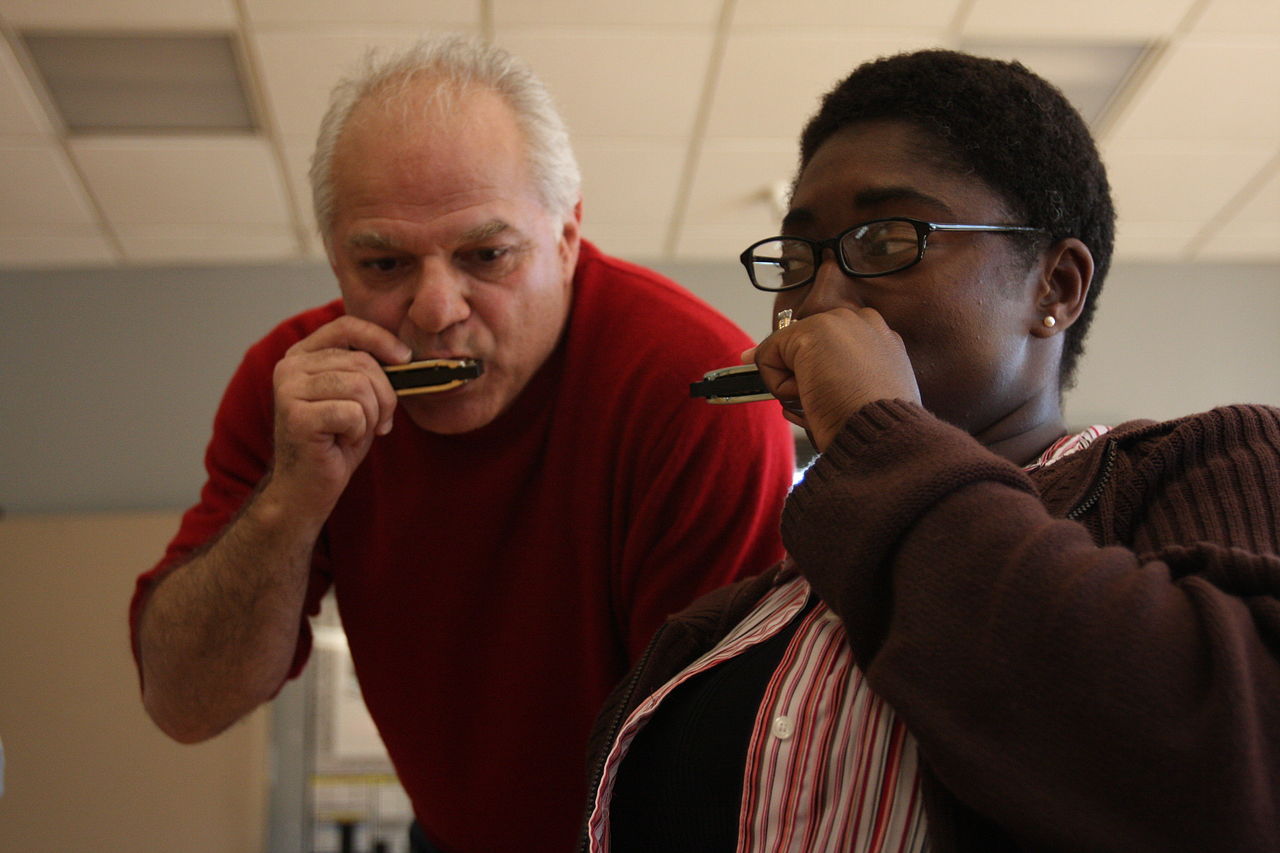 A music therapist from a "Blues in the Schools" program plays harmonica with a US Navy sailor at a Naval Therapy Center. Music therapy is an interpersonal process in which a trained therapist uses music and all of its facets—physical, emotional, mental, social, aesthetic, and spiritual—to help clients to improve or maintain their health. In some instances, the client's needs are addressed directly through music; in others they are addressed through the relationships that develop between the client and therapist. Music therapy is used with individuals of all ages and with a variety of conditions, including: psychiatric disorders, medical problems, physical disabilities, sensory impairments, developmental disabilities, substance abuse issues, communication disorders, interpersonal problems, and aging. It is also used to improve learning, build self-esteem, reduce stress, support physical exercise, and facilitate a host of other health-related activities. Music therapists may encourage clients to sing, play instruments, create songs, or do other musical activities. In the 10th century, the philosopher Al-Farabi described how vocal music can stimulate the feelings and souls of listeners.[161] Music has long been used to help people deal with their emotions. In the 17th century, the scholar Robert Burton's The Anatomy of Melancholy argued that music and dance were critical in treating mental illness, especially melancholia.[162] He noted that music has an "excellent power ...to expel many other diseases" and he called it "a sovereign remedy against despair and melancholy." He pointed out that in Antiquity, Canus, a Rhodian fiddler, used music to "make a melancholy man merry, ...a lover more enamoured, a religious man more devout."[163][164][165] In the Ottoman Empire, mental illnesses were treated with music.[166] In November 2006, Michael J. Crawford and his colleagues also found that music therapy helped schizophrenic patients.[167][168] |
セラピー 詳細は音楽療法を参照  「ブルース・イン・ザ・スクール」プログラムの音楽療法士が、海軍セラピーセンターで米海軍の水兵とハーモニカを演奏している。 音楽療法とは、訓練を受けた療法士が音楽と、その物理的、感情的、精神的、社会的、審美的、そして精神的な側面をすべて活用し、クライアントの保健の改善 や維持を支援する対人プロセスである。場合によっては、クライアントのニーズは音楽を通じて直接的に扱われる。また、クライアントとセラピストの間に築か れる関係を通じて扱われる場合もある。音楽療法は、あらゆる年齢の個人を対象とし、精神疾患、医学的問題、身体障害、感覚障害、発達障害、薬物乱用問題、 コミュニケーション障害、対人関係の問題、老化など、さまざまな状態に対して用いられる。また、学習能力の向上、自尊心の育成、ストレスの軽減、運動のサ ポート、その他多くの保健関連活動の促進にも用いられる。音楽療法士は、クライアントに歌を歌ったり、楽器を演奏したり、曲を作ったり、その他の音楽活動 を行うよう勧めることもある。 10世紀には、哲学者アル・ファラービーが、声楽が聴く人の感情や魂を刺激する方法について記述している。[160] 音楽は、人々が感情に対処するのを助けるために長い間用いられてきた。17世紀には、学者ロバート・バートン著『憂鬱の解剖学』が、音楽と舞踏は特に憂鬱 症などの精神疾患の治療に極めて重要であると論じた。[161] バートンは、音楽には「多くの病を追い払う優れた力」があり、音楽は「絶望と憂鬱に対する最高の治療薬」であると述べた。古代では、ロードス島のバイオリ ン奏者カヌスが音楽を用いて「憂鬱な男を陽気にし、恋人をより熱愛させ、信心深い男をより信心深くさせた」と指摘した。[162][163][1 164] オスマン帝国では、精神疾患は音楽療法で治療されていた。[165] 2006年11月には、マイケル・J・クロフォード氏とその同僚も、音楽療法が統合失調症患者に役立つことを発見した。[166][167] |
| Glossary of music terminology Lists of musicians List of musicology topics Music and emotion Music archaeology Music history Music-specific disorders |
音楽用語集 音楽家一覧 音楽学のトピック一覧 音楽と感情 音楽考古学 音楽史 音楽特有の障害 |
| https://en.wikipedia.org/wiki/Music |
|
| ★音楽人類学・民族音楽学▶︎音楽と感情▶音楽・身 体・芸術︎︎▶いわゆる「食いつき力」について︎▶︎︎音楽と時間性▶音楽の文化研究︎▶︎︎ポリフォニー▶︎聴覚のチーズケーキとしての音楽▶プエルトリコの音楽▶︎マヤ・マリンバ音楽用語集▶サルサ音楽の歴史︎︎▶︎世 界音楽化▶ピタゴラスと音楽︎︎▶︎音楽とナショナリズム▶コール&レスポンス︎︎▶︎進化音楽学▶ラップ音楽 ︎︎▶︎宗教と音楽性▶︎︎北米のフォーク・ミュージック・アンソロジー▶︎音楽美学批判▶日本におけるキリスト教布教と西洋音楽の導入︎︎▶︎プエルトリコの抵抗の音▶︎︎皆川達夫の研究▶︎ラップ音楽・黒人アイデンティティ・身体経験▶︎︎クレズマー音楽▶︎ラッ プ音楽におけるミソジニー▶︎︎メレンゲ音楽▶︎ガリフナの人と音楽経験▶︎︎歌うネアンデルタールとスティヴン・ミズン▶︎ニーチェと音楽▶ポストヴァナキュラーな音楽としてのクレズマー︎︎▶︎君もラッパーになれる!!▶︎︎ギャングス タ・ラップからナルコ・コリードまで▶︎グレン・グールド▶︎︎ロバート・ラッハマン▶︎記 憶=記録の悪魔▶キリスト教のカントール︎︎▶︎ラテン・ヒップ・ポップ▶レゲトンとデムボウ︎︎▶ルベン・ブラデス︎▶︎︎ラ ファエル・トルヒージョと『チボの祝宴』▶︎キングヘロイン▶音響的な世界︎︎▶マーレー・シェイファーとサウンドスケープ︎▶︎︎カート・コバーンとその生涯▶︎ドミートリイ・ショスタコーヴィチ▶セリア・クルス︎▶︎エクトル・ラ ボ▶カノ・エストレメーラ︎︎▶︎ワールドミュージックとグローバリゼーション▶︎︎▶ |
ユーチューブ(演奏リスト)
リ ンク
文 献
そ の他の情報
Copyleft, CC, Mitzub'ixi Quq Chi'j, 1996-2099
☆
 ☆
☆